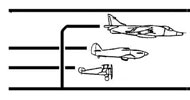The week by week story of the Sopwith Aviation Company and its products through 1916
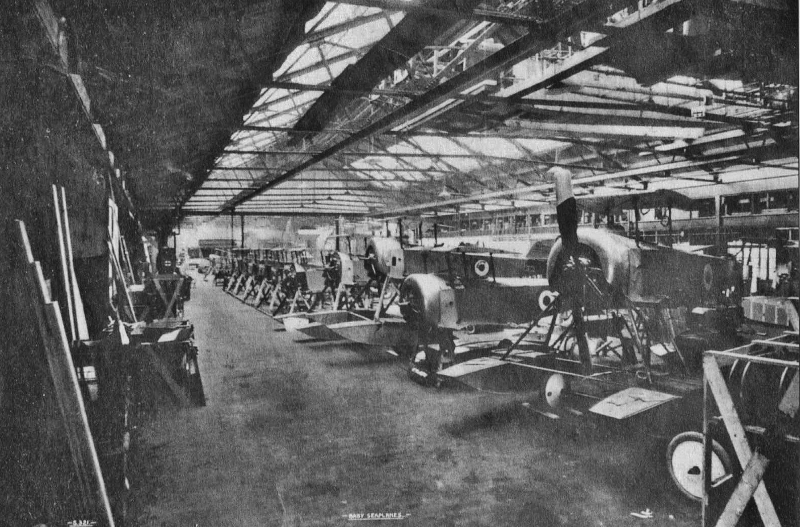
The Sopwith Aviation Company starts 1916 with its Kingston factory full of Sopwith Baby floatplanes, the first five in this photograph fitted with their 110hp Clerget engines ready for delivery. The other six are apparently complete waiting for floats and engines.
This photograph shows the full length of the factory along the north side of Canbury Park Road. The offices are on the left and there is a two-storey Saw Mill and Carpenters Shop behind the photographer. Ide and Son are building a 20,000 sq ft two-storey workshop extension behind the wall on the right which includes a Doping Shop and a Garage.
One hundred yards up the road in the experimental workshop in the old Roller Skating Rink Tommy Sopwith has taken the risk to start building two more of the 110hp “LCT 1½ Strutter” two-seat landplanes. There must be great confidence in that design after the initial flight testing of the prototype at Brooklands. In another private venture they are also working on a single-seat 80hp scout combining the best features of Harry Hawker’s 50hp “SLTBP” runabout and the “LCT 1½ Strutter”.
The “LCT” is the first design to carry the name of Herbert Smith, now Chief Designer, but both new types owe much to previous designs by Harry Hawker and Fred Sigrist and the contribution of new ideas from them, from Tommy Sopwith and from the small but experienced drawing office and experimental workshop teams.
At least six December built new “Schneider” floatplanes Nos.3770 to 3775 have been rushed to seaplane carrier HMS Empress and by 3rd January 1916 are on their way to the East Indies and Egypt Seaplane Squadron (EI&ESS) at Port Said. Since 1914 the Royal Navy has been using Nieuport VI monoplane floatplanes in collaboration with the French when attacking Turkish supply lines around the Eastern Mediterranean.
Meanwhile the first completely new “Type 806” pusher gunbus No. 3836 built under sub-contact by Robey & Sons of Lincoln has been tested and accepted by Sopwith at Brooklands and on 3rd January is delivered to RNAS Detling in Kent. That same day Fl Sub Lt D E Smith damages the chassis and propeller.
On 5th January one of the only two remaining 80hp Sopwith “D3 Daily Mail Spinning Jenny” two seat landplanes No.1072 is damaged at Eastchurch.
Also on 5th January “Baby” floatplane No.8121 originally delivered to Dover in October but recently sent dismantled to the RNAS Central Store Depot at White City is recorded on strength at Westgate whilst No. 8142 is tested at Killingholme almost a month after it arrived there for erection. Nos. 8147 & 8154 are tested by Sydney Pickles at Killingholme and Nos. 8146, 8151 & 8158 are tested and accepted by Harry Hawker at Grain.
On 6th January new “Baby” No.8160 is delivered to Grain and is accepted on 7th January by Harry Hawker along with No.8144 which was delivered there a month ago. Also on 7th January “Baby” floatplanes Nos.8161 & 8162 are delivered to Killingholme and on 8th January Nos.8165 & 8166 arrive at Felixstowe and are tested.
Overnight on 8th & 9th January 1916 the last Allied troops are withdrawn from the Gallipoli Peninsula. These are mostly British troops from Cape Helles who were amongst the first to arrive in late April and have been contained there by Turkish forces ever since. In contrast to the original invasions and some 200,000 allied casualties in this conflict, the carefully planned withdrawal backed up by naval bombardment and RNAS aerial support once again works perfectly. The Royal Navy are to remain in the area to prevent the German battlecruiser Goeben and her escort passing back through the Dardanelles Straights into the Mediterranean.
Reports of Mrs Murray Sueter’s RNAS Comforts Fund confirm that at Christmas Sopwith employees collected another £6 7s 2d to accompany a £50 donation by the Directors. Now the employees entertain the directors at a dinner which makes another £20 1s 9d for warm clothing and other “comforts” for those operating their floatplanes around the coast, in northern France and in the Mediterranean.
On Sunday 9th January 1916 Connie Webb records in her diary that there was a “Sopwith water plane by the Thames and everybody went down to watch”. “Irene saw her little naval lieutenant quite a lot this time, he and another officer and the airman, Hawker, sat on the seat under our wall and examined papers, and every time Irene went by (which she did fairly frequently!) they all smiled at her!”

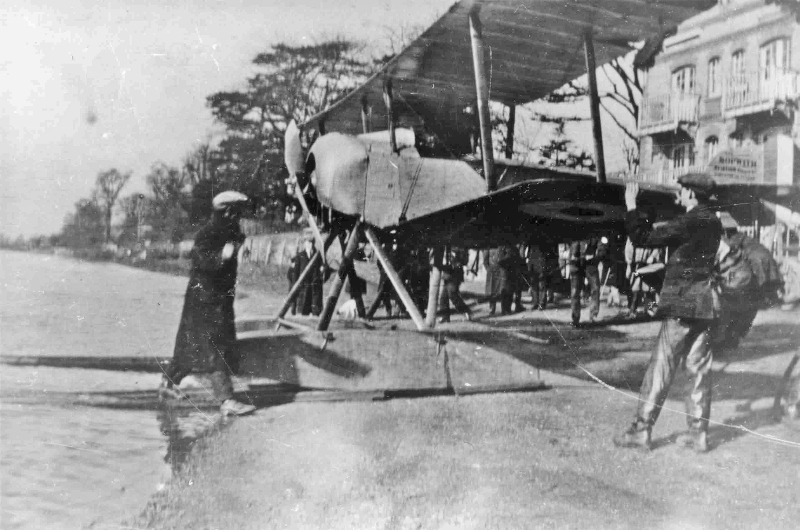
Harry Hawker with a “Baby” floatplane in front of Turk’s boathouse, the long tall wall is the Webb’s garden
On 12th January the Board of Trade Committee on Production circulates its decision on the case brought to them in November by the Aircraft Industry London District Committee of Trade Unions. They had failed to get agreement with the London area aircraft companies on a claim that all woodworkers should have a minimum wage of 1/- (1 shilling) an hour and recognised rules of working including hours of labour, overtime, notice of leaving, limitation of apprentices and improvers, travelling allowances and ticket inspection by Trade Union shop delegates. The committee’s findings after visiting various factories state that the aircraft manufacturing industry is going through a rapid increase in demand, repetitive manufacture is being established and “it is inexpedient at the present time to stereotype working rules”. “During the period of the war all that is needed is that employers and representatives of the workpeople should continue to give careful and equitable consideration to individual cases which may be found to require attention”. “Many varied companies are now involved using men they already employed on different work and most workers are getting an extra war bonus or war wages of generally not less than 4/- per week. The case for a 1/- per hour uniform minimum wage has not been established”. The London & District Association of Engineering Employers immediately acknowledges the findings. The Trade Union Committee calls a conference of all the unions involved in the aviation industry.
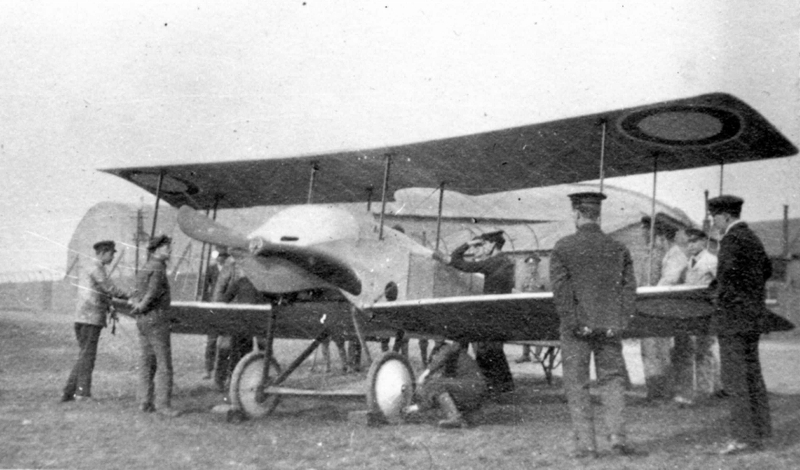
On 18th January Sopwith “SS3” Tabloid Scout No.1208 (above) which has been at Yarmouth since March 1915 suffers an engine failure and forced landing at Gorleston flown by Sq Ldr R W R Fane.
On 19th January “Schneider” No.1442 is taken to White City by road from Dover and deleted. The same had happened to No.1572 four days earlier and happens to No.3708 on 20th January.
On 20th January the hard-worked “Schneider” No.1446 flown by FSL F G D Hards is completely wrecked on landing at Yarmouth.

Since 16th January Felixstowe based “Schneider” No.3749 is back on HMS Vindex, sharing these North Sea duties with No.3755. HMS Vindex is another converted fast Isle of Man Steam Packet Company ship slightly smaller than Ben-My-Chree. Vindex has been operating out of Harwich since October. The three roller shutter doors (below with a “Schneider” inside) expose a 30ft x 18ft entrance to her five aircraft hangar built in place of the first class cabins behind the funnels. A pair of electric 5 ton cranes lower the floatplanes onto the sea from the small aft deck where space is restricted by the ship’s two 12 pounder QF guns and emergency steering position. The short forward flying off deck suffers from spray and pitching but was used by a RNAS Bristol Scout last November for the first wheeled aircraft flight from a ship.
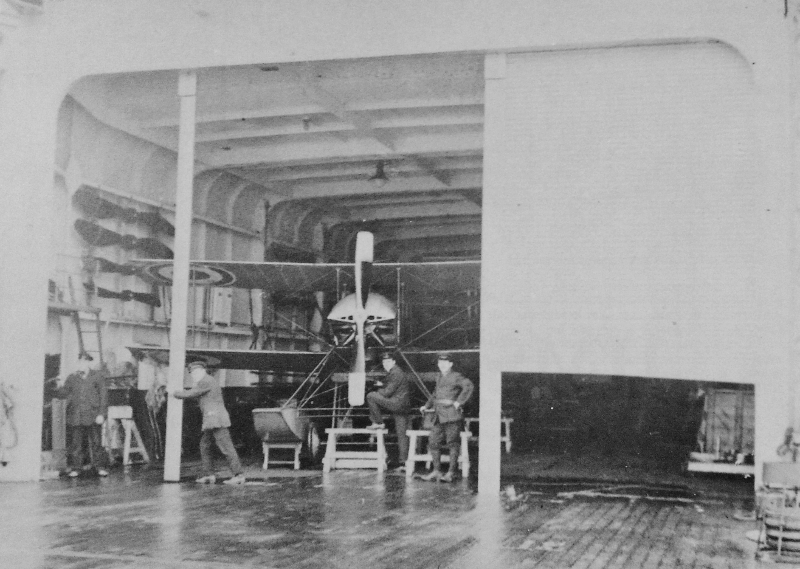
On 21st January Schneider floatplanes Nos.3772 to 3775 (and possibly 3777 & 3778) arrive at Port Said aboard HMS Empress. She is a converted South East & Chatham Railway Company cross-channel packet very similar in size, appearance and equipment to HMS Vindex. She joins seaplane carriers Ben-my-Chree, Raven 1 and Anne at the EI&ESS Squadron reporting to General Officer Commanding, Egypt. Their primary duty is to watch and attack Turkish positions and supply lines in southern Palestine and the Sinai to thwart the Turks’ plan to capture the vital Suez Canal.
On 22nd January Isle of Grain based “Schneider” No.3756 flown by FSL R M Hughes crashes and is wrecked.
Sopwith are delighted with the performance and handling of their private venture 110hp Clerget “LCT 1½ Strutter” two-seat landplane which now has provisions for a circular gun mounting in the rear cockpit.
On 24th January it is tested by the RFC at their Central Flying School at Upavon in Wiltshire. The tests are so encouraging that they continue into darkness and prompt this telegraph (below) from Experimental Speedy to Milaeronaut 2 London.
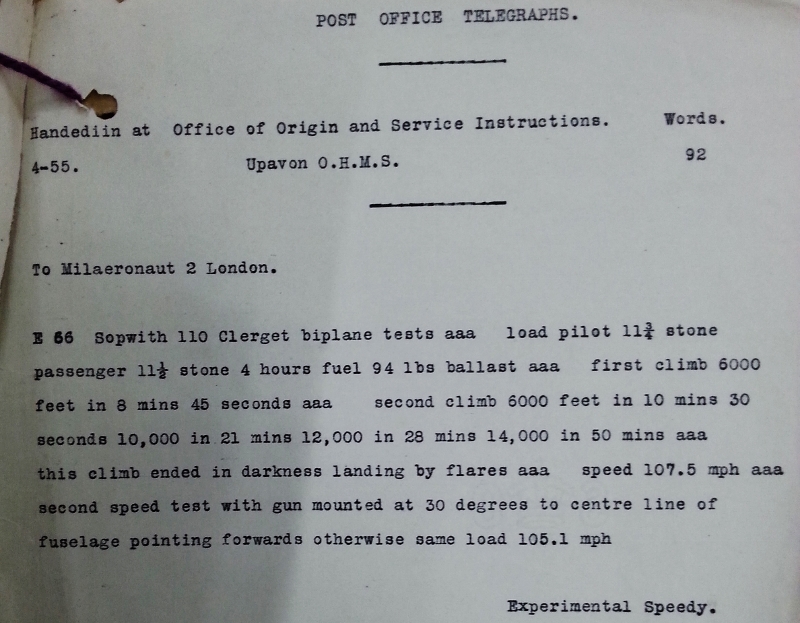
At RFC Headquarters in London they recognise that this is something special and the telegraph is immediately forwarded to Major-General Hugh Trenchard commanding the RFC Expeditionary Force in France. He is rushing two-seat FE2b and single-seat DH2 pusher fighters into service to protect his workhorse two-seaters and regain aerial supremacy in the face of the German Fokker fighters. Here is a fully loaded two-seat tractor fighter which is apparently over 12mph faster than any of those and has a four-hour duration, significantly exceeding any other fighter and most reconnaissance types. If that were not enough, it offers a unique rearward self-defence capability and, with the pilot in front, the possibility of him having an over-wing forward-firing gun or even one of the synchronised guns firing through the propeller which are urgently being developed.
On 24th January “Schneider” No.3739 at Dover since late August and fitted with an over-wing gun in October is wrecked by Fl Lt E J Cooper and immediately taken to White City CSD to be deleted. It is not a good week for Cooper. On 25th January he wrecks a Calshot “Schneider” No. 3763. He is unhurt but it too will be deleted. The good news is that new “Schneider” floatplanes Nos.3779, 3870 & 3785 arrive at Calshot that day and the next.
On 25th January at a Sopwith Board Meeting the Company Seal is affixed to the “Conveyance and Assignment of Land and Premises at Oak Bank, Woolston, Southampton to the Company” and to a “Deed of Covenant between the Company, N Pemberton Billing and N Pemberton Billing & Co Ltd.” Tommy Sopwith is investing in the property he has leased from Noel Pemberton Billing since 30th May 1914. With less than 70 “Schneider” and “Baby” machines to deliver, he must be expecting further orders for floatplanes from the Admiralty.
“Schneider” No.1447 has been in active service at Dover for eight months, has operated from H M Trawler St.Germain and has had grenade and bomb gear fitted for the last four months (photo below of bombs and release mechanisms under the cockpit floor). However on 26th January it is taken by road to the RNAS Central Stores Depot at White City and will be deleted from service.
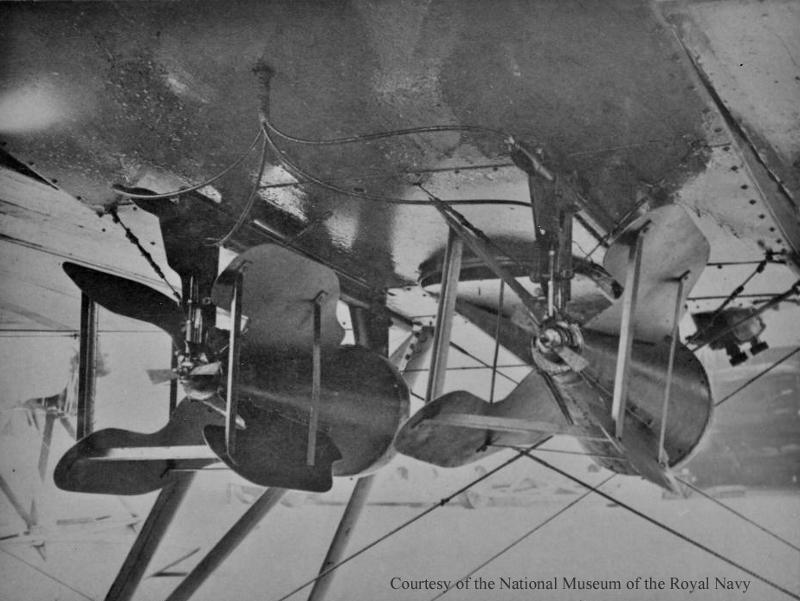
On 27th January three-month-old “Schneider” No.3758 is deleted at Westgate and on 28th January seven-month-old “Schneider No.1565” is deleted from service at Felixstowe due to “fair wear and tear”.
Meanwhile on 26th January “Baby” floatplanes Nos.8152 & 8153 are tested by Harry Hawker at Felixstowe. The next day he is at Yarmouth acceptance testing Nos.8149, 8150, 8156 & 8157 and “Schneider” No.3776. No.8149 suffers an engine failure. He stays another night to accept “Baby” floatplanes Nos.8163 & 8164 at Yarmouth on 28th January. Whilst five of these arrived very recently, four have been waiting over two weeks.
The full pro-forma report of the 24th January trials of the first Sopwith “LCT 1½ Strutter” signed by Lieutenant Colonel D Pitcher Commandant of the Central Flying School at Upavon has arrived at RFC Headquarters in London and is despatched on 29th January 1916 to Major-General Trenchard commanding the RFC in France. In the report the Basic Description includes: “Wing span 33’7”, Tail span 13’6”, Fuel 40 galls, Oil 10 galls, Weight full tanks and equipment no crew 1502 lbs”. It continues with Further Particulars: “Empenage (tailplane) is bodily adjustable from the pilot’s seat. Bombs can be carried under passenger seat without ballast and empenage adjusted after release. Bomb sight is almost impossible to use with the present wings. Passenger seat swivels with provision for a circular gun mounting. Facilities for firing by passenger: Upwards Good, Downwards Fair, To the rear Good. Planes have only one pair of outside struts and no lift wires are fitted under the bottom plane. The factor of safety would appear very low if one of these struts be shot away or damaged. Air brakes are fitted to lower planes close to fuselage. In action they cause a lot of vibration. The engine cowl is of very light metal and easily cracks and dents. The gun complete with jacket was mounted about 30ᴼ to the centre line pointing forward strapped to the circular rail. Time to prepare engine for starting: 1-2 mins.” Speed trial: “Wind: West 15 mph, Weather: Fine, Passenger: 11½ stone, Test height: 6-10 feet, Course: 4026 feet, Average speed without gun: 107.2 mph, with gun 105.1 mph, Minimum speed: about 55mph on ASI.” Climbing trials: Time to height & rate of climb over latest 1,000 feet in ft per min: 2,000ft 2mins 1,000; 4,000ft 5m5secs 670; 6,000ft 8m45s 630; 8,000ft 15m5s 385; 10.000ft 21m 310; 12,000ft 28m 285; 14,000ft 50m 63. Suggestions for improvement of design: “The machine gets off easily and quickly and is undoubtedly fast, a good climber and easy to fly. She is very nearly automatically stable; far more so than most so called stable machines other than the BE2c. The machine is easy to land but requires an abnormal amount of landing room and could only be landed by average pilots (even with air brakes on) in very large fields. The air brakes make a difference of almost 100 yards. Wheels are much too far back and would (be) certain to turn machine over in plough (sic) or heavy ground. Possibly the shifting forward would reduce landing run.”
On 28th January new “Baby” floatplanes Nos.8167 & 8168 are delivered to RNAS Isle of Grain by road.
On 29th January four new “Schneider” floatplanes Nos.3781 to 3784 are delivered to the RNAS Central Stores Depot at White City. With the higher-powered “Baby” version in production, it is possible that the 110 “Schneider” floatplanes delivered since February 1915 have satisfied the RNAS’ demand for this type, at least for now. Sopwith works’ records show 22 aircraft completed in January 1916, 11 each “Schneider” and “Baby”.
At Robey & Co the factory has recorded another five Sopwith “Type 806” Gunbuses delivered in January to the Lincoln Aircraft Acceptance Park at West Common to add to the eleven delivered there in 1915. These five are not yet in service. They may still be waiting acceptance by the Admiralty’s prime contractor, Sopwith Aviation. The wings are now being built in what was initially the curved roof aircraft assembly shed (below left) and the aircraft are being assembled in the new bay numbers 8 and 9. The view (below right) from the far end of one of those bays shows the high roof and a modern travelling gantry crane with assembled aircraft at the far end. On the right under the crane is an inverted Sopwith Gunbus fuselage with its undercarriage frame sticking upwards emphasising the size of these machines and showing why Sopwith Aviation were not able to accommodate the order for thirty of them in their relatively small factory in Kingston whilst building scores of small floatplanes.
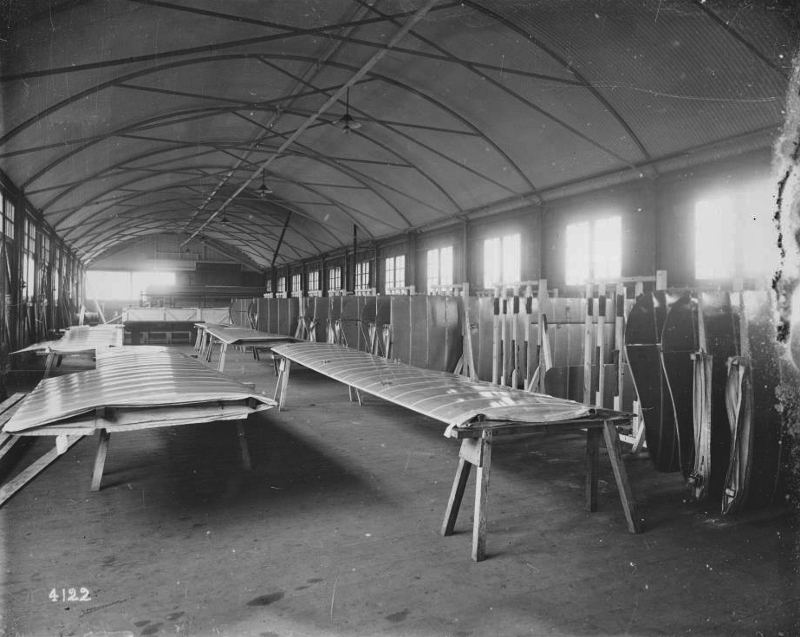
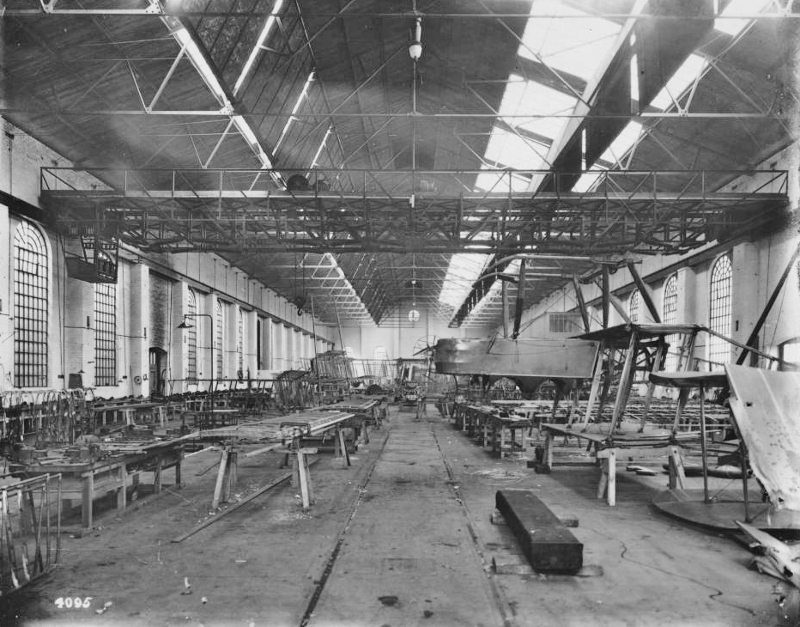
Photographs via Charles Parker
On 31st January “D3 Daily Mail Spinning Jenny” No.1073 is damaged at Eastchurch and will be deleted.
On 2nd February “Schneider” No.3790 goes to Tilbury Docks for SS Khiva which is soon leaving for Port Said.
Also 2nd February “Schneider” floatplanes Nos.3766 & 3768 which arrived at Grain late November but have probably been in store are accepted by Harry Hawker. They will be going to the Nore Flight at Westgate.
The next day Harry accepts “Baby” floatplanes Nos.8167 & 8168 at Grain. They arrived by road seven days ago.

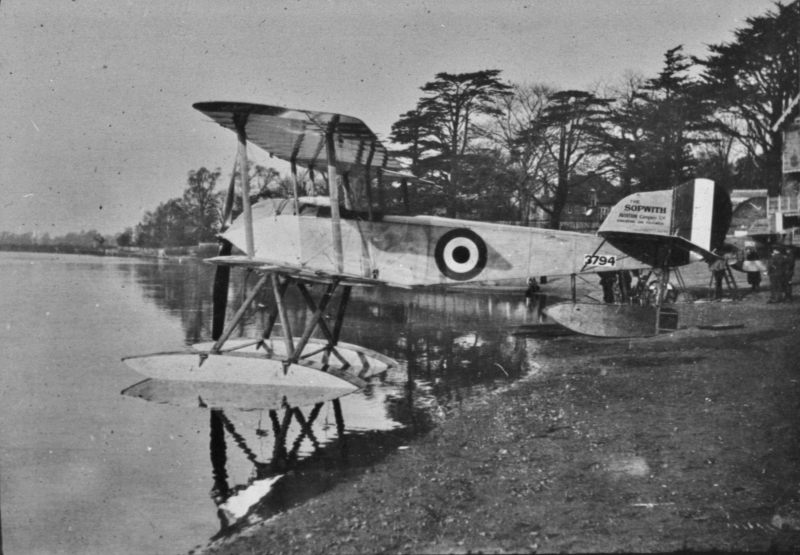
On 4th February Connie Webb records a “water plane by the Thames” in Kingston. “Schneider” No.3794 is pictured (above) at Turks Albany Boathouse showing its “Baby” style large fin and aileron flaps on all four wing tips.
On 5th February “Baby” No. 8170 is delivered to Calshot and on 6th No.8173 arrives at Yarmouth by road.
On 7th February “Schneider” No.3742 has four short trials at Port Victoria Aircraft Repair Depot at Grain but is badly out of longitudinal balance. These are probably early tests for their own experimental high lift wing.
Sopwith have wasted no time building a second 110 hp Clerget powered “LCT 1½ Strutter” two-seat landplane. It is photographed

(above left) with Harry Hawker’s 50hp “STLBP” runabout. It is flown on 7th February to Dover-based 4 Wing RNAS for trials. Sopwith have no formal contract but there must be some understanding of the Admiralty’s intent to purchase as it carries RNAS serial number 9376, the first of a reserved block of fifty.
On 7th February 1916 Director of Air Services Admiral Vaughan-Lee writes to Murray Sueter, now responsible for naval aircraft production, that “there are aircraft orders overdue for types which are hopelessly out-of-date and already useless before delivery. Their building must be stopped and the best possible terms come to, please see to it at once. Consider which machines come into this category and submit a list”. On 9th February Sueter returns a list of five “principle contracts overdue”, three orders are marked “All useful” or “All will be required” and he notes “I think it is highly creditable to my technical advisors that we have so few machines overtime and only one order a bad one”. The “bad one” is for eight Curtiss boats from the Aircraft Manufacturing Co. now a year overdue but “quite good for sea patrol work”. The fifth one is the order for the thirty 150hp Sopwith Gunbuses sub-contracted to Robey and Co. of which “eleven have been delivered and four more are undergoing trials. The contract date for completion of delivery is now four months overdue”. There is a margin note that the “Rumanian Government might have these if the Foreign Office agrees”.
On 8th February 1916 the last surviving Sopwith “D3 Daily Mail Spinning Jenny” No.1072 is completely wrecked at Eastbourne and will be deleted from service.
Also on 8th February “Baby” floatplanes Nos.8165 & 8166 arrive at Felixstowe and are tested by Harry Hawker.
Other Felixstowe based “Baby” floatplanes Nos.8152 & 8153 are now aboard HMS Vindex replacing her lower-powered “Schneider” floatplanes and with monitor HMS Havelock have attempted some shows of strength.
At around 15.40hrs on 9th February two German floatplanes are sighted by the North Goodwin lightship. Ten minutes later eight bombs are dropped on Ramsgate narrowly missing a tramcar closely followed by twelve on Broadstairs which damage a girls’ school. Three people are injured. Fl Lt E de C Hallifax in “Schneider” No.3753 from Grain and Fl Sub-Lt E J Burling in “Baby” No.8121 from Westgate are amongst the twenty-four aircraft sent up on “Hostile Seaplane Patrols” but the German machines leave before any contact can be made.
On 9th February Robey-built Sopwith “Type 806” pusher gunbus No.3841 is delivered from Brooklands to RNAS Detling followed on 10th February by Nos.3833 & 3838. The Robey factory recorded these two as completed in October before sending them to the Lincoln Aircraft Acceptance Park at West Common for testing.
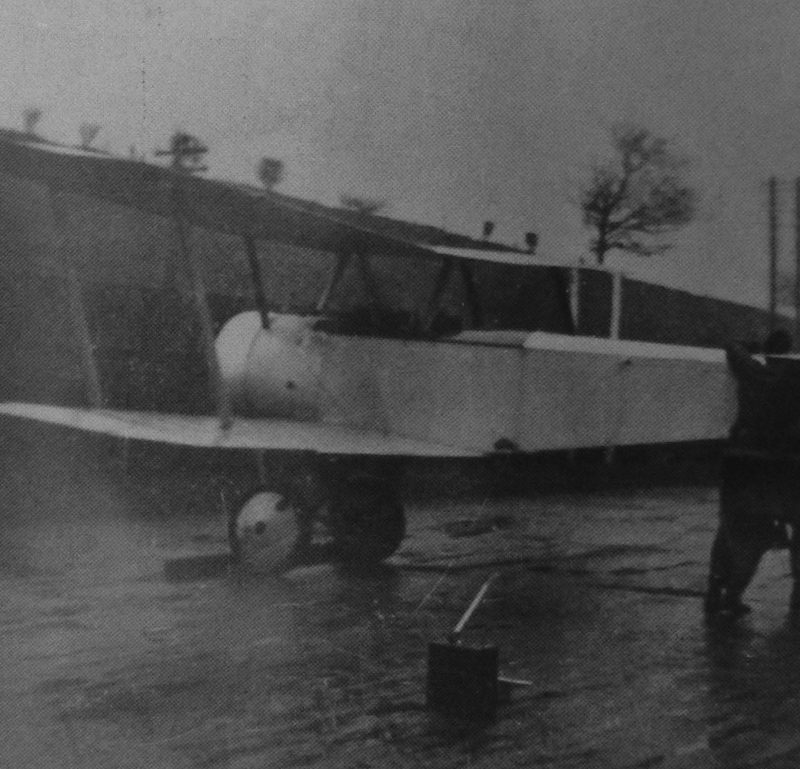
On 9th February the first “Pup” is approved by the Sopwith Experimental Department in the Old Skating Rink at Kingston and is taken to Brooklands for assembly and testing (above). Their drawings (below) show it to be very similar to Harry Hawker’s 50hp “SLTBP” runabout with the same reverse taper on the tips of wings and tailplanes but with outward-raked cabane struts like the two-seat “1½ Strutter”. Like the “1½ Strutter” this is another Sopwith private-venture design aimed at the RNAS’ need for higher performance machines which might quickly bring in factory orders to follow on from the small floatplanes. The Brooklands team start engine runs (below left) and, no doubt, look forward to test flying during breaks in the rough winter weather.
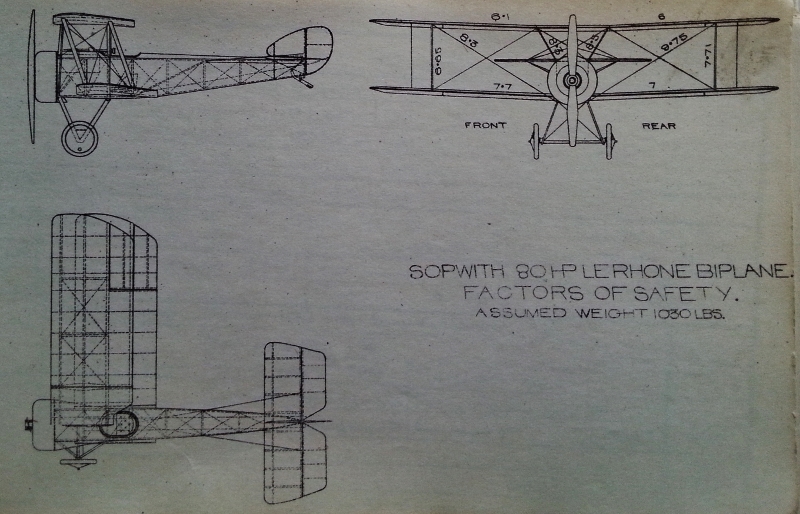
This is the first Sopwith aircraft with an 80hp Le Rhône engine. Unique features of the Le Rhône include two valves per cylinder head operated ingeniously by a single push-pull rod with external copper tubes feeding the fuel-air mixture from the crankcase to the inlet valve. Otherwise very similar to the Gnome rotary engines, Le Rhône engines are currently thought to be less reliable. However Gnome production is not matching the demand for both British and French aircraft and the last sixty-five RFC Bristol Scouts have had to switch to this 80hp Le Rhône engine whilst deliveries of the RNAS Bristol Scouts have been delayed awaiting Gnome engines. The 9 cylinder 80hp Le Rhône engine rotates around the stationary crankshaft fixed to aircraft bulkheads behind the engine. The diagrams (below) do not show the fuel feed, air feed or oil pump arrangements through the hollow crankshaft into the crankcase or the magneto and its slip-ring feeding high tension electricity to the spark plug. These are all at the rear of the engine.
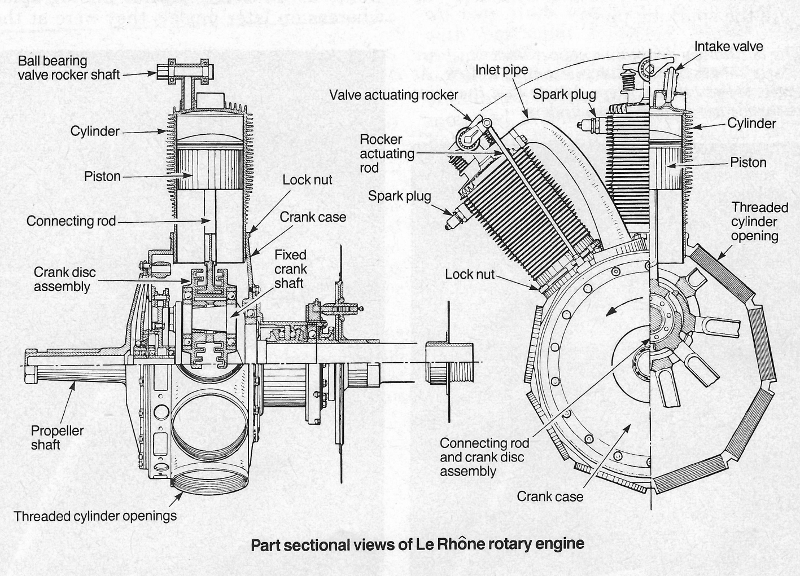


Diagrams courtesy of Aeroplane Monthly (June 1986)
On 11th February whilst “Schneider” floatplane No.3794 is tested on the Thames in Kingston, Nos.3792 & 3793 are being delivered straight to the Central Stores Depot at White City, possibly without their Gnome engines.
On 13th February Robey-built “Type 806” pusher gunbus Nos.3849 is delivered to RNAS 4 Wing at Eastchurch.
On 14th February a Sopwith Board Meeting approves documents for the purchase of 500 fully paid £1 shares in Rolls-Royce Ltd. Henry Royce and Ernest Hives have been using their 40/50 motor car experience to develop the 225hp Rolls Royce Eagle twelve-cylinder upright Vee aircraft engine for the Admiralty to compete with the 200hp Sunbeam. This has separate water jacketed cylinders and two poppet valves per cylinder with single overhead camshafts. It is a promising candidate for the larger aircraft the Sopwith team are contemplating.

On 16th February four Robey-built Sopwith “Type 806” pusher gunbuses Nos.3833, 3835, 3838 & 3841 are wrecked whilst pegged out in a gale and heavy snow at RNAS Detling in Kent. The photograph of No.3838 after the storm (above) shows the covers blown off, a collapsed undercarriage and the rear fuselage twisted with the tailplane and rudder well out of true. Three of these machines are less than a week in service and the fourth just eight weeks but all four will be deleted from service. Natural events at this recently established airfield, have resolved the RNAS’s problem of what to do with at least some these rather outdated machines.
The Third Sea Lord reveals that following the glowing test report the Admiralty have already placed a verbal order with the Sopwith Aviation Co Ltd for 50 Sopwith “LCT 1½ Strutters” which are “required for fighting the enemy’s aeroplanes at Dunkirk, Dover &c”. “The first six of these are being erected now.” He goes on to minute that at a meeting with Messrs Sopwith the Director of Contracts D.A.S. gave instructions to additionally “place an order for 100 Special Machines for long distance (as approved on 18th February)”. “A large number of wings for these machines are nearly completed.” Deliveries are to run: week commencing 21st Feb x1: 29th Feb x1: 6th Mar x2: 13th Mar x3: 20th Mar x4: 27th March x5: increasing week by week to 10 per week by the end of April and 15 per week from the end of May when 115 machines will have been delivered. “Sopwith has been instructed that nothing is to interfere with the long distance machines and the short distance machines will stand aside as soon as the material for the long distance machines is worked up.”
Sopwith have created this remarkable new two-seater just in time to follow on from their orders for the smaller “Baby” and “Schneider” floatplanes which run out in the next few weeks. Building 115 “1½ Strutters” in the next 14 weeks is, however, a tall order for the still relatively small Sopwith factory in Canbury Park Road. Tommy Sopwith speeds up the purchase of more cottages on the south side of Elm Grove and authorises the building of a third extension before the second extension is completed. Even then Fred Sigrist will have his work cut out to recruit and train enough new workers to almost triple output to 60 aircraft per month by June.
On 19th February Sopwith “Baby” floatplane No.8169 is the last to go straight into service from Woolston.
In the last 3 days four new “Baby” floatplanes Nos.8175, 8176, 8177 & 8178 have been delivered directly to the RNAS Central Store Depot at White City, their 110hp Clerget engines probably diverted to the urgently wanted “1½ Strutter” two-seaters. “Schneider” floatplane No.3794 is the latest of that type to suffer the same fate.
Connie Webb records in her diary that her accountant father “is very gloomy about the outlook especially financial and the new taxes and is trying to sell their house by the Thames in Kingston. It is the capitalists like him who suffer; the poorer classes, who can make munitions etc. are rather benefiting at the moment. Mr Headley is now like Dada a Special Constable at the Sopwith Works from 6 to 10pm. Last night he refused entry to a man who did not know the password. ‘It’s a nice thing when I cannot get into my own works!’ laughed the man. It was Sopwith himself. Mr Hawker also sometimes forgets the password but Dada lets him in.”
Around 11am on 20th February 1916 three German floatplanes make widely separated surprise hit and run attacks dropping nineteen bombs from 5-6,000 feet on Lowestoft, six on Walmer and three near channel shipping off Kent probably thinking the defences would be less alert on a Sunday morning. They cause one death, one injury and minor damage. In the largest defence response to date 29 sorties go out from Yarmouth, Eastchurch, Dover and Grain, including Sopwith “Baby” No.8145, but it is all too late despite the interception of enemy wireless telegraph transmissions 25 minutes before the first bombs. There is much confusion with so many aircraft up and the Yarmouth aircraft attract brisk anti-aircraft (AA) fire on their return.
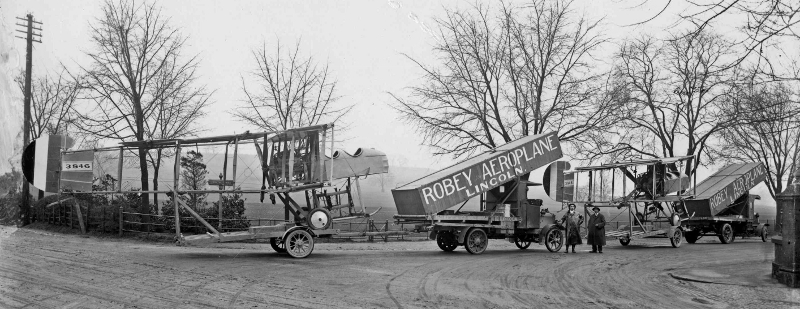
Also on 20th February two Robey-built Sopwith “Type 806” gunbuses (including 3846 above) are amongst five this month delivered 130 miles “as spares” from Lincoln to the RNAS Central Stores Depot at White City. Complete with engines and with wings sturdily crated they appear to be spare aircraft rather than spare parts.
That same day “Schneider” floatplane No.3740 is back at Calshot after two months under repair by Sopwith at Woolston and on 21st February “Baby” No. 8140 goes on its first North Sea anti-Zeppelin patrol aboard HMTrawler Cantatrice.
For the last few days several floatplanes have been waiting by the Thames in Kingston in the snow. On Friday 25th February Connie Webb watches from their smoking room window as “three are taken up despite snow on the ground and thick sleet falling”. “I feel so sorry for Harry Hawker as he climbs in and out of the machines”. “At Brooklands the other day something broke, I think it was the propeller, but he brought the aeroplane down safely.” “He also recently escaped a serious accident and hurt his arm against a tree – he ‘wore’ it in a splint.”
On 28th February “Schneider” No.3735 suffers a forced landing, capsizes and sinks near the Nab light vessel off the eastern tip of the Isle of Wight. Fl Sub Lt C McLaurin is saved.
The Sopwith works team have now completed a second “1½ Strutter” which with ten “Schneider” and sixteen “Baby” floatplanes makes a record monthly output in February of twenty-eight machines.
Despite the long hours, the Sopwith workforce do get some leisure time. Sopwith Athletic Club water polo team pose for a photograph (below) in their costumes with winged badge and ‘Sopwith AC Polo Team 1916’ on the ball. All still in their twenties, they are (back row from the left): Morrie Granger, Fred Sigrist (Works Manager), Jack Hyland (Asst Works Manager), Jack Pollard (Works Foreman), Williams and Jack Cooke. In front: Arthur Bale, Topham and Frank Spriggs.
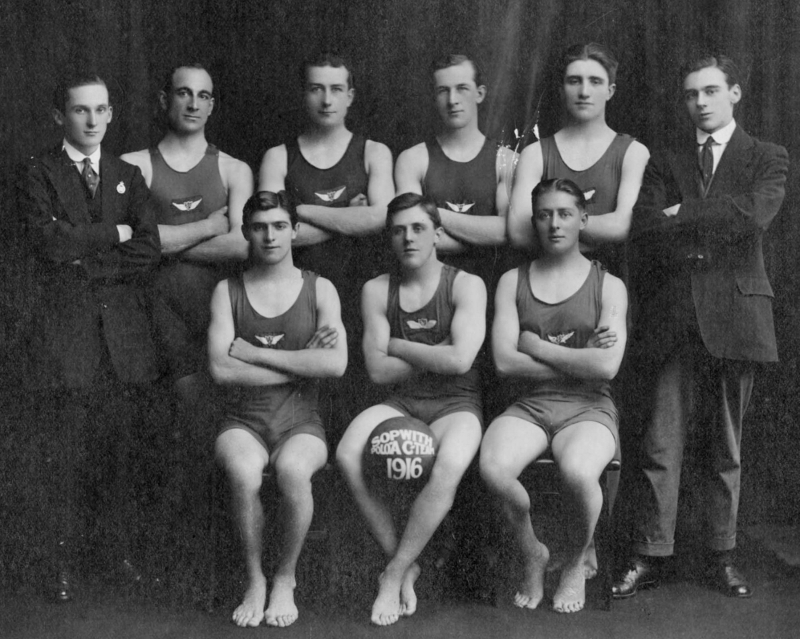
On Saturday 4th March Connie Webb again notes a “water-plane” on the Thames at Kingston in her diary. “Harry Hawker wears a dark suit today under a short black oilskin coat in place of his long brown coat and, of course, his fetching cap”. On Sunday morning there are two machines and “a tremendous crowd”. Mr Sopwith is there “with his widow (sic), ever so many naval officers and strings of motors. The Sopwith men never seem to go anywhere except en automobile”. In the afternoon another machine “seems to be rather a failure for, after skimming along the river, it fails to rise and comes back. Hawker tries it again until at last it rises properly. I think he should wear a uniform, there is nothing to distinguish him from a slacker and he is much braver than some who swank around in an officer’s uniform. Alice says he has rooms in Gibbon Road, poor man”.
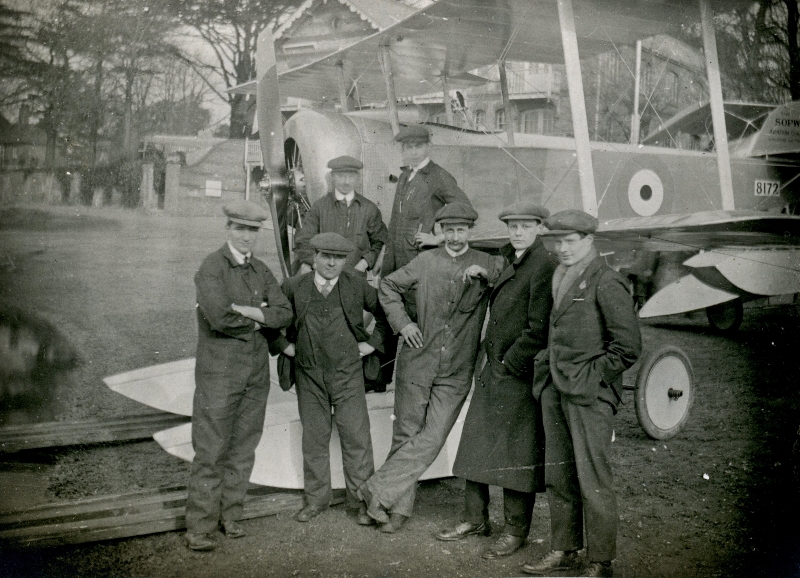
Sopwith “Baby” No.8172 is pictured (above) by the Thames in front of another machine with Turk’s Albany Boathouse behind. It is one of the last blunt-nosed Sopwith-built floatplanes with the 110hp Clerget engine. Manufacture of the last 30 of the 100 ordered is being switched back to 100hp Gnome Monosoupape engines with a bearing between engine and propeller giving them the pointed nose and making them indistinguishable from late production “Schneiders”. Their 30 Clerget engines are almost certainly now going to the urgent first Admiralty verbal order for 50 Sopwith “1½ Strutter” two seat landplanes.
On 5th March new “Baby” floatplanes Nos.8157 & 8163 make their first trips on North Sea anti-Zeppelin patrols from HM Trawlers Kingfisher and Cantatrice. They are replacing the lower powered “Schneiders” like No.3720 which is to be deleted from service at Yarmouth after a bruising seven months patrol work from the North Sea.
On 8th March “Schneider” No.3790 arrives at the East Indies and Egypt Seaplane Squadron at Port Said five weeks after delivery to Tilbury Docks. It temporarily joins No.3727 on seaplane carrier HMS Ben-my-Chree.
On 8th and 9th March Robey-built Sopwith “Type 806” pusher gunbuses Nos. 3840, 3842 & 3843 are delivered to Eastchurch Naval Flying School to join No.3849, which is there after two weeks with 4 Wing, whilst No.3847 arrives at the Eastchurch Gunnery School. Eastchurch becomes the sole base for these machines as Detling’s four have been deleted after the storm damage and the rest of the 22 built are in the RNAS store at White City.
On 9th March the London District Trade Union Committee for Aircraft Industry writes to Sir George Askwith at the Ministry of Labour Industrial Department. They list the fifty-five “aircraft companies” in London (including Sopwith) that they wrote to on 22nd February with an application for an extra 2p per hour for workers earning 1s or more per hour and 3p extra for those earning less than 1s per hour. “The companies have made no promise to pay workers in accordance with this application. We therefore request that the matter be referred for settlement in accordance with the provisions of the Munitions of War Acts 1915 & 1916.” This application for more pay for “woodworkers and erectors, woodworking machinists and men working on fabric, doping and polishing” is the Trade Unions’ latest move following Sir George’s Board of Trade Committee rejection of their previous application for standardised rates of pay for all aircraft workers.
On 9th March Connie Webb records two “water planes” by the Thames in Kingston. “Sopwith is there and several naval officers. One machine will not start at first and some man calls out a joking remark to Hawker who replies in the same vein. When the plane comes back Hawker lounges about talking to the other men. I do like his face, it is so pleasant and he has such a jolly expression as if he is wanting to smile but mustn’t. Several balloons go overhead (a most unusual sight now) and we hear that Hawker is going after them. A few minutes afterwards he climbs leisurely into the machine and flies off in the most casual manner. A very smart lady drives down in a lovely Rolls-Royce and Sopwith goes back with her.” On 10th March Connie writes: “We go down by Sopwith’s (factory) and I am surprised to see what a huge place it is, and they are still building.”
Despite the poor weather and other urgent commitments, the Sopwith team continue to test and develop their very promising prototype 80hp single-seat biplane scout at Brooklands. At some time, possibly before it went to Brooklands, it has been seen at the Thorpe Road Football Ground in Kingston. Close to Sopwith’s factory, these grounds are suitable for engine running and taxying trials and even as a small airfield (see map below) The photographs show the clear dope painted prototype with some fuel cans. The backs of the houses are on the south side of Latchmere Road (below left) and on Staunton Road when photographed from the other side (below right).
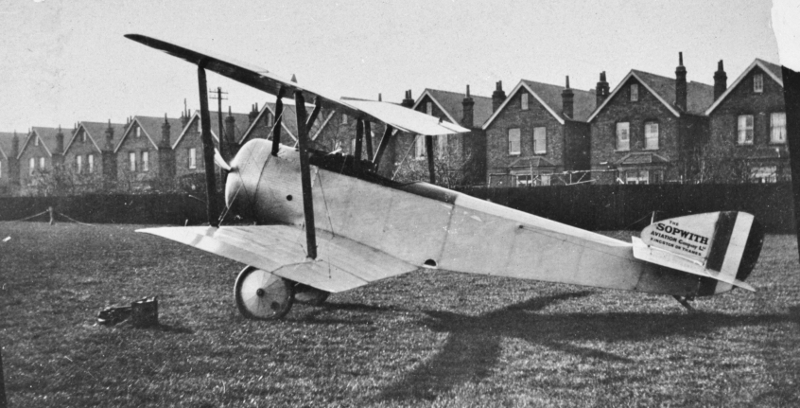
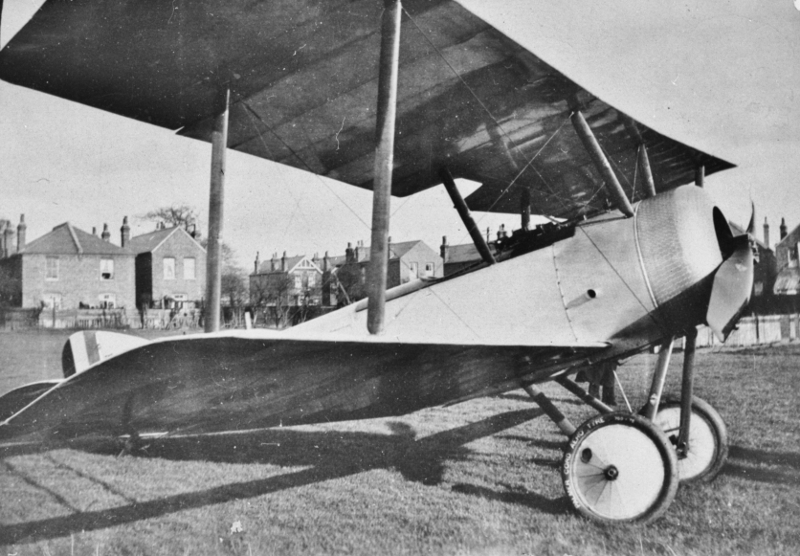
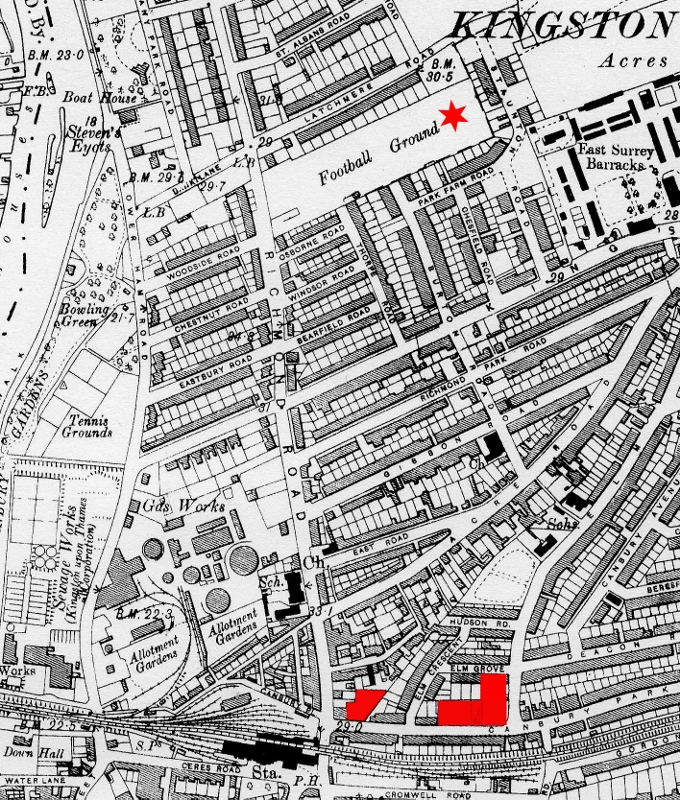
Not content with this little 80hp Scout biplane’s exceptional performance, the Sopwith design team have just completed the drawings of a higher-powered triplane version. This is a significant departure from their tried and tested biplane designs and, if successful, they would be the first to offer a triplane fighting scout.
On 10th March Sopwith suffer a set-back when the first production “1½ Strutter” No.9376 crashes at Brooklands.
On 13th March with the Admiralty expecting deliveries of “1½ Strutters” to reach 60 per month by June and considerable interest from the RFC, Sopwith’s architect A J Windybank submits a hastily prepared Building Notice (below) for a further factory extension across the back of the 1914 factory in Canbury Park Road.
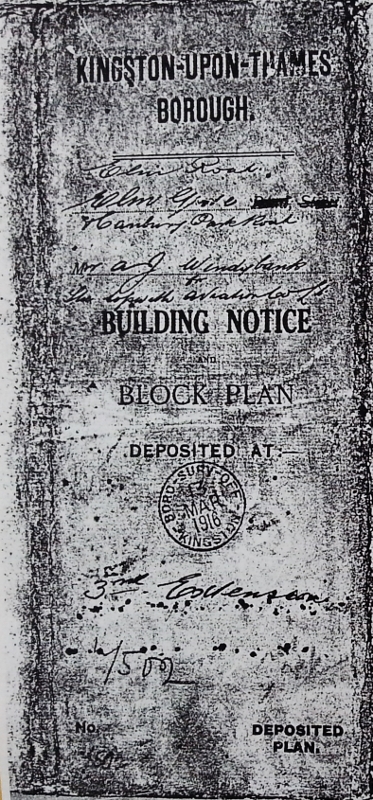
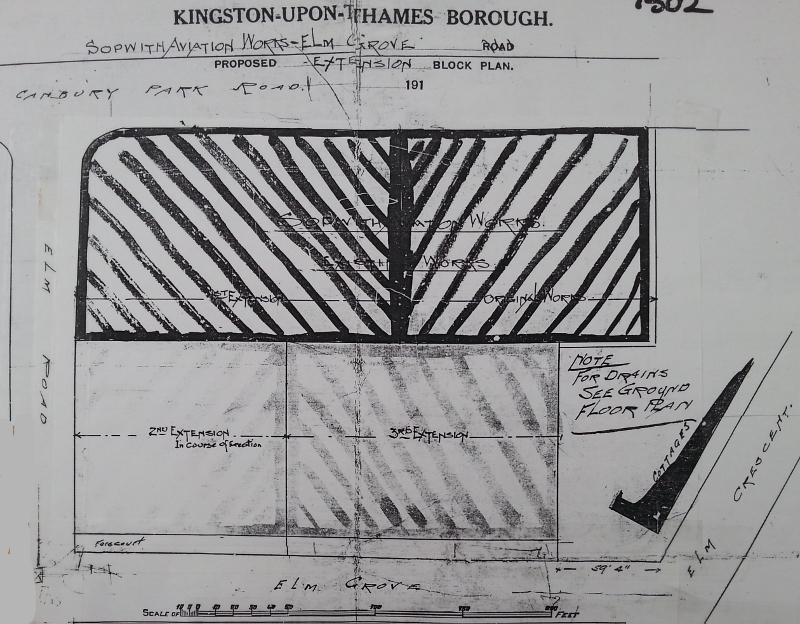
This is even larger than the second extension currently under construction. It extends that open plan two-storey steel-framed main workshop but this time the 34ft wide specialist workshops along the northern edge with the brick facade are three storeys high. The third floor is to be a timber store. An engine testing bay is included on the ground floor. This will increase the Sopwith factory workshop floor area to over 100,000 sq ft. Sopwith’s decision to build a third factory extension is made possible by the purchase of 28 to 36 Elm Grove from the executers of Mr Street and 37 Elm Grove from Mrs Fountain. These last ten terraced homes on the south side of Elm Grove are to be demolished by the end of March.

Meanwhile Borough Surveyor R Hampton Crucus has issues with the design of the almost complete second extension. On 11th March A J Windybank submits additional plans showing the positions of drains and fire escapes adding that “my client is unable to give me an exact figure for the number of people in the new buildings. They expect to start with two or three hundred of which 25 will be women. The lavatory accommodation, with the six I have been instructed to add in the existing works, will be more than sufficient for present needs with the intention to provide more when the necessity arises.” On 14th and 15th March the Admiralty Overseer Kingston-upon-Thames, Lt Walter Higginbotham RNVR, meets the Borough Surveyor to plead for the building to be approved and on 16th March he writes a letter stating that “any alteration to the lavatories will significantly delay opening and it is of great primary military importance that the contracts which Messrs Sopwith have should be completed on the dates promised by them. If you will not allow them to open these new works I shall have to report to the Admiralty that it will not be at all possible for Messrs Sopwith to complete their orders on time, a large part of which will have to be placed elsewhere with a tremendous amount of work and considerable delays”.
The prototype Sopwith 80hp single-seat Scout biplane has now been with the Admiralty for testing and their single-page report reveals extraordinary performance for its modest power. Speeds between 106 and 110mph are recorded at heights up to 10,00ft and it reaches 5,000ft in 5 minutes. “This machine is remarkable for its performance, ease of handling and for the quickness with which it can be manoeuvred. It is easy to land, landing at from 25 to 30mph.” They go on confirm “the view is equal to that of the Nieuport except straight down” and record “that propeller clearance is very slight but later machines will have a higher chassis, double streamlined wires and an adjustable tailplane to compensate for the weight of different pilots.” “The Vickers gun 500 round belt is fitted outside the fuselage along the top of the (engine) cowl and trued through the propeller”. This the first record of a machine gun mounted to fire through the propeller on a Sopwith machine. Sopwith foreman Harry Kauper is developing a mechanical synchronising mechanism which only allows the gun to fire when the propeller is out of the way. Vickers-Challenger and Scarff-Dibovsky are similar mechanisms urgently being produced to emulate those which have proved so effective on the German Fokker Eindeckers.
The Admiralty immediately sets about purchasing this prototype 80hp Scout from Sopwith. Their test report is sent to the Royal Flying Corps and forwarded to Maj Gen Hugh Trenchard General Officer Commanding the RFC in France who pencils a margin note addressed to his Quartermaster General “Let us get a squadron of these”.
On Thursday 16th March Connie Webb records 4 or 5 water-planes by the river. Harry Hawker flies two the next morning and two in the afternoon ending with “some excellent display flying”. “He never goes out of sight but circles doing spirals, corkscrews and curves. I don’t like to see the machine turn right on its side and almost upside down like that. Then he comes down the river from Kingston and looks as though he heading straight for us standing on the wall, rises up abruptly and goes right over our heads seeming to brush the cedar tops. Later the two men are tearing a machine apart but by 4pm it is flying. On Saturday there are two more floatplanes but we hear these are the last, Sopwith will henceforth only be building aeroplanes. If that is the case it is good for us that these are wrong ‘uns; one only stays up 10 minutes and on Sunday morning the other machine hardly rises. With the river in flood Hawker drives away as soon as he brings it back to land.”
The second production Sopwith “1½ Strutter” No.9377 is first into RNAS service arriving at the experimental flight at Chingford on 18th March.
On Sunday 19th March a “Schneider” from Westgate and “Baby” from Grain are amongst 30 aircraft sent out to intercept six German floatplanes which attack Dover, Deal and Ramsgate in broad daylight killing 14 and injuring 26. After the first ‘air battle’ witnessed by civilians, two Germans are eventually forced down at sea.
The performance tests and fighting potential of the Sopwith “1½ Strutters” have caused quite a stir in the Royal Flying Corps as well as the Royal Naval Air Service. The RFC are ready to place significant orders but Sopwith are a primary Admiralty supplier and already running behind with their ambitious programme of deliveries to the RNAS. Consequently Sopwith have negotiated a royalty agreement with Ruston Proctor in Lincoln to allow them to built “1½ Strutters” for the RFC. Like Robey & Co who have been building 30 Sopwith Gunbuses, Ruston Proctor & Co are a long established agricultural and general engineering company. Ruston Proctor are larger with works covering 100 acres and over 5,000 employees. Since January 1915 they have built 100 Royal Aircraft Factory BE2c two-seaters for the RFC and are now working on an order for 100 BE2d and BE2e variants.
On 21st March Ruston Proctor receive an order for 50 Sopwith “1½ Strutters” from the RFC with the knowledge that a further order for 50 is to follow in the next few days.
Ironically it is 23rd March before Sopwith receive their first formal order for “1½ Strutters”. It is for the 50 that they have been building for the Admiralty since January and a further order for 100 is on its way.
On 23rd March Sopwith “Baby” No.8122 is badly damaged and No.8156 wrecked being hoisted aboard HMTrawler Cantatrice in the tideway at Yarmouth. They may regret deleting four “Schneider” floatplanes Nos.1564, 1568, 1570 & 3710 in the last week after just 8 months in service. Felixstowe have deleted No.1571.
On Thursday 23rd March Connie Webb sees two new Sopwith floatplanes outside the Sopwith factory and on Friday and Saturday they are by the Thames. (Below two 100hp Sopwith floatplanes on the slipway at the Albany boathouse and Turk’s sign).
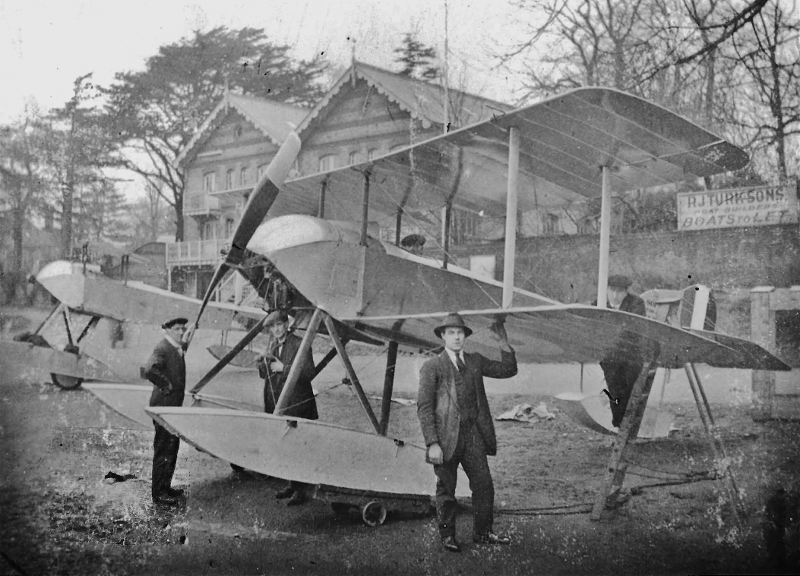
On Saturday Connie hears that an aeroplane is to be flown from the Thorpe Road football grounds. “There is a great crowd roped off by a fence. The important people are in the distance with the aeroplane in the centre of the field. It runs along and rises up beautifully to a great height and does the most wonderful loops I have ever seen. It is most wonderful to watch but I hate seeing it, it looks frantically dangerous. Hawker repeats this 3 or 4 times, how sweet of him to show the crowd something. He then flies out of sight. Dada thinks he is taking the machine to its destination.” The aircraft could be Harry Hawker’s 50hp runabout, a “1½ Strutter” or, most likely, the prototype Sopwith 80hp Scout after a quick overhaul at the factory ready for its performance evaluation next week by the RFC. Sopwith have now received a tender request from the Admiralty for two more of these lively 80hp Scouts.
On 24th March Yarmouth’s “SS3” Tabloid Scout No.1207 forced lands at Haisboro after engine trouble. With Dover’s “Tabloid Racer” No.1214 also now deleted, Eastchurch’s “SS3” No.1210 is the last surviving “Tabloid”.
On 25th March after two earlier failures and with intensive Zeppelin raids expected in the better weather, Commodore Tyrwhitt undertakes an ambitious air raid against the airship base at Hoyer on the Schleswig coast. HMS Vindex with 3 Short and 2 Sopwith “Baby” floatplanes is supported by the Harwich Fleet and the Battle Cruiser Fleet from Rosyth. All 5 are launched at 5.30am but find no airship base at Hoyer. “Baby” No.8152 drops 4x16lb bombs on a factory, is hit but gets back. A Short spots an airship shed inland at Tondern but their bombs jam in the carrier. They return through snow squalls. The other 2 Shorts and a “Baby” never return. One Short spots the pilot of “Baby” No.8153 trying to re-start his engine in shallows just off shore. They land alongside and fly off with him strapped to a wing strut. They then lose one bank of their engine, have to alight and slowly taxi on rough seas towards the British Fleet for 3 hours but are caught by German soldiers in a motor boat. The Germans salvage “Baby” No.8153. All 5 aircrew from the 3 floatplanes are taken prisoner.
The investigation into the loss of three HMS Vindex floatplanes in the 25th March raid on Hoyer blames faulty magnetos. The German Naval Air Service seems pleased with the otherwise intact Sopwith Baby No.8153 salvaged from just off shore (below). As the world’s prime supplier before the war they have good magnetos.
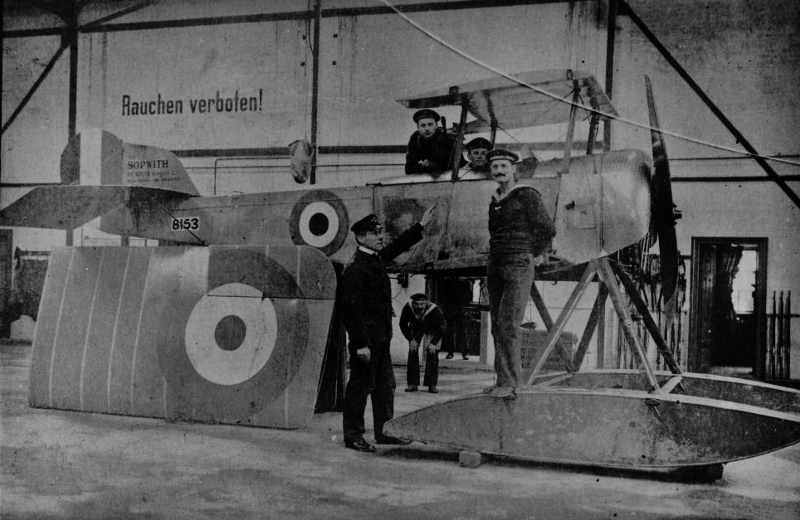
Despite press and public pressure and the reinforcing of RNAS coastal air defences by hard-to-spare RFC units around London, the Royal Navy remain convinced that the only practical way to eliminate Zeppelin attacks on Britain is to destroy them at their bases. That the failed Hoyer raid temporarily drew out the German High Sea Fleet in pursuit of the British naval force is an added incentive to try again. Some in the Royal Navy are spoiling for a major sea battle with the modernised German Navy.
“Schneider” Nos.3719 & 3726 are back at Calshot after repair by Supermarine at Woolston. Still wing-warping small fin versions, No.3726 (below) has now been fitted with a Lewis gun firing upward through the top wing centre section.
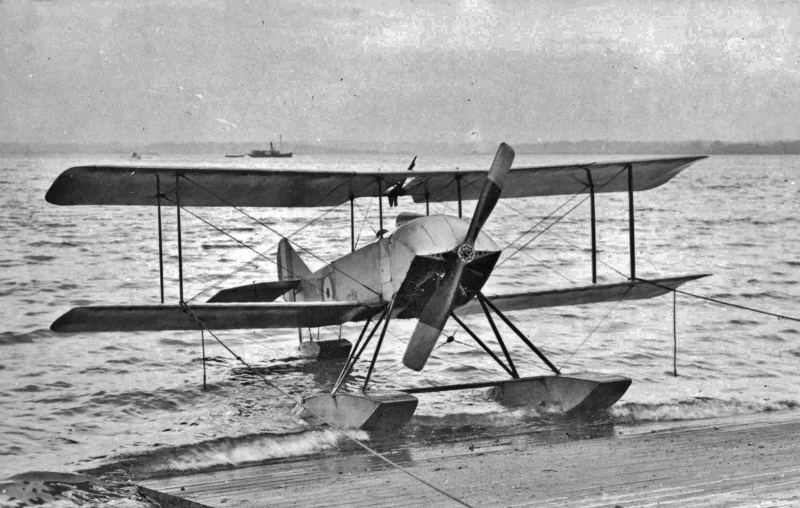
0n 27th March pioneer seaplane carrier HMS Ark Royal arrives back at Imbros from Salonica leaving some floatplanes at Stavros where they have been reconnoitring for the British Army and operating with naval forces for some months.(below “Schneider” No.1557 off Salonica).
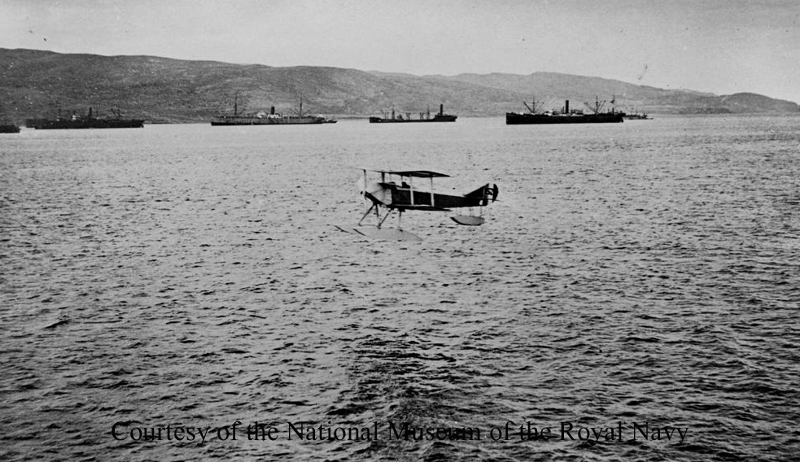
On 27th and 29th March the Royal Flying Corps’ Central Flying School at Upavon conduct their own performance tests on the prototype 80hp Le Rhône powered Sopwith Scout.
They report slightly lower performance than the recent RNAS tests. A top speed at ground level of 101.9mph with full tanks, a 12 stone pilot and a 15 mph cross wind is still impressive with such modest power, as are the 53secs climb to 1,000ft, 5mins 10secs to 5,000ft, 13mins 10secs to 10,000ft and 25mins to 15,000ft. Maj Gen Hugh Trenchard has already written that “We should have a squadron of these” in France and these tests may be an essential step towards the RFC placing an order.
On 28th March the prestigious Royal Aero Club holds its Annual General Meeting at 116 Piccadilly. The Vice-Chaiman reports that a large number of aviator’s certificates have been issued, 44 members have been lost on active service and members have gained 6 VCs, 38 DSOs, 8 DSCs and 48 Military Crosses. Over £10,000 has been subscribed to their Flying Services Fund to help airmen incapacitated on active service and widows and dependants of those who are killed. The list of fellow committee members indicates how well connected 28 year old T O M Sopwith is with key people in British aviation including Capt Moore-Brabazon, Comdr Samson and the Marquess of Tullibardine. The Council includes the Earls of Hardwicke and Lonsdale, Lords Northcliffe, Howard de Walden and Montague of Beaulieu, two Admirals and the President of the Royal Society.
On 27th March the Admiralty report on outstanding aircraft orders and “anticipated deliveries” includes: Sopwith “Type 860” large floatplanes: 8 only delivered of last 12, orders held pending further alterations. Robey built Sopwith “Type 806 “ gunbuses: 22 delivered of 30, 8 waiting accommodation. Sopwith “Baby” floatplanes: 86 delivered of 100 – 1 promised 1/4/16 & 3 per wk. Sopwith “1½ Strutters”: 6 delivered of 50 with another 102 to follow – 3 promised 1/4 & 3 by 8/4/16. Remarkably Sopwith have now been instructed to deliver 30 of the Admiralty “1½ Strutters” directly to the RFC.
Sopwith Works Cards record the completion in March 1916 of the final 8 “Schneider” floatplanes plus 21 “Baby” floatplanes and 13 “1½ Strutters”. 42 new aircraft smashes the previous month’s output record of 28. These are aircraft ready for company testing and thus somewhat ahead of numbers recorded by the customer.
The private-venture prototype Sopwith “1½ Strutter”, still without an official serial number, has arrived by road on 26th March with RNAS 4 Wing at Eastchurch (below).

On 27th March “1½ Strutter” 9380 joins 9377 with the Experimental Flight at Grain. On 29th March “1½ Strutter” 9379 is the first to arrive at Dover. Repaired “1½ Strutter” 9376 arrives at Grain on 30th March and goes to RNAS 1 Wing.
On 29th March the Sopwith Board seals the royalty agreement with Ruston, Proctor & Co “to build machines and spare parts” and confirms ownership of the ten houses purchased in Elm Grove. They now set about purchasing all eight houses on the east side of Elm Crescent and four, Nos.21 to 27, on the north side of Canbury Park Road. These would provide the land for another large extension wrapped around the north-west and west side of the main factory.
On 29th March weekly magazine Aeroplane carries this rare report on British military aircraft production:-
“SOPWITH PROGRESS The famous Sopwith Works at Kingston continue to expand rapidly, cottages being pushed over and new buildings erected with the swiftness of a Ruthless Rhyme. It is quite entertaining to observe how the business grows, for one finds here and there, outside the walls of the main building, a floor laid down with enough bench accommodation for a few workpeople who carry on energetically, while builders are busily engaged in building round them and putting a roof on. No time is wasted and the output of machines reflects great credit on all concerned. A number of girls are now employed in acetylene welding, with highly satisfactory results. The organising abilities of Mr R O Cary, backed up by no less experienced a Works Manager in Mr F Sigrist, have established a very fine factory, and Kingston may well feel proud of the important part its local industry is playing in the aerial defence of this country.” (Usually just 4 lines, Ruthless Rhymes are cheerfully cruel poems written by Harry Graham in 1898)
Sopwith floatplanes continue to be distributed around the RNAS. On 31st March “Schneider” No.3743 is tested at Felixstowe by Harry Hawker, “Schneider” No.3796 arrives at Scapa for HMS Campania and “Baby” No.8170 is finally accepted at Yarmouth after arriving there six weeks ago.
That same day “Schneider” No.3781 arrives at the Northern Aircraft Flying School at Windermere from storage at White City. They have been using their own civilian floatplanes to train pilots from scratch for some years. The Navy is planning to fully take over the flying school at this relatively sheltered inland location as RNAS Hill of Oaks.
On the evening of 31st March six German Navy and Army Zeppelins bomb London and East Anglia killing 48 and injuring 64 people. RNAS Yarmouth get no early warning due to gale damaged telephone lines so the only Sopwith response is a fruitless early morning patrol by “Baby” No.8163. There are 24 defence sorties overnight by the RNAS & RFC, one pilot is killed taking off in mist and at least 6 aircraft are wrecked but three pilots do see L15, one gets in some shots and another drops Ranken darts onto her. She is one of two hit by anti-aircraft fire and lands broken-backed off Margate. The crew less one who drowns are captured by a British destroyer.
On 3rd April the Admiralty report for the last week shows four “Baby” deliveries (now 90 of the 100) with one promised 8/4/16 then three/wk and three “1½ Strutter” deliveries (now 9 in total) with three promised 8/4/16.
On 3rd April “1½ Strutter” 9378 becomes the second of this new type to be based at Dover.
5th/6th April is the fifth night running there have been Zeppelin raids spread across London, East Anglia, Northern England and the Forth, killing 84 people and injuring 227. No further airships have been hit after the two on the first night despite another 30 home defence sorties, none of them involving Sopwith aircraft.
On 6th April Connie Webb records in her diary three ‘water-planes’ by the Thames in Kingston. “We rushed down the garden to our usual place by the cedars as Hawker rushed by looking our way, he never went out of sight and we saw some lovely flights, spirals and curves galore. At one time he took a straight downward dive at our house.” “People rush up to him with congratulations after some flights, especially the girls.” On 7th April Connie writes in her diary “the ‘water-planes’ have not gone up when we leave“, the last such entry as the family have let the house in Kingston to rent less expensive accommodation in Bournemouth.
Flight magazine reports that on 8th April “Harry Hawker, with a passenger, pays a visit to Hendon aerodrome on the new two-seater Sopwith ‘bullet’, and showed what his mount could do in the way of speed and slow landing – and very good it was too”. In a lapse in the security blackout on new aircraft types they publish a photograph of the event (below) showing it to be a “1½ Strutter”.
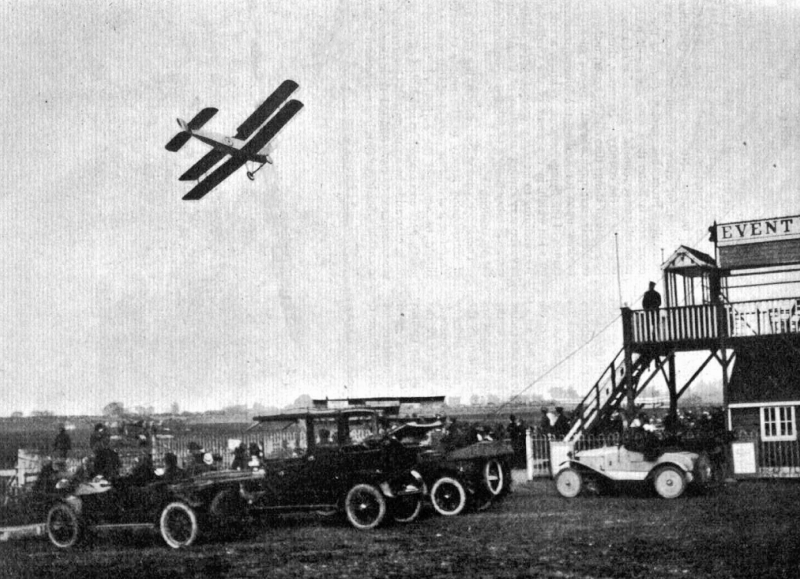
On 10th April the seventh “1½ Strutter” RNAS No.9381 arrives at Brooklands for testing. This is the first to be re-allocated to RFC (Military Wing) from Sopwith’s RNAS order and will have to be re-painted with the RFC serial number 7942.
The Admiralty has been convinced of the RFC’s greater need for some of these fast long-range two-seaters having been told of the secret plans for a major offensive in the summer by British and French Armies on the Western Front. Deliveries from Ruston, Proctor & Co against the RFC’s own order cannot possibly be made in time. The planned summer offensive in the Somme has the additional important aim of drawing German forces from the Eastern Front to relieve the overwhelming pressure on the Russian allies.
There is a story going around that the RFC’s recently appointed Director of Air Operations, Brig Gen Sefton Brancker, has been to Brooklands and when seeing Sopwith’s prototype 80hp single-seat Scout alongside the larger two-seat “1½ Strutter” declared – “Good God! Your 1½ Strutter has had a Pup.” True or not, the name has stuck and everyone is calling it the Sopwith “Pup”.
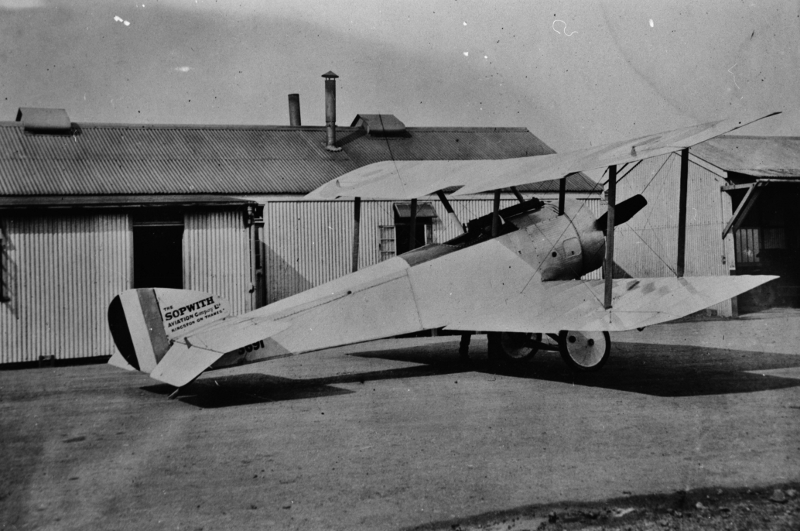
This photograph shows the prototype “Pup” now owned by the Admiralty marked with RNAS number 3691 and fitted with a Vickers gun. They have just ordered two more with 100hp Gnome engines.
Attrition of the RNAS Sopwith floatplane fleet continues apace. On 4th April Yarmouth “Baby” No.8163 on hostile aircraft patrol was wrecked landing in fog, Felixstowe’s “Schneider” No.3729 overturned on landing on 5th April, Calshot’s No.3779 overturned on take-off on 7th April and Killingholm’s No.3728 is wrecked on 8th April. The pilots appear to have escaped serious injury but all the machines will be deleted from service.
On 11th April “1½ Strutter” 9376 is the first to go to the front line in Western Europe joining 5 Flight A Squadron of RNAS 5 Wing at Coudekerque. Sister machine 9378 is already at Dunkirk and will follow in the next few days.
The 13th April sees the first meeting of the recently formed Society of British Aircraft Constructors (SBAC). The Sopwith Aviation Co is a founder member with General Manager R O Cary on the Committee of Management. Aeroplane reports that “practically every firm of standing in the industry has signified its approval of the objects of the society” which are to encourage, promote and protect the British aircraft industry and protect the general interests of companies, firms and persons engaged therein. Underlying these laudable long term objects is the urgent desire to speak as one to Government about the way excess profits are calculated and the impending increase in the tax on those excess profits to 60%. Excess Profits Tax is popular with the public and the Treasury but very contentious with these rapidly expanding young companies who need to use their profits to expand facilities and purchase equipment possibly beyond any likely commercial requirement once the war is over. The 60% tax is applied to profits in excess of the company’s pre-war levels or to profits exceeding 6% of capital employed. For those with no pre-war financial history it is on profits exceeding 9% of capital employed.
Noel Pemberton Billing, newly elected Independent MP for East Herts, has started to harangue the Coalition Government with his views on the failings of the Royal Aircraft Factory and the RFC. He is judged by many to have gone too far when declaring that the dependence on BE2 machines and RAF engines is negligence tantamount to the murder of our airmen. His evidence for this is to be assessed by an Air Enquiry Committee. When asked what taxpayers are paying Mervin O’Gorman to run the 3,223 strong Royal Aircraft Factory, the Minister replies that it is £3,000 p.a. with his four senior managers on £450 to £630 p.a. When skilled workers are earning around £150 per annum, the implication is that £3,000 p.a. is a very large salary. It is not generally known that leaders of private aircraft companies are paying themselves up to £10,000 p.a.
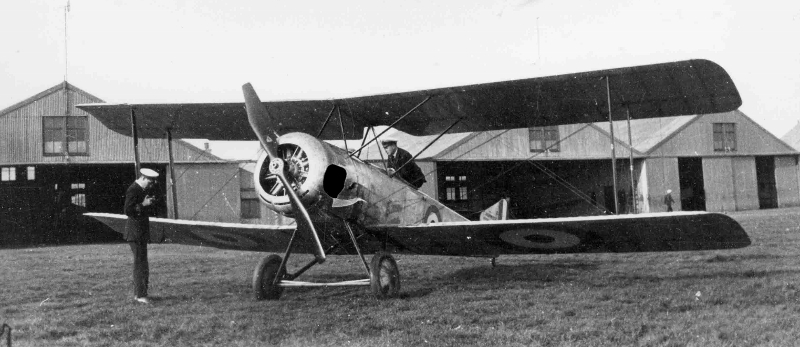
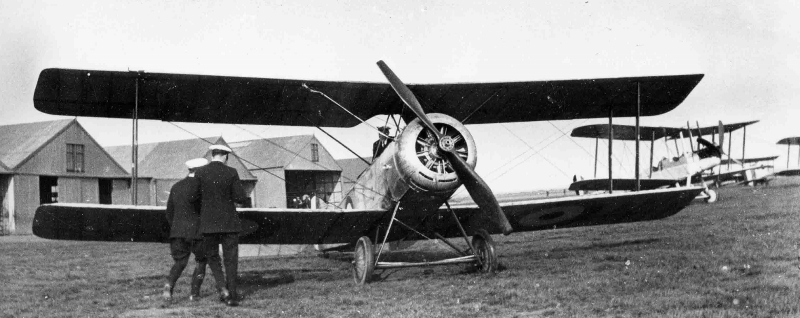
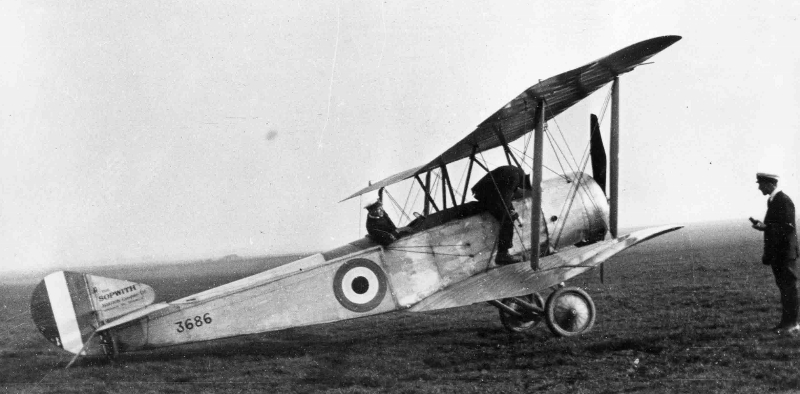
Sopwith’s private venture prototype “1½ Strutter” has been at Eastchurch since 26th March and since 10th April has displayed RNAS serial no.3686. This early number implies that the Admiralty decided some months ago to purchase it from Sopwith. On 16th April it moves from 4 Wing to the War Flight at Eastchurch. (photos above) That same day the last surviving Sopwith “SS3” Tabloid Scout No.1210 makes the same move.
On 17th April the Admiralty report on outstanding aircraft orders shows the final eight Robey built “Type 806 “ Gunbuses now delivered to store plus seven more “Baby” floatplanes with the final three of those promised this week. Three more “1½ Strutters” makes twelve delivered with five more promised this week.
On 16th April “Baby” No.8178 operating from HMS Engadine and flown by F Lt F J Rutland overturns on take-off. The next day replacement “Baby” No.8177 is wrecked en route to HMS Engadine from Killingholme but they manage to hoist her in. In Egypt on 17th April EI&ESS “Schneider” floatplanes Nos.3722 & 3775 are badly damaged by a falling derrick at Port Said. These two have been operating from HMS Raven II, the ex-German merchant vessel SS Rabenfels seized at Port Said in 1914. All of these floatplanes will be deleted from service.
On 18th April T O M Sopwith attends a Royal Aero Club Special Committee meeting where it is decided to extend the club premises to provide a dining room where members can take lunch and dinner.
On 21st April Killingholme “Baby” No.8155 crashes into the Humber and is wrecked killing Temp Fl Sub Lt W Hocking. That same day Fl Sub Lt A C Saw is killed when Calshot Seaplane School “Schneider” No.3752 stalls and dives into the sea 1½ miles north of Cowes.
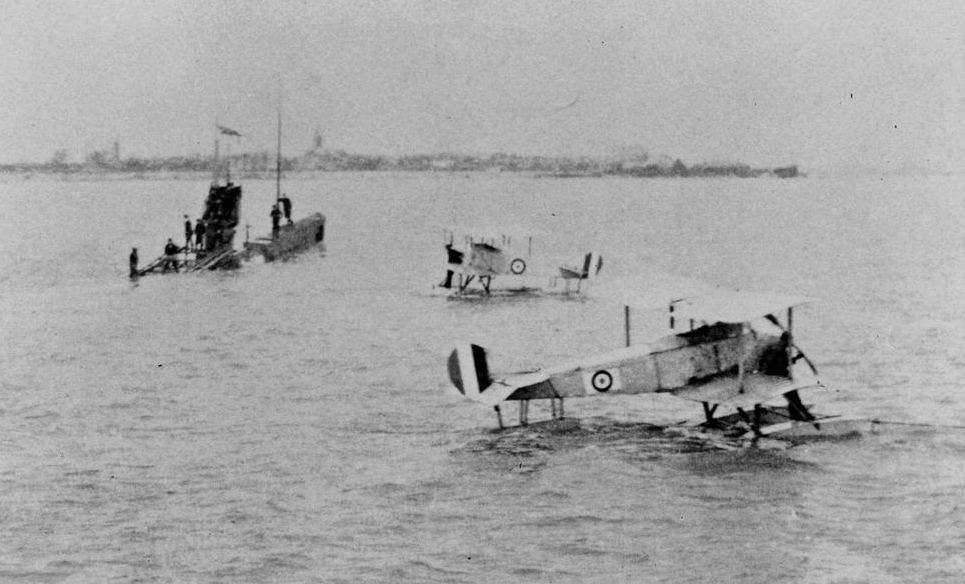
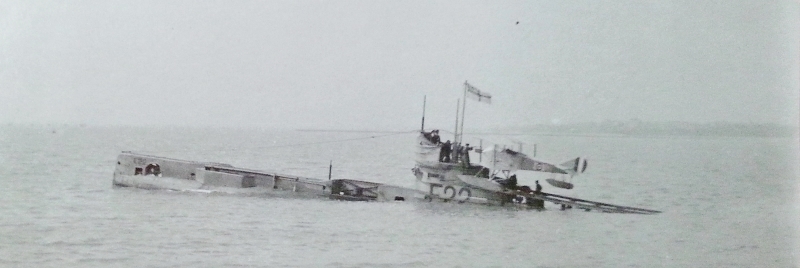
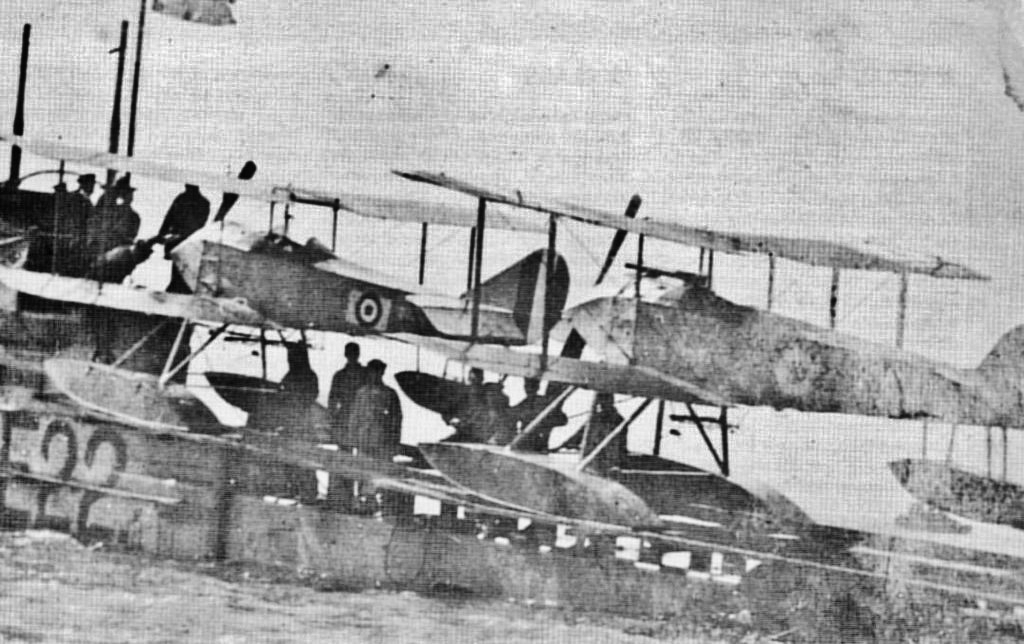
On 24th April the relaxed pilots of two Sopwith “Schneider” floatplanes Nos.3730 & 3743 are waitng to be called aboard an experimental seaplane platform on the aft casing of HM Submarine E22 in the calm waters of Felixstowe harbour.(above)


Out at sea the submarine’s stern is progressively submerged and one machine “slipped off” to be flown back to Felixstowe. The Commander of RNAS Felixstowe reports the experiment to be a success the “seaplanes in their stowage positions are high enough out of the water to be quite safe from any sea in which it would be possible for them to work at all”. However the submarine obviously can only operate on the surface with the aircraft aboard and the platform adversely affects the submarine’s underwater performance.
The very next day HM Submarine E22 is torpedoed by German U-boat UB-18 off Great Yarmouth with the loss of her Commander Lt R Dimsdale and all but two of her crew who are taken prisoner by the U-boat.
Also on 24th April Dover “Schneider” No.1573 and Grain Nore Flight “Baby” No.8151 are amongst sixteen aircraft sent up to try to intercept a high-flying unidentified German aircraft spotted over Dover.
At 4am on 25th April “Baby” floatplane No.8140 flying from a Yarmouth trawler, is the last of 22 aircraft sent up that night to try to intercept five Zeppelins returning across the North Sea from an unsuccessful raid on London. No.8140 makes a forced landing 40 miles off the Dutch coast and is brought ashore to Scheveningen, Zuid Holland by a Dutch trawler. Fl Sub Lt S G Beare is to be returned home but his aircraft is interned and taken by lorry (below) to serve with Netherlands Navy’s aviation service, the Marine-Luchtvaartdienst or MLD.
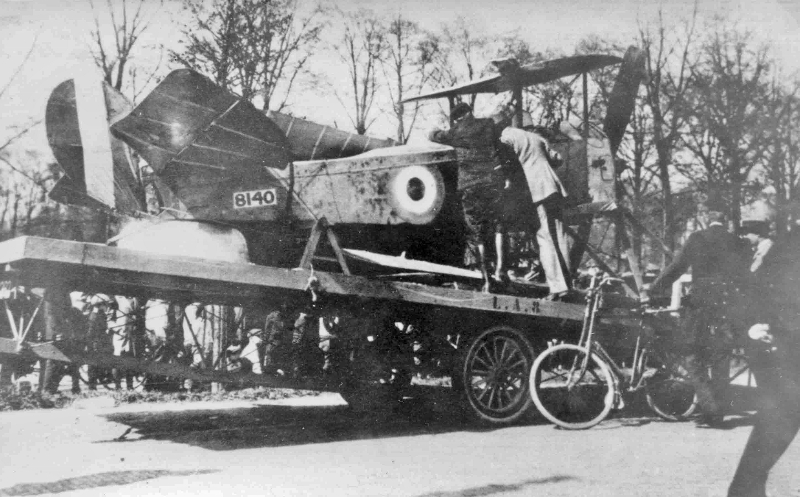
Later on 25th April Fl Sub Lt J A Sadler flying “Baby” No.8159 from HMS Vindex attempts to bomb a German submarine before suffering an engine failure and making a forced landing which damages the chassis. He is towed to shore at Thorpeness.
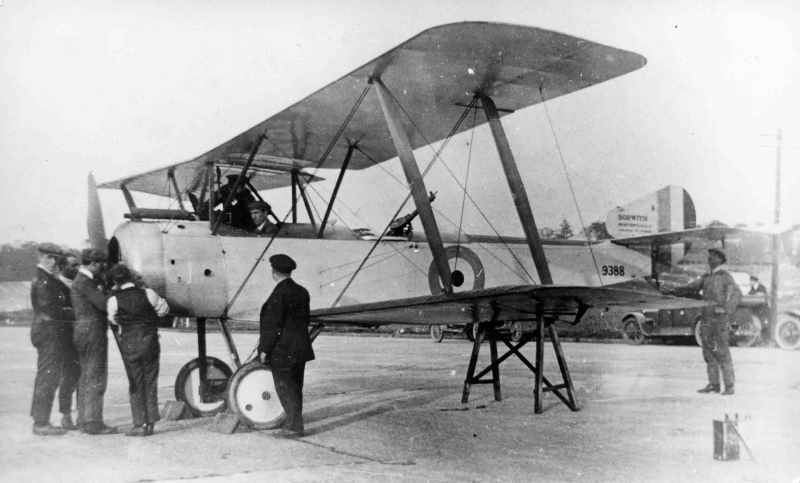
This first photograph has emerged of a “1½ Strutter” with two guns fitted. With Harry Hawker in the cockpit, the thirteenth production “1½ Strutter” 9388 is at Brooklands wheels chocked and set in flying attitude possibly for gun firing trials. If that is the case then the Sopwith team are probably setting the Sopwith-Kauper synchronising gear to ensure the Vickers machine gun only fires when the propeller is out of the way. Fitting shop foreman Harry Kauper who came from Australia with his friend Harry Hawker in 1912 has devised and is patenting this ingenious mechanism timed from cams mounted on a rotating part of the engine. To protect the rear of this “1½ Strutter” the observer has a swivelling and elevating Lewis machine gun apparently mounted on a pillar.
Below are some diagrams of a Sopwith-Kauper gun synchronizing gear. The cam disc a rotates with the engine and propeller and the cam is set with the low points close behind the positions of the trailing edges of the two blades of the propeller. When the pilot “fires” the gun from a lever in his cockpit, Bowden cable T is pulled but that only results in a pull on the trigger j of the machine gun when the cam follower roller b is at the two low points on the cam disc a.
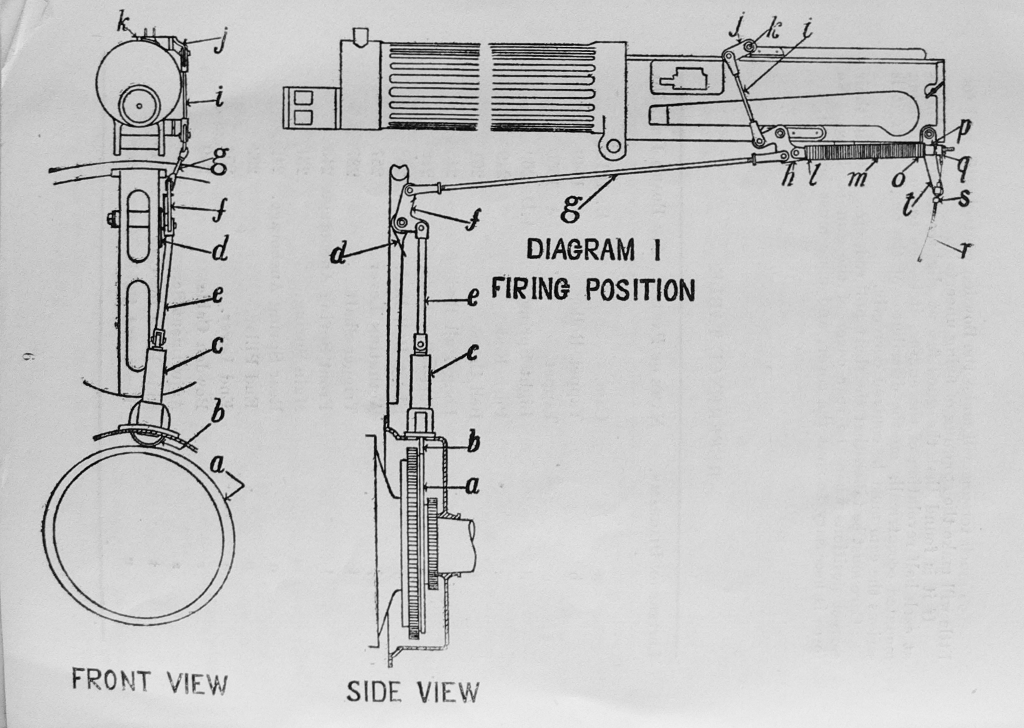
The complex sliding and quarter turning slotted and feathered torsion spring mechanism (below) ensures that the gun will only fire with the pilot’s input and then allows synchronized firing with the propeller rotation. The firing cable T from the cockpit pulls the lever on q to turn and withdraw the central shaft to bring the mechanism to the firing position which allows the cam follower b to freely operate the gun

The six Admiralty “1½ Strutters” so far diverted to the RFC at Farnborough are also getting two guns. On 25th April Sgt Major Power is clearly impressed with his machine and reports that he is able to fly alongside a single-seat 140hp Royal Aircraft Factory BE12 at 6,000 ft with only a slight difference in top speed despite having thirty less horsepower and being two-up carrying two guns, ten ammunition drums, a camera and a wireless.
On 26th April Harry Hawker takes a “1½ Strutter” to a new British height record of 24,408ft at Brooklands, a considerable improvement on his own 18,393ft record in the “Sigrist Bus” last June and not far short of the long-standing world record of 25,750ft held by Herr Oelerich in a specially modified DFW. The only change to Harry’s standard machine is a finer pitch Lang propeller. One report refers to it as a single-seater which would suggest that it is the first “1½ Strutter” bomber. Sopwith’s second Admiralty order for “1½ Strutters” has been formalised for 100 in a mix of long & short range two-seat fighters and long range single-seat bombers.
Since late March pairs of Sopwith floatplanes have been operating North Sea anti-Zeppelin patrols from HMS Killingholme & HMS Brocklesby (below left), shallow-draught paddle steamers modified from Humber ferries by the addition of a pair of handling derricks and two defensive guns. Double-ended with bow and stern rudders operated by two wheels they are difficult to handle and when they roll the deck overhang bangs into the water.
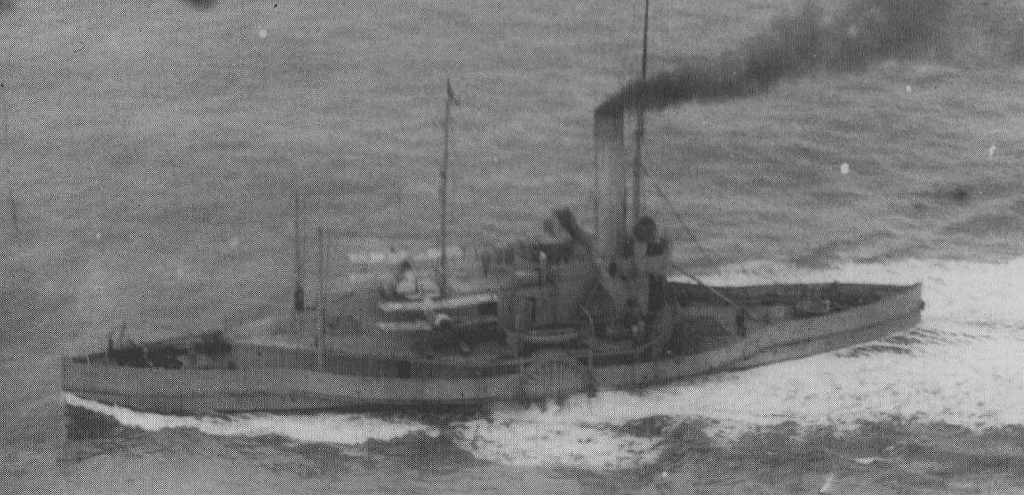
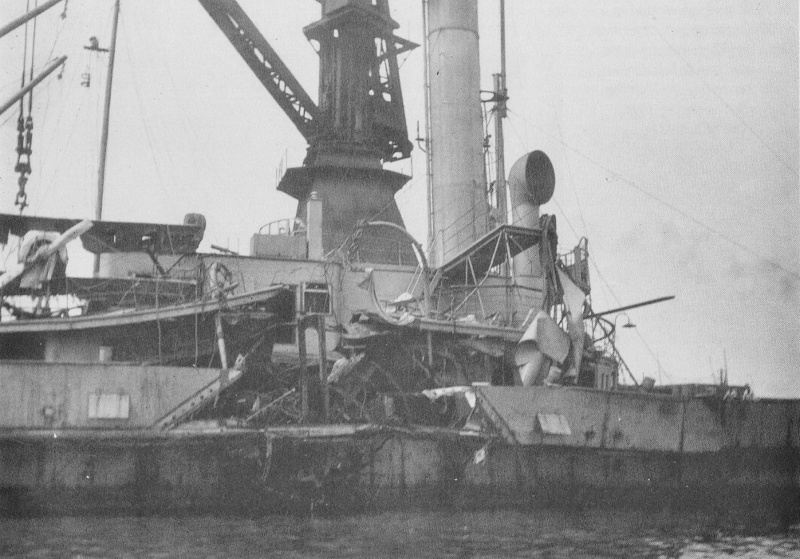
On 27th or 28th April eighteen lives are lost on HMS Killingholme including two RNAS mechanics and two RNAS pilots: Temp Fl Sub Lts Broad and Boddy. She strikes a mine off the Dogger Bank sustaining considerable damage to her port paddle box and bridge wing. (above right with wrecked Sopwith “Baby” No.8147)
In the evening of 28th April Harry Hawker is stopped by Police Sergeant Tytherleigh in Oatlands Drive, Walton on Thames for failing to display an off-side headlight. He has a single headlight near the front axle which he is told is illegal in the County Constabulary Area. Harry does not have his driving licence with him.
Sopwith’s factory records show fourteen “1½ Strutters” completed in April and eight “Baby” floatplanes. Admiralty records show they now have twenty “1½ Strutters”, six of which have crossed to RNAS Aeroplane Depot at Dunkirk, two or more going on to Coudekerque to start forming 5 Flight of A Squadron RNAS 5 Wing.
At the end of April 1916 there are just two of the Admiralty’s 236 Sopwith “Schneider” and “Baby” floatplanes to be delivered. 113 are currently active and are widely distributed: 8 with HMS Ark Royal in the Aegean, 10 with the EI&ESS at Port Said or out on HMS Raven II, 11 with HMS Campania at Scapa, 7 at Dundee some on HMS Engadine, 13 at Killingholme, 14 at Felixstowe, 14 at Yarmouth, 19 at Grain some on HMS Vindex, 5 at Westgate, 1 at Dover and 11 at Calshot or Bembridge. 55 are in storage at the RNAS Central Stores Depot at White City including recent deliveries probably awaiting engines. 62 have been deleted from service: three through enemy action. 18 of the deletions are recorded as crashes including three after engine failures and the rest are a variety of accidents some of which could equally have been recorded as crashes. Many accidents have involved float and chassis damage at sea but no aircraft is recorded as having failed structurally in the air.
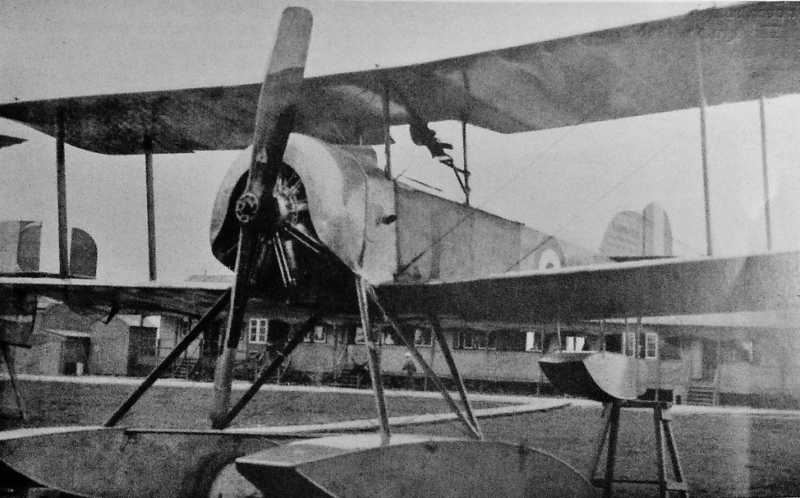
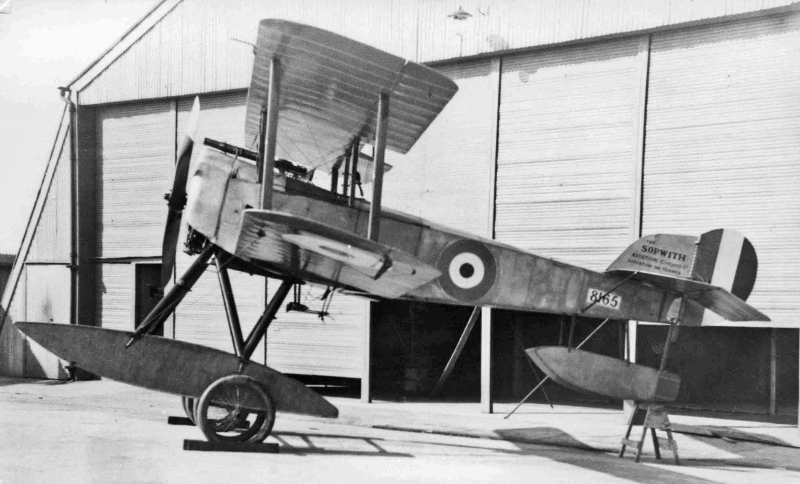
The RNAS are arming more Sopwith floatplanes with Lewis machine guns. “Schneider” No.3773 in Egypt has carried one since February and at Cowes No.3726 has one firing up through the top wing centre section whilst at Grain “Baby” No.8160 has a 45 degree upward firing Lewis gun crudely attached to its port centre section struts. (above left). They are also experimenting with Lewis guns firing through the propeller. Yarmouth “Baby” No.8165 (above right) now has one apparently centrally mounted and Grain’s No.8151 (below) has one mounted on the starboard longeron.
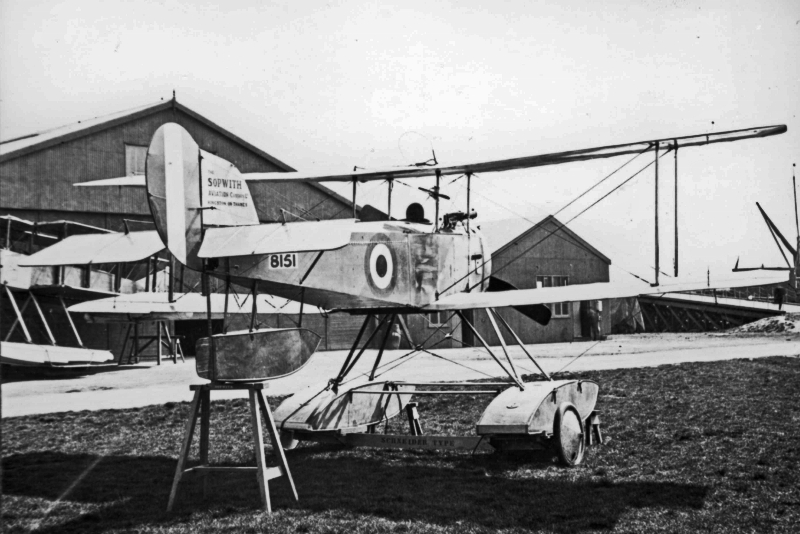
On 3rd May No.8151 flown by Fl Cmdr Cave-Brown-Cave is amongst twelve aircraft sent up after a Hansa-Brandenburg NW floatplane which drops ten bombs near Sandwich and at Deal damaging a public house. When the official report erroneously states that the railway station was hit, the Deal Chamber of Trade protests fearing such a report will put off holiday visitors.
On 4th May the Royal Navy sets out to make a second attack on the Zeppelin sheds at Tondern and tempt the German Navy out to sea. At 3am with minefields laid and submarines and the Grand Fleet in position, HMS Vindex and HMS Engadine start hoisting out their Sopwith floatplanes off the island of Sylt. For eight of them the sea state proves too much and they never leave the water, four break propellers, three suffer engine failures and one capsizes in the wash of the destroyers. “Baby” No.8143 does get off but hits the mast of destroyer HMS Goshawk and crashes killing Fl Lt O N Walmesley. No.8158 makes a brief flight but suffers engine failure and capsizes during the forced landing to be recovered wrecked. One “Baby” pilot believing he has found Tondern’s Zeppelin sheds in the mist drops his bomb load but scores no hits. Later two light cruisers fire at long range at Zeppelin L7 sent up to reconnoitre British forces, and bring it down. Seven of the twenty crew are rescued by British submarine E31. The whole naval operation is called off at 2pm.
When George Livock recalls the 4th May 1916 Tondern raid he includes the following revealing comments: “We each carried a 65lb bomb. There was an oily swell, which wouldn’t have worried a Short but was clearly going to be a nasty problem for the Babies. I was the last of the five to be hoisted out from HMS Engadine, but before I touched the water and unhooked from the crane, I saw that the sea was littered with damaged seaplanes, some on their noses, some sinking and others bounding about over the swell trying to get into the air. My engine started at the first pull of the handle and I settled down and opened up to see what I could do. A cloud of spray shot over everything as I breasted the first swell. Bump! Into the second and more spray. I was momentarily airborne. Bump! Crash! The engine raced madly as my propeller disintegrated into matchwood and flew in all directions. I was taken in tow by the ship’s motor boat and hoisted back on board with the other damaged seaplanes. None of us had got off the water.” “HMS Vindex with her machines did much better getting two (actually three) into the air but poor Walmesley, who had been at Grain with me, flew into a mast and was killed. The other pilot dropped his bomb unsuccessfully and returned. Why, I asked myself, was he able to take off when I couldn’t? I now realise that I simply didn’t know how to fly the Baby properly. I had only done four flights in them before and none of these in anything but calm water. Had I possessed half the experience acquired later at Yarmouth I’m certain I would have succeeded but, on the other hand, my navigation being what it was, I should probably have been taken prisoner or been interned in Denmark. It was quite absurd to expect us to operate such machines from the open sea without a lot of practice. There was a considerable row afterwards about this fiasco and carriers and seaplanes were, I believe, nearly abandoned as useless.”
On 4th May under “Famous Flying Man Fined” the Surrey Comet quotes Harry Hawker in the Magistrates Court as saying he is always anxious to comply with the law. The Chairman observes that he was not doing so on 28th April and fines him £1 for not displaying an off-side headlight and 5 shillings for not having his licence with him, noting the latter summons could have been avoided by taking his licence to a Police Station in the meantime.
During April the Sopwith order book from the Admiralty has grown beyond the 150 “1½ Strutters” being built to include another seven, one of which is No.9891 a prototype 80hp Gnome engined trainer version which is already being tested at Brooklands. The order for two “Pups” with 100hp Gnome Monosoupape engines to join the single machine so far built will probably be getting 80hp Clergets but the priority in the experimental shop has switched to building a 110hp Clerget engined high-speed high-altitude triplane development of the “Pup” which the Admiralty have ordered. It is well underway (below) and has already been fitted with the unusual broad-chord single struts with metal brackets for attaching the top and the mid wings.
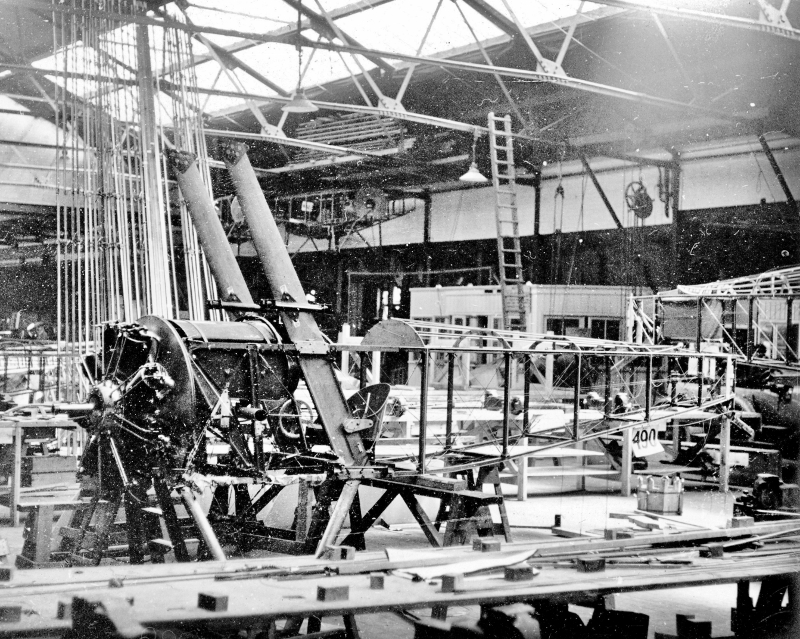
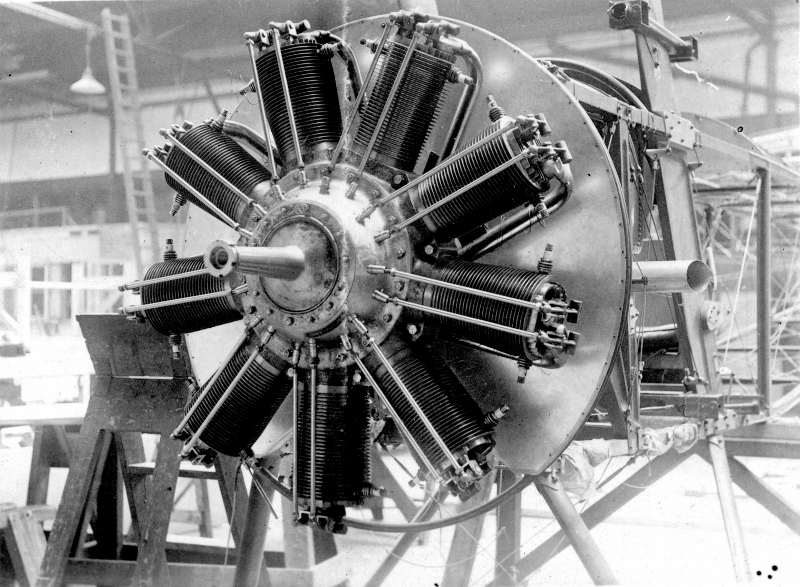
The Sopwith team have also completed the design of a private venture very much larger three-seat long range triplane with a Rolls Royce 250hp geared water-cooled 60ᴼ Vee12 engine, the availability of which may have been helped by Tommy’s long standing links with Rolls Royce and the recent £1,000 investment in their shares.
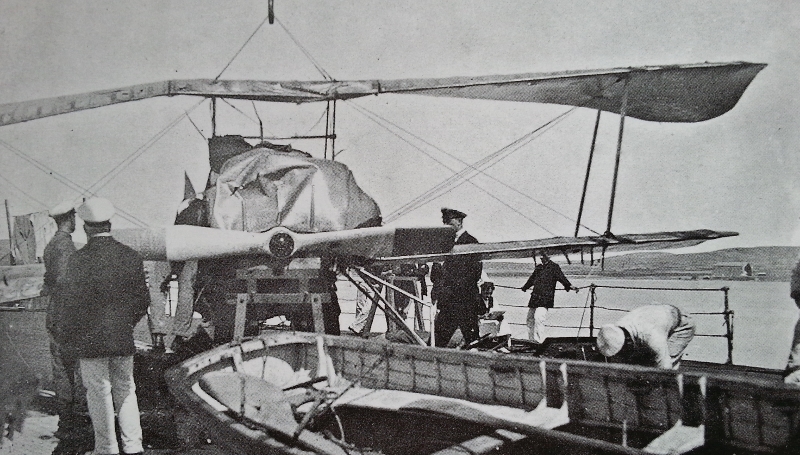
“Schneider” No.1577, in the Aegean since September 1915, capsized on 3rd May landing at Stavros from HMS Lowestoft and now on 8th May sideslips into a nosedive from 100ft and is finally completely wrecked (Most probably the aircraft in the photo above). On 9th May sister machines Nos.1578 & 1570 are tested for the first time after 8 months storage with Ark Royal.
Since 24th April RNAS 5 Wing at Coudekerque near Dunkirk have been operating “1½ Strutters” 9376, 78 & 82 over the Western Front on fighting patrols to protect their slower Caudrons but without any enemy contact. By 10th May they also have 9384, 85 & 97 which are so far only being used for test and practice flights.
Meanwhile at Farnborough in two old wooden hangars at Jersey Brow what will become ‘A’ Flight of the Royal Flying Corps 70 Squadron now has six “1½ Strutters” diverted from Sopwith’s Admiralty order. They carry RFC serial numbers 5719 to 5721 & 7998 to 8000 in place of their Admiralty 9000 series numbers. Experienced ex-Avro mechanic Joe Taylor is in charge of getting the machines ready for France. He records “timing the Sopwith-Kauper machine gun interrupter gear by fitting a plywood disc behind the propeller and firing a few rounds to see how close they are going. We have shot away a few propellers in the process. Some of the aircraft are fitted with Scarff gun rings in the observer’s cockpit and others with a Nieuport design.” Both of these have a revolving ring on top of the fuselage which carries a hinged counter-balanced rising and lowering hoop to which the gun is attached. The French Nieuport design is more cumbersome and not as popular.
The French Nieuport Etévé ring mounting, simply known as the Nieuport ring in Britain, has tall vertical guides with a counterbalance system for the elevating end of the gun frame, the other ends of which are hinged to the ring. The first production “1½ Strutter” 9376 at Coudekerque now has one of these. (below left)
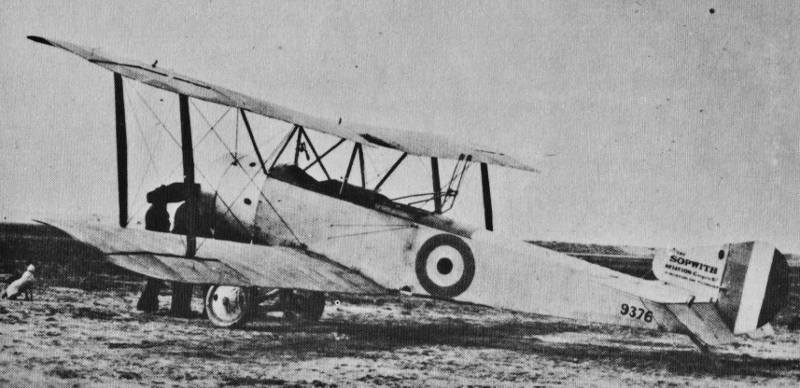
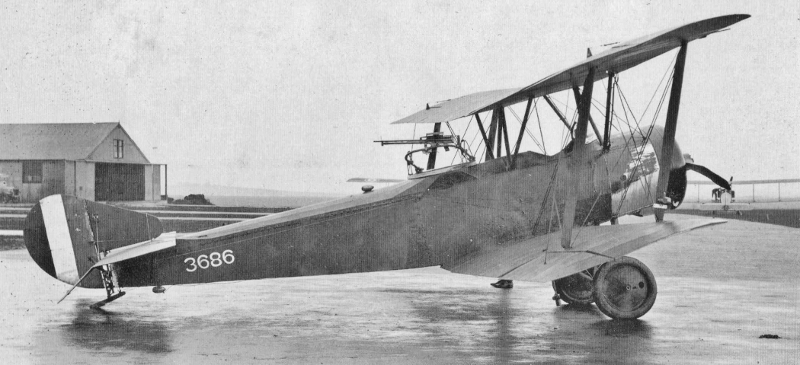
The British Scarff No.2 ring mounting has been designed by Warrant Officer F W Scarff of the Admiralty Air Department with the assistance of the Sopwith Company. It is similar in concept to the Nieuport but has short curved runners to guide the gun frame with bungee cords to counter balance the weight of the gun and is less cumbersome. The prototype “1½ Strutter” at Eastchurch now has one fitted. (above right with gun attached)
In both cases the Lewis machine gun mounted on the gun frame can be angled up and down but the Scarff offers the gunner the added flexibility of 180ᴼ horizontal rotation of the gun on the frame. To go with these gun mountings Sopwith have developed a special gunner’s seat capable of all-round movement about an eccentric pivot on a fixed stand. This locks in position when the gunner puts his full weight on it and is free to revolve when relieved of some weight. Both ring mountings are in short supply and some machines have rear guns on a single pillar mount. (below with RFC at Farnborough)
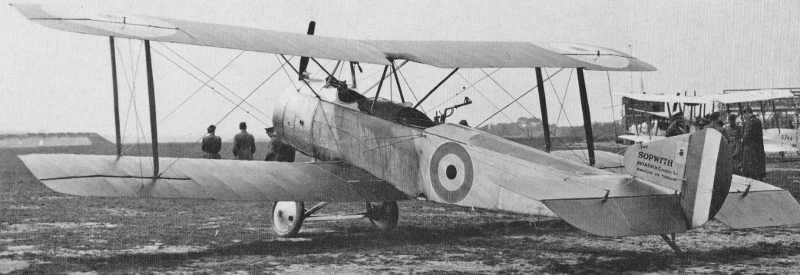
Note that the first two RNAS “1½ Strutters” above have no forward firing gun although 9376 is being fitted in the field with an over-wing Lewis machine gun. The RFC machine has a faired-over synchronised Vickers gun.
On 10th May prototype “Pup” 3691 is flown by Fl Lt R C Hardstafff from Brooklands to K Section at Chingford which now seems to be a valuation group for prototypes despite RNAS Chingford’s main role as a flying school.
On 11th May “Schneider” No.1559 which performed the first deck take-off from HMS Campania last December and has continued to serve with her, is damaged and will be deleted from service. On 12th May “Baby” floatplanes Nos.8130 & 8131 appear at Killingholme after six months in the Central Stores Depot at White City. On 15th May the only Sopwith machine at Dover “Schneider” No.1573 is deleted after nine months there.
On 15th May the Admiralty report on outstanding aircraft orders shows the last two “Baby” floatplanes delayed a month to 3rd June and another eight “1½ Strutters” delivered (now twenty-eight) with four promised 20th May and soon expected to reach seven a week.
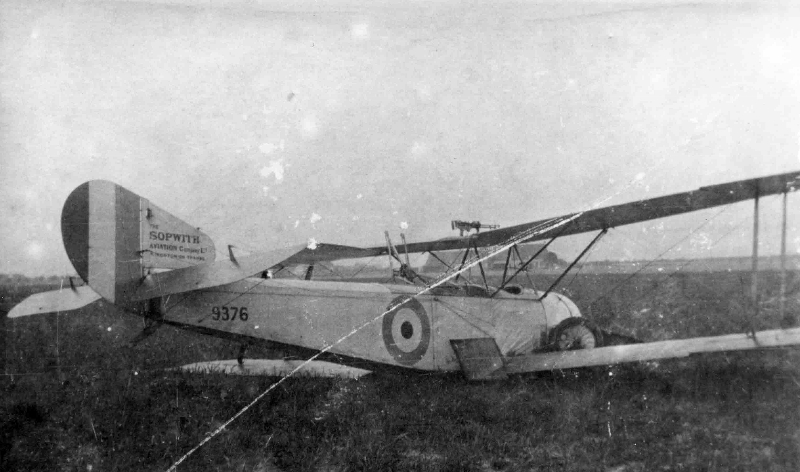
Around 15th May Fl Sub Lt Hervey crashes Sopwith “1½ Strutter” 9376 of 5 flight A Squadron 5 Wing of the RNAS based at Coudekerque. If this photograph (above) is of that event, the machine now has a Nieuport ring mounted rear gun and, unusually, another Lewis gun atop the wing firing forward but impossible to reload once the 47 round drum has been used. Clearly shown are the air brakes next to the fuselage on the trailing edge of the lower wings. Coming up 90ᴼ they are a unique feature of “1½ Strutters” but cause much vibration and are rarely being used.
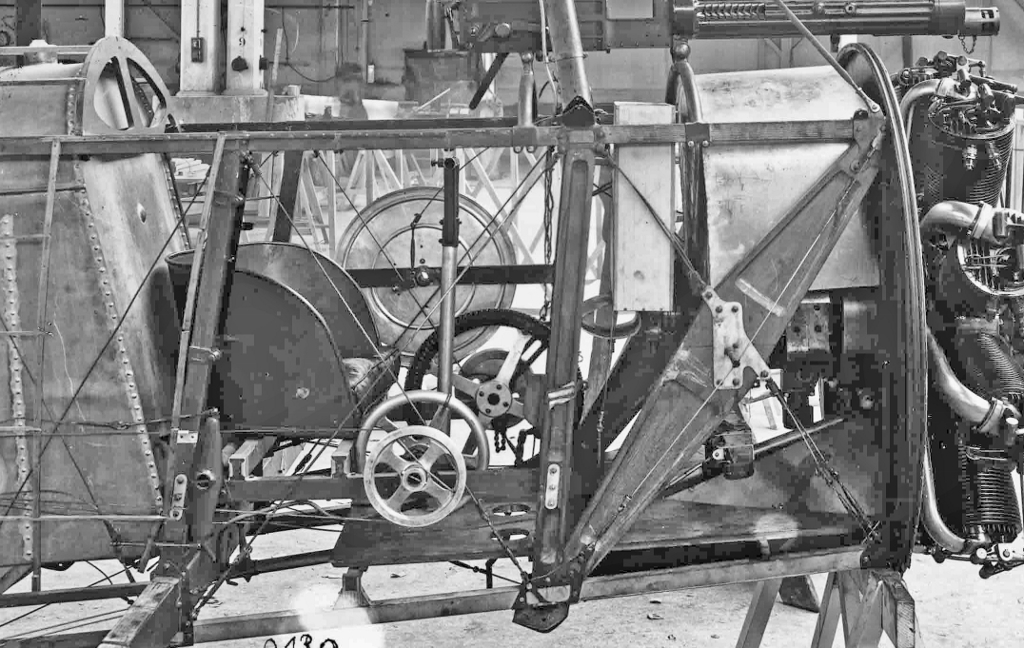
This cockpit photograph shows the 40 gallon tapered main fuel tank behind the pilot’s seat which gives around 4 hours endurance and the 9½ gallon oil tank behind the engine required for the total-loss oil system. In addition to conventional 3-axis control via rudder pedals and a vertical control column for the combined movement of elevators and ailerons, the pilot has large handwheels on either side of his cockpit. The front one in the picture (ie starboard side) controls the variable incidence tailplane required to balance the aircraft for different weights in the observer/gunners cockpit which is behind the main fuel tank and way behind the centre of gravity of the aircraft. Cords from the pulley on this handwheel run back to turn a bottle jack vertically fixed in the very rear of the fuselage which raises or lowers a tall screwed tube which in turn raises or lowers the trailing edge of the tailplane and its spanwise bracing wires. (diagram below left) The front (main) spar of the tailplane pivots about a hinge on top of the fuselage to allow the ± 2ᴼ changes of incidence. This mechanism is the subject of a patent application by Mr T O M Sopwith and the Sopwith Aviation Co.
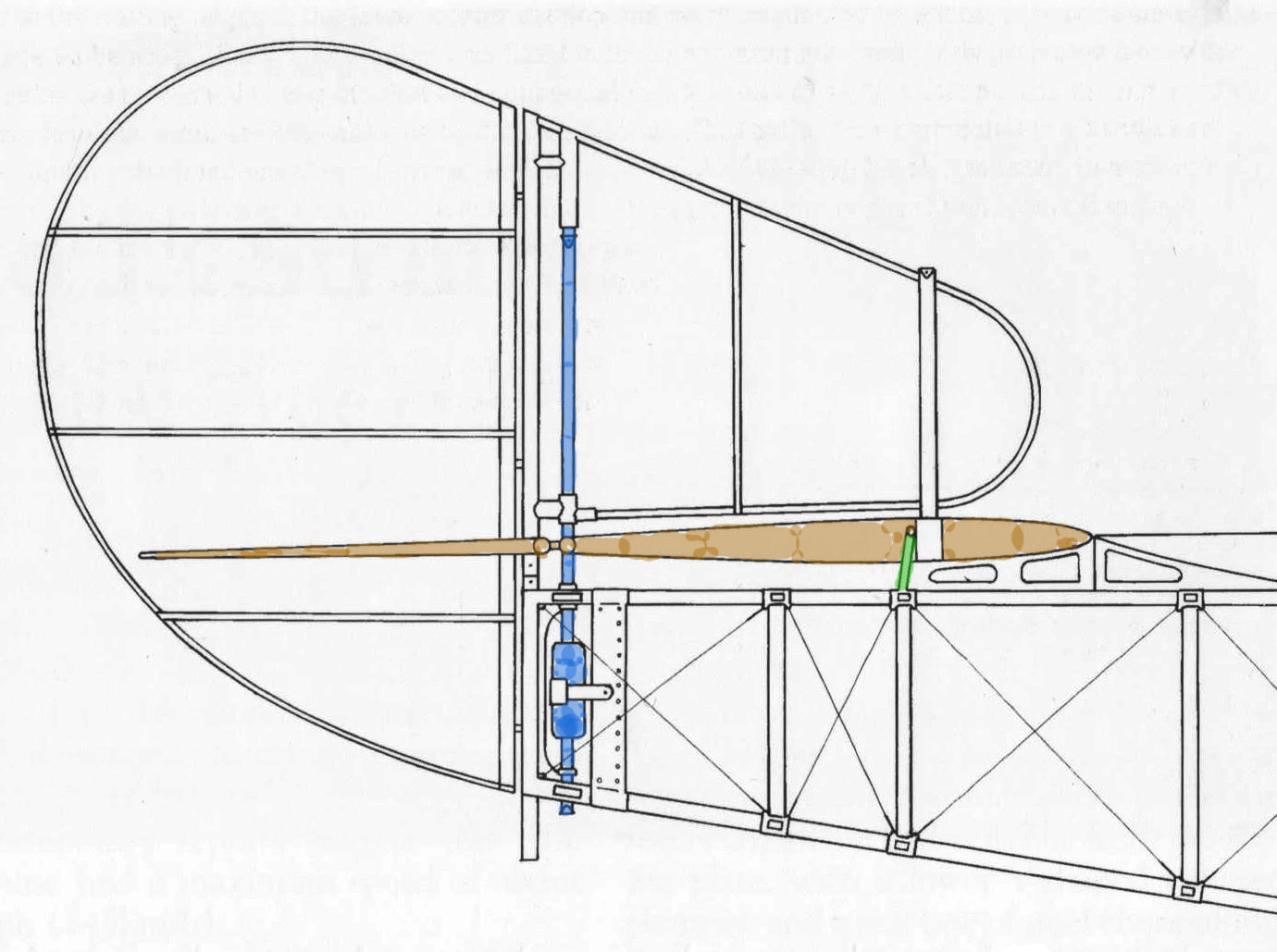
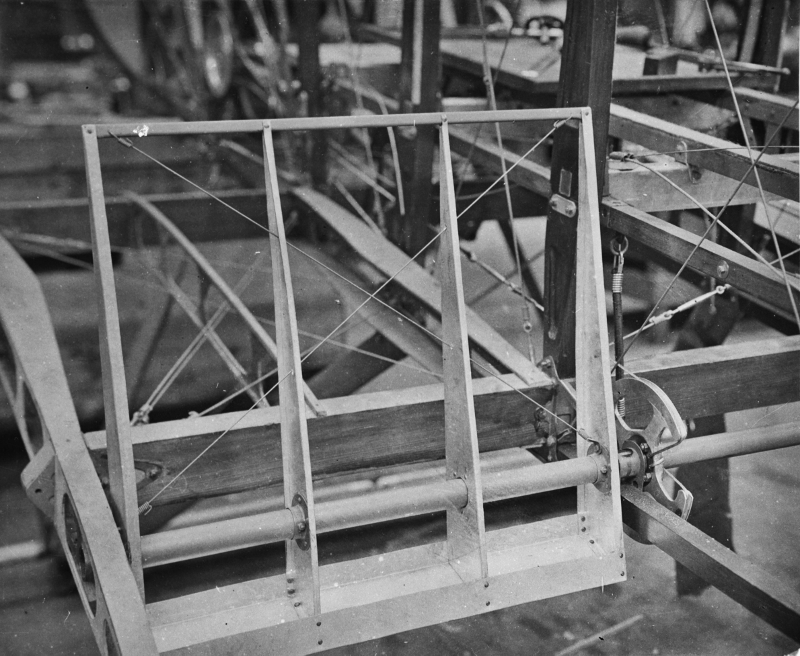
The even larger handwheel on the port side of the cockpit is to actuate the air brakes. This turns a sprocket and short length of chain joined at both ends to cables which run back to turn the quadrant on the cross tube on which both air brakes are mounted. (above right). This tube is at about 1/6th of the chord of the brakes so that the leading edge comes out beneath the wing to provide some counter-balance. The handwheel in the cockpit has a locking handle for any airbrake position up to 90ᴼ.
On 18th May another RNAS 5 Wing “1½ Strutter” 9384 is the first to be attacked by an enemy aircraft. Fl Lt Viney and observer Fl Sub Lt Blagrove up at 11.50am to cut off an enemy machine reported over Dunkirk, are attacked at 9,000ft in bad visibility by an Aviatik or Albatross which opens fire from its rear gun. A whole tray is fired in return before the pilot turns and fires half a tray from his front gun. The enemy aircraft sheers away. The observer clearly sees the tracer bullets which hit the “1½ Strutter” but with “no damage of importance”.
On 19th May seven German floatplanes launch their most ambitious night raid to date on Kent coastal towns from high altitude leaving one dead and two injured. Grain based “1½ Strutter” and two “Baby” floatplanes go up but too late. One of those, No.8151, goes out again on 21st May but capsizes on its return and is wrecked.
On 21st May Fl Lt Huskisson and Lt St John in RNAS 5 Wing “1½ Strutter” 9385 engage three enemy machines “some of which are hit before they were driven off”. Another group of six machines are sighted including “a fast two-seater with chocolate coloured swept wings and a gun firing through the propeller”.
The Admiralty report another five “1½ Strutters” delivered this week (now 33) with seven promised next week.
On 24th May A Flight of 70 Squadron RFC, equipped with overseas kit including revolvers, line up their “1½ Strutters” by the airship sheds at Farnborough for final checks and inspection (below) before flying to St Omer, 20 miles south-east of Calais. Three go down en route with engine troubles but get to St Omer the next day. According to observer/mechanic Joe Taylor “morale is very high. Everybody feels that the “1½ Strutter” is a winner and a match for anything the Germans have”.

The War Office have acted promptly on Trenchard’s request for a squadron of “Pups” by placing an order on 22nd May for 50, not on Sopwith Aviation who are a busy and an Admiralty supplier, but on the Standard Motor Co. of Coventry who have been building Royal Aircraft Factory BE12 aircraft for the RFC for a year or more.
The Admiralty are keen to get more “1½ Strutters” out of the Sopwith factory and have agreed with Sopwith that a further order for 30 “Baby” floatplanes and future development of the type should go to the Blackburn Aircraft Co. Remarkably In the five months since the first flight of the “1½ Strutter” Sopwith have become high profile fighter aircraft designers and their floatplane designs are now to provide a platform for the growth of fellow aviation pioneer Robert Blackburn’s company also using a roller skating rink factory but in Leeds.
The Admiralty are also keen to get more “Pups” and the innovative prototype “Clerget Triplane” which is nearing completion in Kingston.(below) The distinctive single wing struts and narrow wings with the middle one at the pilots’ eye level should provide much better all-round visibility than the “Pup” and an even greater rate of climb.
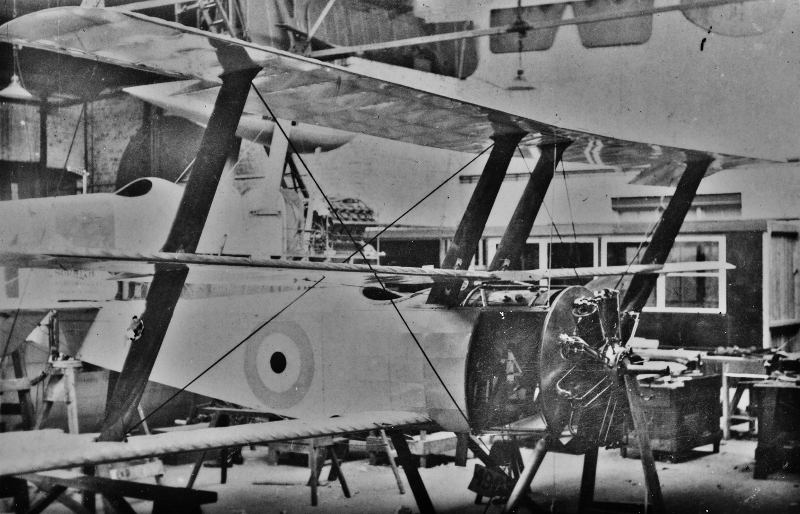
Behind the “Clerget Triplane” is the much larger private-venture “Long Range Tractor Triplane” (LRTTr) with Rolls Royce V12 engine and a streamlined pod between the centre struts up where the top wing will be.
On 25th May prototype Sopwith “Pup” 3691 arrives at Grain. ‘Y’ Section of the Admiralty Air Department has now completed trials to obtain a satisfactory belt feed for the ammunition of its Vickers gun. At 12.15pm on 28th May Fl Lt L H Hardstaff leaves Chingford and flies it via Dover to Dunkirk to go on to A Squadron RNAS 5 Wing for active service trials. It is still in its original finish of natural fabric, varnished wood and bare metal. (below)
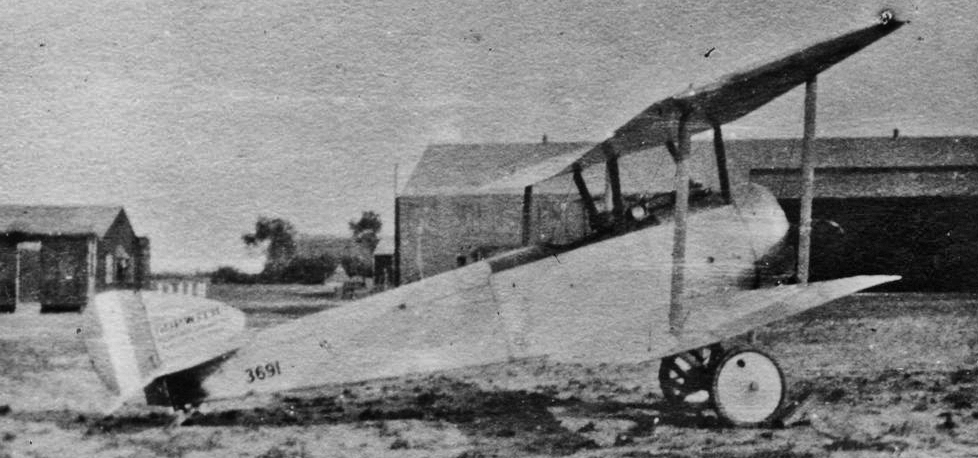
Also on 28th May the prototype Clerget powered “Triplane” is cleared by the Experimental Department in Kingston and sent by lorry to Brooklands for re-assembly and flight testing. The Admiralty report that they did not get their seven “1½ Strutters” last week and only expect four this week whilst “Baby” floatplane No.8139, busy at Yarmouth for six months, is wrecked on patrol, towed to harbour but sinks.
Both sides expect aerial reconnaissance to be a key feature of future naval battles. On 29th May the Royal Navy’s preparations for a major sea battle include five pilots flying Sopwith floatplanes from a trolley off the now extended foredeck of HMS Campania while she steams at about 20 knots. This avoids the often disastrous water-borne take-offs and should extend the weather conditions in which aircraft can operate at sea.
The German plan is to use their submarines and battle fleet to shell Sunderland to bring out some British warships and direct the ensuing battle from a fleet of Zeppelin airships. Their submarines have been off the north east coast since mid May with orders to return on 1st June, so even with the weather too poor to launch the Zeppelins, the German Admiral goes ahead with his plan on 30th May. British intelligence gets wind of this and the British fleets sail at 11.30pm to meet east of the Long Forties. Campania loaded with four “Schneider”, three “Baby” and three Short floatplanes fails to get the message, sails too late to catch up and is sent back to a port for her safety. HMS Engadine launches a Short which despite a 900 ft cloudbase reports seeing the enemy turning, before landing to repair a fuel pipe and being told to return. There are no more floatplane flights.
For 36 hours 151 British and 99 German warships manoeuvre and counter-manoeuvre in the Battle of Jutland. 14 British and 11 German ships are lost with 6,000 British and 2,500 German lives before the German fleet retreats to port. During the battle five Zeppelins did go out when the wind abated but saw nothing from their height in the poor visibility. Had she been there, would HMS Campania’s Sopwith floatplanes have been able to fly off her deck and make significant contributions to British tactics despite the wind and low cloud?
On 30 May 1916 whilst the Battle of Jutland is getting underway at sea the first as yet unarmed Sopwith 110hp Clerget powered “Triplane” is photographed with some of the works team at Brooklands. (below)
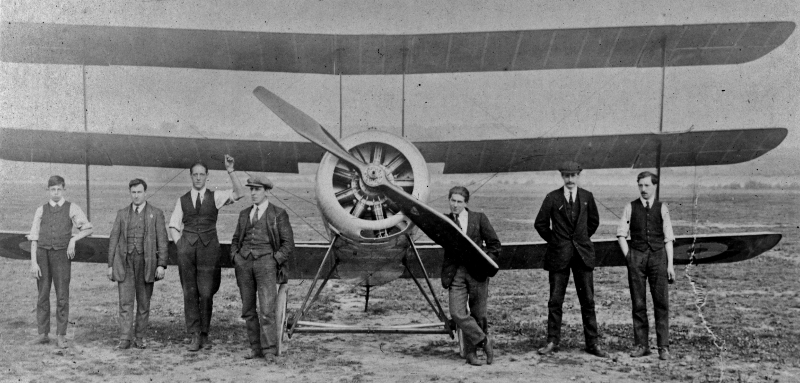
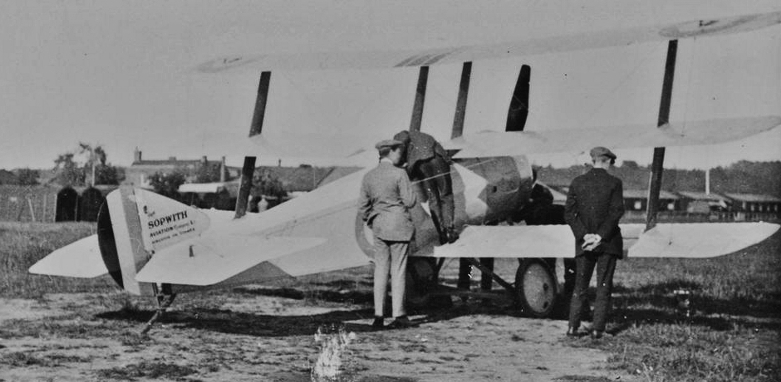
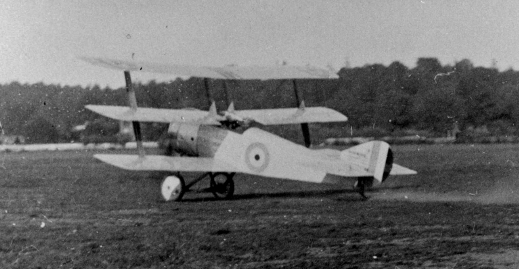
Tommy Sopwith is there (in the light suit above left) as final preparations are made and Harry Hawker takes off on the first flight. (above right, tailing dust from the tailskid). That he is happy with this new machine is obvious to all when he performs three loops over the airfield before returning smiling. (below)
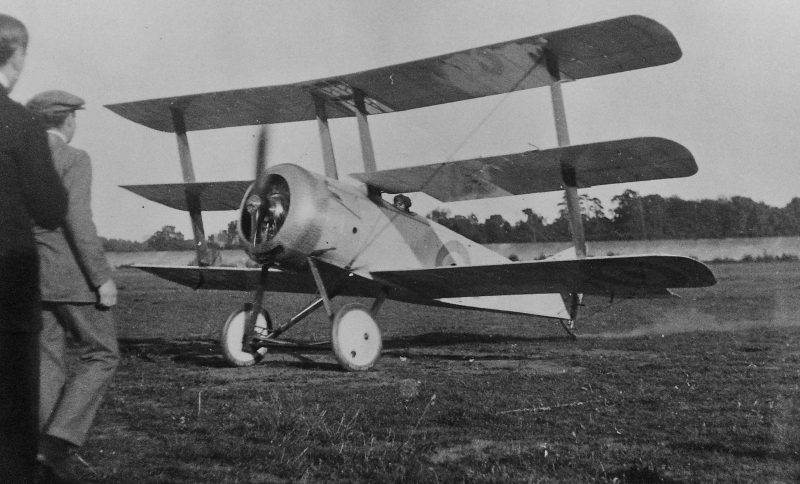
On 31st May “Baby” floatplanes 8128 & 8129 delivered to storage at White City six months ago are back with Sopwith being prepared to go engineless to the French Navy, whilst 8134 has gone to the Fairey Aviation Co. at Hayes. They have just made a patent application for camber-changing wings aimed at reducing floatplane take-off distances. The Admiralty has provided the “Baby” floatplane and an order for 6 sets of development wings.
Sopwith Works Cards show the first “Triplane” and a record 25 “1½ Strutters” completed in May. In the experimental shop work is progressing on the private-venture “LRTTr” (below) with its third seat in the gunner’s streamlined pod.
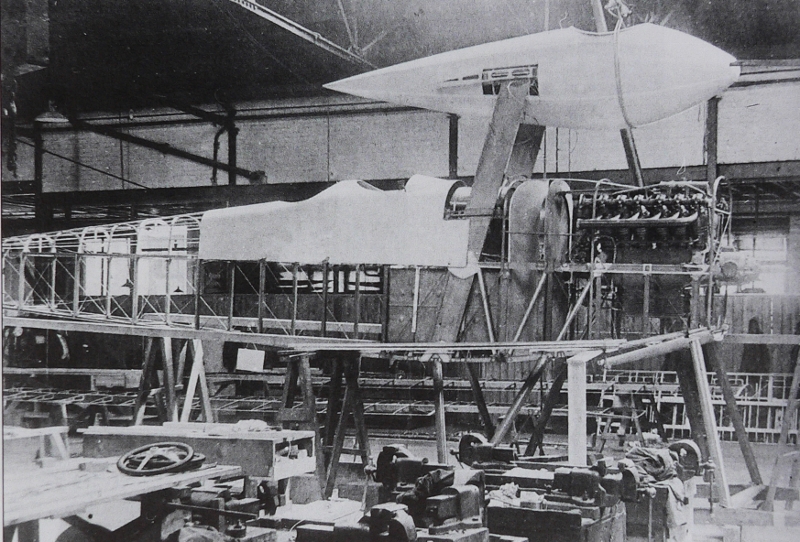
The RFC still only expect 20 “1½ Strutters” to be diverted from Sopwith’s Admiralty orders and the first rushed deliveries from the 100 order on Ruston Proctor are some weeks away when on 1st June the War Office order a further 200 “1½ Strutters” this time from the Leighton Buzzard factory of coachbuilders Morgan & Co. (No connection with Morgan Motors of Malvern)
For the first time other contractors’ orders for Sopwith aircraft significantly exceed their own. There are 380 on order from Ruston-Proctor, Blackburn, Standard and Morgan compared with Sopwith’s 109. This becomes 110 on 2nd June when they take an order for a second “Triplane”, this time with a 130hp Clerget, an extra 20hp.
On 2nd June Killingholme based “Schneider” floatplane No.3800 spins into the water after an engine failure and Fl Sub Lt D A Duncan is drowned.
On 5th June the Admiralty report a remarkable 17 Sopwith “1½ Strutters” delivered in the last two weeks to make 50 in total: 49 of the initial 50 order and 1 towards the next order for 100. 3 more are promised 10/6/16. Six of the 15 being transferred to the Royal Flying Corps are in France and most of the rest are at Farnborough.
On 5th June Lord Kitchener, Secretary of State for War and British military hero from the Sudan and Boer Wars, drowns with his staff and almost all the 655 aboard the cruiser HMS Hampshire when it strikes a German mine off the Orkneys on its way to Russia on a diplomatic mission. To the public this is a major national tragedy.
When the first Robey built Sopwith “Type 806” gunbuses arrived at Detling six months ago Lt Cdr R L Marix of Sopwith Tabloid Zeppelin destruction fame, flew one up to 12,000ft in 23 minutes declaring it “a very fine machine, which flew with hands off both while climbing and gliding”. Since four were destroyed by the storm and accident at Detling in January only eight more of the thirty have seen any service. All eight are now at Eastchurch but Nos.3839, 3842 & 3844 have recently been dismantled ready to be deleted from service. The image(below) of an Eastchurch “Type 806” during a test run of its exposed 150hp Sunbeam pusher engine underlines that they are outdated for front-line service and unnecessarily powerful for basic training.
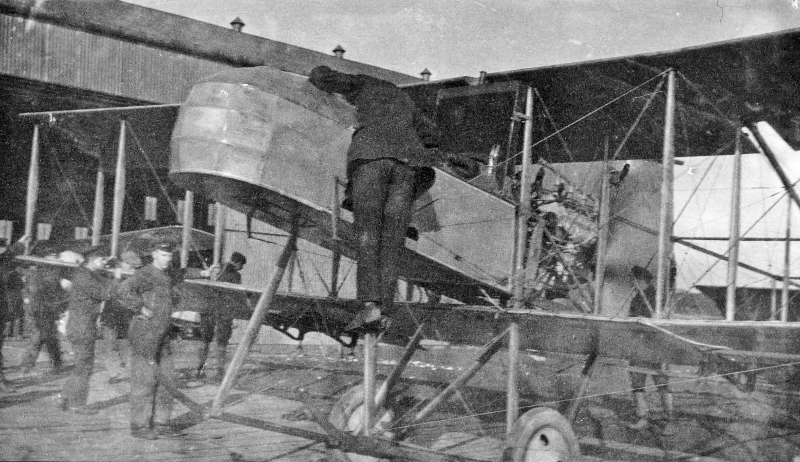
In contrast, 70 Squadron RFC’s single flight of “1½ Strutters” in France is now at Merris “doing some useful reconnaissance work”. When weather permits RNAS 5 Wing “1½ Strutters” at Coudekerque continue with training, testing and regular ‘fighting patrols’ in the Dixmude and Nieuport areas and are not meeting any enemy aircraft. The mostly Canadian pilots of RNAS 3 Wing at Manston in Kent are collecting their new “1½ Strutters” themselves from Brooklands and some after compass testing are being flown straight on to Dunkirk.
On 6th June “Baby” No.8132 delivered directly to store at White City six months ago appears at Yarmouth whilst 8135 & 8136 have come back to Sopwith from storage to have precious 110hp Clerget engines fitted.
Sopwith still only have orders for the three prototype “Pup” single-seat scouts when on 7th June the Admiralty order fifty production machines from Glasgow marine engineers William Beardmore & Co Ltd. Like the BE2 and Wight aircraft they have been producing since early 1915 these will be built in the original cabinet makers and joiners workshops at their Dalmuir shipyard. These have been allocated serial numbers starting from 9901 which becomes the official Admiralty type number for the Sopwith 80hp Scout nicknamed “Pup”.
Sopwith are aware that they have a production “Pup” order on the way from the Admiralty but only for twenty machines presumably to minimise the impact on deliveries of more urgently needed two-seat “1½ Strutters”.
On 14th May the swashbuckling, aggressive W Cmdr Charles Rumney Samson took command of the East Indies and Egypt Seaplane Squadron based at Port Said determined to be a painful and illusive thorn in the flesh of the Turks. He has three seaplane carriers. His own command HMS Ben-my-Chree has two “Schneiders” and up to four larger but folding-wing Short floatplanes. HMS Anne and Raven II carry up to four floatplanes each.
Floatplanes, pilots and about forty RNAS ratings are now permanently aboard Ben-my-Chree (below)which has three guns mounted mounted one atop the hangar at the stern and two in front of the foremast. They are a 12 pounder modified for anti-aircraft work, a 2 pdr pom-pom and 3 pdr carriage mounted gun. The latter is a relic from Samson’s early wartime armoured car adventures in France and Belgium.
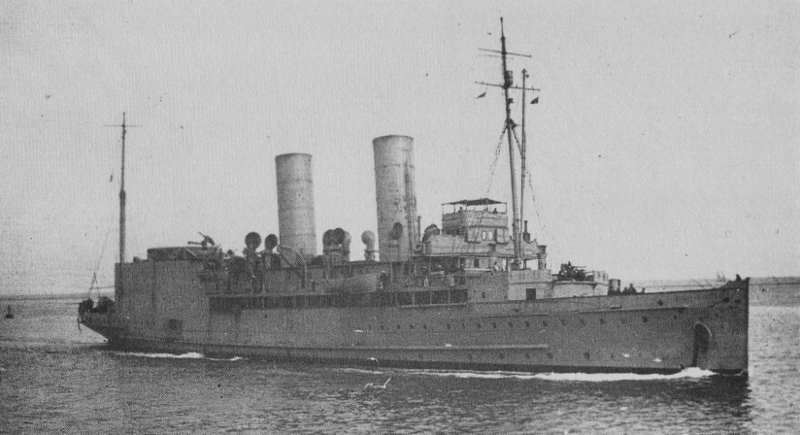
He has tightened up procedures and training, developing a technique for hoisting out floatplanes in just 30 seconds whilst underway by lowering them to within 6 to 12 inches of the water before releasing them with a slip toggle unfastened either from the ship or the aircraft. The retrieval is by landing and taxying the aircraft in the lee of the ship, stopping the engine and catching a heaving line to which the derrick’s hook is attached. Previously they stopped to send a motor boat to tow the floatplanes back. Not just for rapid response, these procedures help reduce the ship’s vulnerability to the growing threat of submarine torpedo attack.
In the last two weeks Samson has been supporting RN Monitors shelling forts, an airfield and Turkish positions along the coast of Palestine using the “Schneiders” for gun spotting whilst dropping small bombs and propaganda pamphlets. HMS Anne’s aircraft have also been bombing a Turkish fort, bridge, ammunition depot and railway stations with some limited success. On 8th June Samson goes down the Red Sea for four days of attacks on a detached Turkish force encamped behind Aden. He leads the bombing in a Short with two “Schneiders”, one with a 65lb bomb and 500 flechette darts and one with four 16lb and four incendiary bombs delivered from 500ft. On 9th June Samson flying a Sopwith “kills a number of Turks near Darb” but the greatest damage is to the enemy’s morale and relationships with the local Arab chiefs supplying them. On his way back up the Red Sea Samson makes concerted gun and bomb attacks on Turkish shore batteries at Sheikh Said.
Feisal’s Arab tribesmen and four British warships have Jeddah on the Red Sea coast besieged but are having no significant impact on the 3,000 Turks entrenched around the perimeter. On 15th June 1916 Cmdr Samson steams in with the replenished HMS Ben-my-Chree and her seaplanes. He and observer Lt Wedgwood-Benn in a Short photograph all the defences, attempt to bomb some guns and attack the Turkish positions with their Lewis gun before he has the heel shot off his right shoe and the propeller is hit causing severe vibration. One Sopwith “Schneider” attempts to breach the city wall with a 65lb bomb whilst the other shakes the Turks badly by flying at just 100ft along the trenches dropping a bomb and firing the machine gun. At dawn the next day, all set up to accurately bombard the Turkish positions, a white flag goes up and Jeddah surrenders. Samson writes “there is no doubt whatever that the three inefficient rather antiquated seaplanes took Jeddah”.
On 15th June there is another order for 100 “1½ Strutters” for the Royal Flying Corps this time on Vickers Ltd, not from their 1915 Weybridge works but their earlier Crayford works in Kent. The contract price is £848 each.
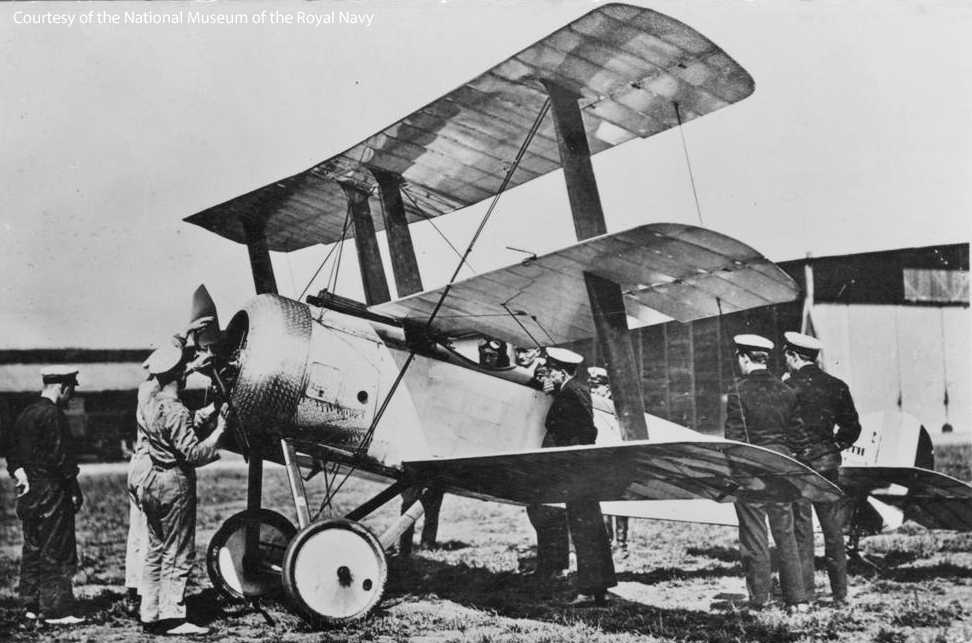
On 16th June, just 17 days after its first flight, Sopwith are happy enough with the prototype Clerget “Triplane” to hand it over to the RNAS. It is flown to Hendon and on to RNAS Chingford where it attracts a great deal of interest. (above) Now fitted with a Vickers forward firing gun with Sopwith-Kauper synchronising gear, it carries serial number N500, the first of the new N500 to N999 series set aside for prototype Admiralty landplanes.
On 17th June Blackburn get an order for a single Sopwith “Baby” strangely allocated out-of-sequence serial number N300 in the new N1 to N499 series for prototype Admiralty floatplanes and flying boats. It is to replace No.8201 which is going to Japan. Three have gone to the French Government and two are soon to go to Italy as manufacturing patterns.
Sopwith are starting to deliver “1½ Strutters” against their second order which is for 100 in a mixture of Type 9400S basic two-seat machines, Type 9400L long-range two-seat machines with an extra fuel tank and Type 9700 single-seat bombers with internal racks for four 65lb bombs in the place of the observer/gunner. Stored vertically the bombs are released though sprung trap-doors and can be checked via two inspection panels. (below)
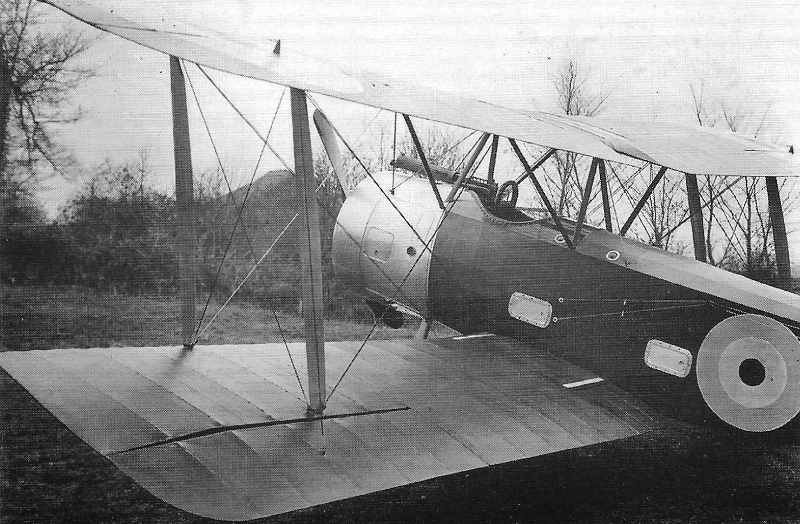
The first long-range 9400L has been accepted at Brooklands in the last few days as has the first 9700 “Strutter bomber” which is delivered to RNAS Dover on 19th June. These new versions are all going to the RNAS. Only standard Type 9400S machines are so far being diverted from the Admiralty order to the Army and many of those are without their Admiralty free-issue 110hp Clerget engines.
At the Sopwith Board Meeting on 20th June “Mr T O M Sopwith is empowered to sign the agreement with the French Government”. They also approve and seal a revised agreement with Ruston-Proctor of Lincoln who are building “1½ Strutters” and a tenancy agreement on the Kingston Polytechnic Club premises at 30 Fife Road.
On 21st June “Baby” floatplane No.8125 breaks a propeller at Scapa whilst taxying and is “severely damaged”.
On 22nd & 23rd June new trials launching floatplanes from HMS Campania’s lengthened foredeck use long sloping boards up on trestles and grooved to the width of the tail floats to support the machines in flying attitude and guide them as they accelerate away on their wheeled trolleys. Each held back by 12 air mechanics until a flag is dropped, a pair of Sopwith floatplanes are launched one behind the other within one minute using 80 and 145ft of deck “against a relative air velocity of 35mph”. A heavier two-seat Short is held back mechanically with a steel clip remotely released by a cable. All the trials are “entirely successful”.
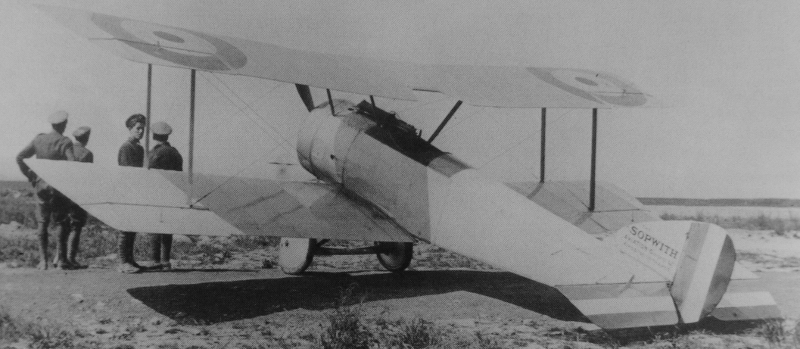
On 22nd June the prototype 80hp Sopwith “Pup” 3691 undergoing service trials with A Flight RNAS 5 Wing at Furnes near the Belgian border (above) is joined by the prototype 110hp Sopwith “Triplane” N500 (below).

On 23rd June seven of the most experienced pilots file test reports which are unanimous in their praise of the Sopwith Triplane. These are typical comments: Range of Vision: “Exceptionally good.” “Exceptionally fine in particular the upward view.” “ Undoubtedly better than is obtained from most single-seat biplanes.” Rate of climb: “Extraordinarily good.” Range of speed: “About 100knots to 55knots, landing about 30Knots.” “Has a remarkable turn of speed.” Glide: “Very flat.” “No tendency to float at very low speeds, very useful for work in windy weather.” Controls: “Very responsive and easily handled no tendency to slip on heavily banked turns.” “Machine answers all controls with exceptional ease.” “Rendered stable fore and aft at any angle of climb or descent by the adjustable tail. A very great advantage in a single seat fighter.” “Very sensitive on rudder and aileron controls.” Engine controls: “Being on left side make the control of the engine very simple on landing.” General remarks: “Machine seems exceptionally well suited for aerial fighting.” “A distinct advance on the Sopwith 80hp biplane.” “Widening of the chassis has greatly added to the easy landing of this machine.” “This machine is the most perfect I have ever flown, it can be dived without gaining a phenomenally high speed, as a fighting machine it leaves nothing to be desired.” “Far superior as a fighting machine to anything we have at present on the station.” The pilot’s reports and a summarised conclusion are forwarded via Commodore Dunkirk to Vice Admiral Dover Patrol with a request that they be forwarded to the Director of Air Services, no less. Squadron Commander Ogilvie’s conclusions are brief and to the point. “This machine is undoubtedly far in advance of any fighting machines possessed by ourselves or the Germans as regards performance and fighting qualities. From the way it has been flown and handled by different pilots it is quite evident that it is strong enough. It is considered that the peculiar structure of the machine will enable it to stand more bullets and shrapnel without collapse than the ordinary types. The machines could be improved upon in the following points: a) the petrol system should be duplicated and tanks for at least two hours supply should be fitted. b) seat adjustable over 3 or 4 inches fore and aft for different sized pilots. It is suggested that a batch of these machines be turned out immediately without alteration and the design with one or two suggested improvements proceeded with for the second batch.” A fellow Flight Commander adds a handwritten note that “1¾ hours fuel should be accepted if the larger tank delays production or detracts from performance.” The Senior Officer RNAS Headquarters Dunkirk agrees adding that “it is of the utmost importance to obtain the latest machines before they are out of date and it is recommended an order for at least 20 of these is placed as soon as possible even if no engines are available since the 110hp Clergets from the Nieuports will probably be available by the time they are built”.
On 23rd June the Society of British Aircraft Constructors (SBAC) holds its first Ordinary General Meeting at the Hotel Cecil. They discuss the problems with the calculation of the Excess Profits and the proposed increase in Excess Profits Tax from 50% to 60% in this year’s Finance Bill, the state of negotiations with the Ministry of Munitions and the acceleration of aircraft output. They also consider an enquiry about women’s wages from a special arbitration tribunal operating under the Munitions of War Act 1916.
Despite urgent demands for other prototypes, Sopwith’s experimental department have finished the private-venture Rolls-Royce engined three-seat “Long Range Tractor Triplane” (LRTTr). To go under the railway bridge in Kingston they have removed the top pod, wheels and tail fin. Posed half way through its 10 mile journey to Brooklands by a banked-up reservoir at Molesey (below), it makes an interesting size comparison with the single-seat Triplane. The experimental team have already started work on two more experimental Triplanes, two-seaters using Hispano-Suiza V8 engines.
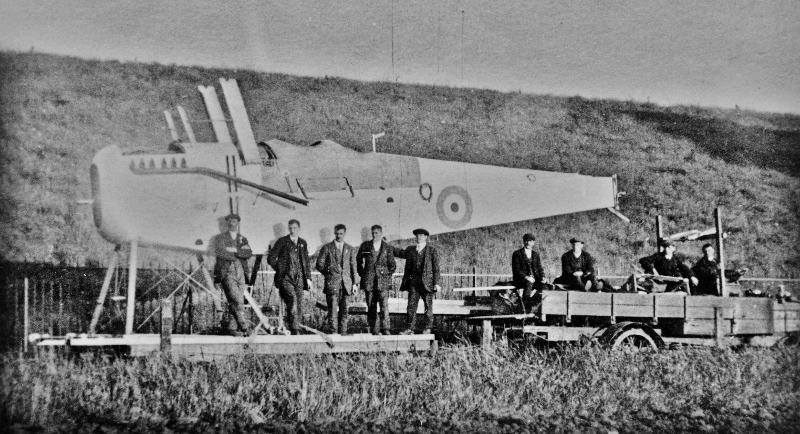
On 24th June HMS Vindex’s four “Baby” floatplanes move to Dunkirk to escort two-seat floatplanes and supplement the Navy’s defence ring of RNAS stations at Killingholme, Yarmouth, Felixstowe and Eastchurch against the continuing threat from submarines, Zeppelin airships and increasing numbers of German seaplanes.
On 24th June there is a further RFC “1½ Strutter” order this time for 50 on Hooper & Co. 77 King’s Road, Chelsea a first foray into aircraft for the renowned motor body builders and coachbuilders by Royal Warrant since Queen Victoria. The Admiralty have also ordered more ”1½ Strutters”, 10 from Sopwith and on 25th June 50 from Norwich motor engineers and coachbuilders Mann, Egerton who have already built Short floatplanes.
On 25th June RNAS 1 Wing uses “1½ Strutter” 9419 to test a new camera and reports 10 plates taken at 14,000 to 15,000ft over Dunkirk are entirely satisfactorily despite poor visibility and cloudy conditions.
On 26th June at St Omer 70 Squadron RFC fire the Vickers gun with Vicker’s own synchronising gear on “1½ Strutter” 5719 at a ground target from 100ft at 200 yards range. The third attempt gets a close cluster just 2 ft off target. They now plan to change the Vickers rear sight for a locally manufactured one which has a spread of thin vertical wires to guide pilots with the deflection firing needed for aircraft passing across the line of flight.
With a major offensive planned on the Western Front, Hugh Trenchard has been impatiently urging faster supplies of aircraft but instead is hearing about delays to planned deliveries especially French aircraft and engines. Henderson puts the RFC’s dire shortage to the Air Board which asks the Admiralty to divert up to 60 RNAS machines to the RFC. Assured that they will not be asked for any more, they agree on 28th June subject to keeping their Home Defence and Dunkirk forces up to strength and continuing with their strategic bombing.
Sopwith’s works record cards show twenty aircraft sent on to Brooklands during June for test and delivery, the “Triplane” and nineteen more “1½ Strutters” including the first few single seat “1½ Strutter Bombers”. This brings the total “1½ Strutters” ex-works to seventy-three of which the latest Admiralty report recognises sixty delivered with four promised 1/7/16. At least twenty of those have been seconded to the Royal Flying Corps. The RNAS ones are scattered thinly around Cranwell, Chingford and Eastchurch but most are for France. Around fifteen are with RNAS 5 Wing at Coudekerque. A few have reached RNAS 1 Wing at St Pol and some more including the first “1½ Strutter Bombers” are with RNAS 3 Wing working up at Manston and starting to fly aircraft to the specially built strategic bombing airfield at Luxeuil in south-east France close to the German border. The most active are 5 Wing on fighting patrols close to the coast over Nieuport, Furnes and Dixmude.
On 29th June Ruston, Proctor & Co. fly their first “1½ Strutter” 7762 from the No.4 Aircraft Acceptance Park on Lincoln’s West Common racecourse, its two 150 x 20 yard turf landing strips being updated to a 250 yard circle.
With the “1½ Strutters” of A Flight of the Royal Flying Corps’ 70 Squadron out in France since late May it is now the turn of B flight. They are photographed at Jersey Brow, Farnborough (below) possibly about to be inspected by King George V. With the much preferred Scarff rear gun mounting in short supply most have the unpopular Nieuport mountings. They carry A suffix serial numbers, all the plain numbers to 9999 have been allocated.
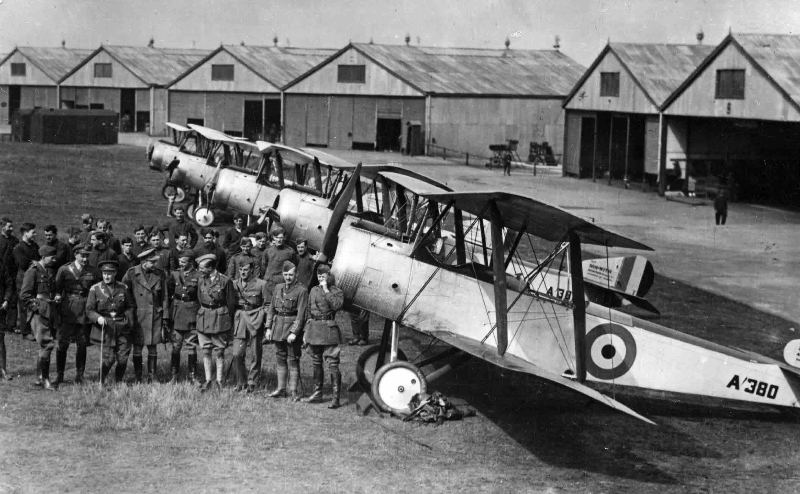
On 29th June B Flight fly off to Fienvillers 15 miles behind the British front line on the Somme where 70 Squadron is part of the RFC IX Wing attached to BEF Headquarters. Its primary role is offensive patrols deep into German territory to gather strategic intelligence by photo-reconnaissance and to attack often heavily defended enemy installations and supply lines in cooperation with other units including 27 Squadron’s slower but useful bomb-load Martinsyde G100 Elephants.
For some days other RFC squadrons have been helping direct the bombardment of German entrenchments and artillery positions all along the Western Front. Early in the morning on 1st July British forces make a bold attack on German trenches along the Somme valley falsely believing they must have been largely obliterated. By the end of the day, with very little ground won, over 19,000 British troops have died.
Elsewhere on 1st July Australian Fl Sub Lt Dallas in prototype Sopwith “Triplane” N500 attacks two large enemy biplanes off La Panne on the Flemish coast firing 40 rounds into one which nose dives towards the sea. His gun jams and he is attacked by the other aircraft but escapes. This is the first combat action by a British Triplane.
Sopwith “1½ Strutters” are suffering the inevitable losses during their introduction, on 21st May 5 Wing Fl Lt Viney died when his aircraft came down behind the lines in Belgium and on 10th June a French pilot and 3 Wing British co-pilot were killed in a flying accident. Now on 1st July 5 Wing’s 9394 crashes beyond repair and on 2nd July 70 Squadron’s A383 side slips and nose dives into the ground during an engine test injuring both on board.
On the evening of 2nd July a typical 70 Squadron reconnaissance sortie started with two Martinsydes and two “1½ Strutters”. One Martinsyde has an engine problem and one is damaged in a fight leaving the Strutters to the crucial work over enemy territory with the rear machine fighting off six hostile aircraft to get back home.
The last survivor of the six Sopwith-built Sunbeam engined Type “806” gunbuses No.803 is now deleted from service at White City and only No.3847 at the RNAS Eastchurch Gunnery School is still in service of the thirty similar Robey-built aircraft. All the rest have perished or been deleted from service, including eleven which never got any closer to active service than the RNAS Central Stores Depot at White City.
Now the last Sopwith “SS3” Tabloid Scout No.1210 is deleted after 15 months service at Eastchurch, the end of a famous line which evolved from Harry Hawker’s startling November 1913 80hp “St B” Tabloid stunt-bus.
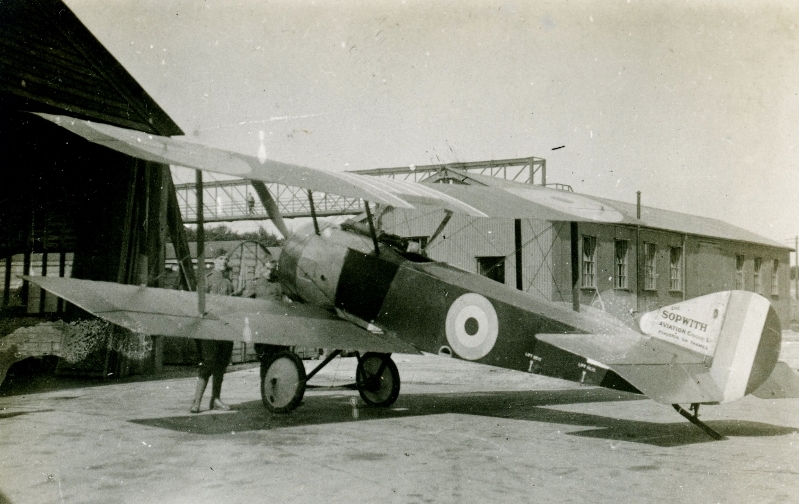
The second Sopwith “Pup” 9496 is now complete and photographed outside Sopwith’s original sheds at Brooklands (above). Learning from the first prototype, the undercarriage is much taller, it has an adjustable tailplane and the top wing centre section is covered with transparent material for better visibility. (see below)

After the 80hp Le Rhône engine in the first prototype, the Admiralty order for these next two was for 100hp Monosoupape Gnomes (both nine cylinders) but recently switched to a third French rotary engine the seven-cylinder 80hp Clerget. Twenty-six have been bought from French suppliers and small numbers have been made since January by centrifugal pump pioneers and Clerget licensee Gwynnes of Hammersmith and Chiswick.
There are reports that the second prototype Sopwith “Triplane” N504 is flown from Brooklands to Chingford and back on 2nd July by Harry Hawker. If true, it has a 110hp Clerget whilst awaiting its intended 130hp Clerget.
On 2nd July HMS Raven is on reconnaissance along the Sinai, Palestine and Syrian coast when “Schneider” floatplane 3786 fails to return from a flight over Haifa and Acre. Their Short floatplane goes searching and spots it wallowing half a mile offshore. Landing close by and stopping the engine, a Lewis gun is used to sink the “Schneider”, whilst pilot Fl Sub Lt Man swims across. His engine failure was due to a fractured tappet rod which broke two more as the engine revolved. The Short crew fly Man back to Raven astride the petrol tank.
On 4th July “Baby” 8186 makes a forced landing and is towed back to Felixstowe with damaged engine and floats. On 6th July “Baby” 8173 capsizes off the slipway at Yarmouth on take-off. Only the engine is salvaged.
On 6th July the War Office place an order for 100 “1½ Strutters” this time on Fairey Aviation of Hayes. In just four months more than a thousand new Sopwith aircraft have been ordered for the RFC and the RNAS – 867 “1½ Strutters”, 123 “Pups”, 2 “Triplanes” and 31 “Baby” floatplanes. 192 of these recently ordered aircraft are to come from Sopwith’s own factories in Kingston and 831 from nine other manufacturers all over the country. These orders more than triple the previous 413 total orders for all Sopwith aircraft types since the company started in 1912, 267 of which were “Schneider” & “Baby” floatplanes. Four months ago even the confident Sopwith team could not have imagined quite this level of demand for their innovative aircraft.
The French also recognise the superiority of “1½ Strutters”, seeking help from RNAS machines and taking a licence agreement with Sopwith for manufacture in France. On 6th July the Sopwith Board approve a bank account for their new French subsidiary with its 21, Rue du Mont-Thabor office in central Paris. With T O M Sopwith as Directeur Général, it is to be run by Alan Fenn as Sous Directeur à Paris and his brother M H Fenn.
At 5am on 7th July three RFC 70 Squadron “1½ Strutters” reconnoitre railways radiating from Cambrai. Capt Cruikshank in 5719 gets separated and is attacked in a running fight with three Fokkers for 20 minutes. His observer is wounded and his aileron cable cut but he gets back to the British lines. The observer 2nd Lt Cruikshank dies in hospital. On 8th July 70 Sqdn “Strutter” A384 suffers a direct anti-aircraft hit and goes down in flames east of Arras, Capt Veitch is killed and Capt Whitty dies of his wounds. On 9th July RNAS 5 Wing make 24 coastal patrols but with prolonged high-altitude flying the cold is thickening gun oils and even freezing the moisture absorbed by the Vickers canvas ammunition belts. After a few rounds the Vickers gun jams on “1½ Strutter” 9405 after spiralling down from 14.000ft to attack three enemy aircraft. However the observer fires a Lewis drum and one machine noses towards the sea. That same day 9667 is the first “1½ Strutter” engaged in home defence, going up from Manston in a vain attempt to intercept a German aircraft at high altitude.
On 9th July Russian cavalry officer 2nd Lt A Nelidov collides with Calshot pier whilst taxying “Schneider” 3765.
On 10th July the second prototype “Pup” 9496 with its 80hp Clerget engine is accepted at Brooklands and flown to RNAS Chingford for testing whilst the first “Pup” 3691 moves from RNAS 5 Wing to RNAS 1 Wing at Furnes.
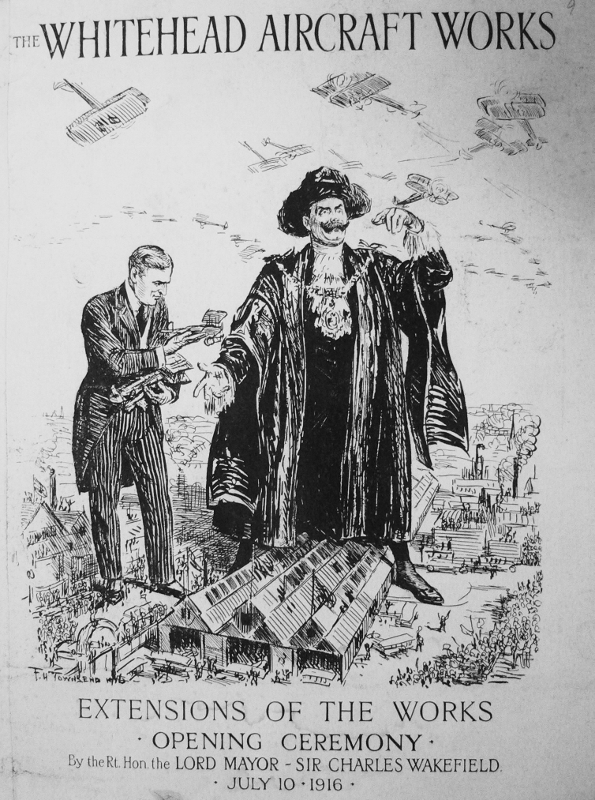
Also 10th July entrepreneur, ex timber merchant, Jack Whitehead invites the Lord Mayor of London to open his new aircraft factory in Richmond upon Thames in a blaze of publicity. As visitors enter the building there is a large banner declaring “There is no fun like work”. Just 14 months from establishing the Whitehead company and confident of large sub-contract orders from the War Office, he has added a 300ft x 70ft wide erecting shop, a new saw mill, a covering shop and a very modern fan ventilated doping shop all powered by electricity from two 50hp suction gas plants. Aeroplane magazine recently reported that “anyone visiting the Whitehead works after an interval of just two or three months will be astonished at the developments unless familiar with the extraordinary energy and resource of Mr Whitehead himself”. On the company’s recent first anniversary he took 300 of his 600 “Whitecraft Boys and Girls” employees on a day trip to Southend in a hired train.
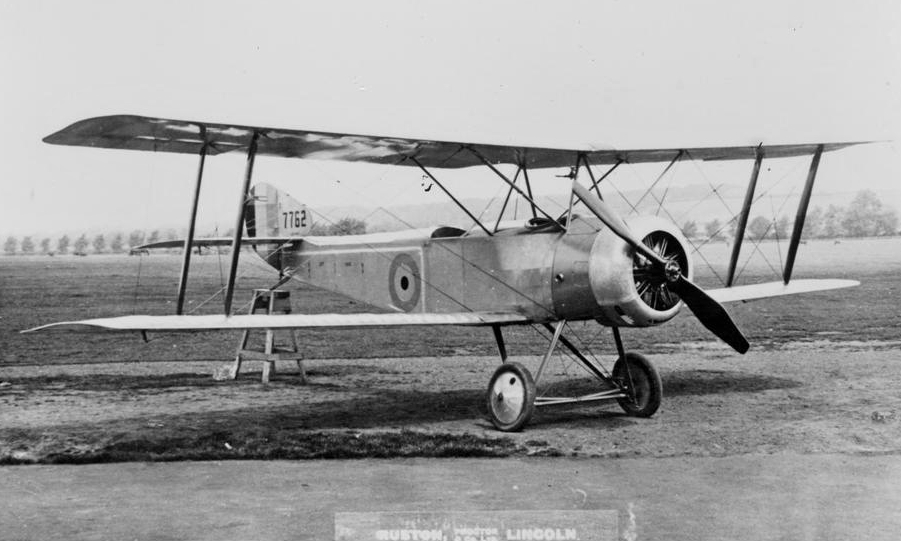
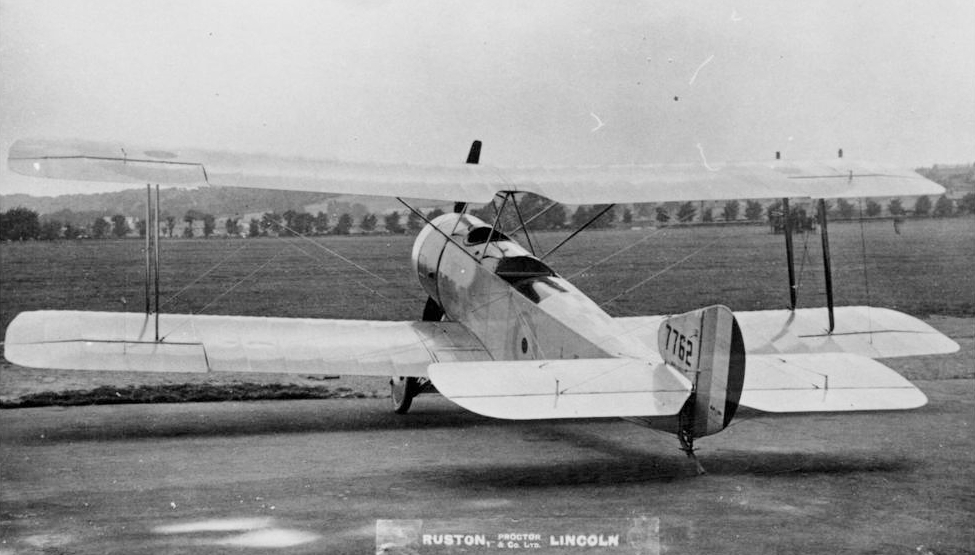
Since its first flight on 29th June Ruston-Proctor have made a photographic record of their first “1½ Strutter” 7762 (above). Their minor improvements include increased diameter engine cowl, undercarriage reinforcing plates and extra bracing wires, extra strands on the tail-skid shock absorber and 16 gauge bracing wires for the top-plane. On 11th July it is delivered by Mr Keith-Davis from Lincoln’s Aircraft Acceptance Park to Farnborough where its measured speed is 107 mph and it climbs in 2mins to 2,000ft, 8mins to 6,000ft & 16mins to 10,000ft.
In France on 11th July 70 Squadron “1½ Strutter” A878 on reconnaissance over Cambrai gets shot up in combat with three enemy aircraft but gets back to base. In the last 9 days four more “1½ Strutters” have been seriously damaged not by enemy action but by engine, piloting and other issues. In France A380 strikes a fence during a forced landing, 7998 strikes a hole in the airfield on landing and A383 is “wrecked”, as is 9408 at Manston.
Interestingly, on 11th July another damaged Manston aircraft is sent to new “Strutter” sub-contractor Fairey.
On 12th July Senior Officer RNAS Dunkirk gets a telegram from the Admiralty Director of Air Services demanding the flight test reports on the Sopwith Triplane which are “delaying decisions on aircraft orders for the current quarter”. He replies curtly that he sent them via Commodore Dunkirk and Vice Admiral Dover on 25th June and repeated the whole process on 9th July specifically requesting “expressed letter” to London.
On 13th July the Admiralty orders 40 more “1½ Strutters” from Sopwith in a mix of two-seaters and single-seaters and 50 single-seat Type 9700 “Strutter Bombers” from Westland Aircraft of Yeovil in Somerset who have been building Short Floatplanes for the Admiralty since 1915.
Having recently recorded only one Sopwith “Type 806” pusher gunbus still in service, on 13th July Robey-built 3837 appears at Hendon with no known previous service history and the only such machine ever based there.
On 17th July “1½ Strutters” 9395 & 9382 of RNAS 5 Wing at Coudekerque are used for “bomb dropping practice with mirrors” by Fl Lts Collet and Hervey. This is probably the periscope bombsight which is judged to be a failure because it quickly becomes obscured by oil thrown out from the Clerget rotary engines.
Six days ago “Schneider” 3749 was wrecked at Felixstowe. On 19th July replacement 3748 unused for 4 months suffers an engine failure and forced landing and is towed home by a Torpedo Boat Destroyer’s motor boat.
On 19th July after only five days with 70 Sqdn “1½ Strutter” A386 is in combat with enemy aircraft near Cambrai and is lost in action, both Lt Hele-Shaw and 2nd Lt Oakes are killed.
After failing to get a uniform minimum wage of 1/- (1 shilling) an hour for all woodworkers in the aviation industry the London District Committee of Trade Unions have made a further demand that the same rates are paid as in the building trade: a minimum 11½ pence an hour for woodworkers and wood machinists and a minimum 1/- an hour for spindle hands. This has again been rejected by the companies including Sopwith and passed to the Board of Trade Committee on Production who, on 17th July, conclude that “rates should not necessarily be linked to those paid in the building industry where many employment conditions are dissimilar”.
Nationally there is deep concern amongst traditional skilled workers that dilution (unskilled people mostly women and boys trained for a specific skilled task) is threatening their jobs and pay rates and jobs for skilled men returning after the war. Exacerbated by Ministry of Munitions circular L2 suggesting women should be earning a minimum £1 a week and urging equal pay for women, this has led to strikes not least on Clydeside in Glasgow from March to mid June. At the Beardmore aircraft factory at Dalmuir where the order for 50 Sopwith “Pups” has now been confirmed, demarcation disputes have led to the employment of Belgian refugees on sheet metal work. However, the use of dilutees is seen by many as inevitable and accepted on promises or understandings that they will be first to go when the war ends and any available skilled men will be taken on.
On 19th July the second “Pup” 9496 flies from Chingford to Dover and the next day to Dunkirk joining 1 Wing at St Pol. RNAS 1 Wing is now home to all three prototype Sopwith single-seat fighting scouts, two “Pups” and “Triplane” N500.
With over 400 aircraft in 27 Squadrons, Trenchard’s policy is to try to keep German aircraft from crossing the front line or interfering with the work of the Corps pilots and observers. This has been successful so far during the Battle of the Somme, no co-operating aircraft has been prevented by enemy aircraft from reconnoitring and photographing the battlefields, directing artillery fire or maintaining contact patrols with advancing forces. This local aerial superiority has denied similar invaluable support to the German ground forces whilst captured German soldiers admit that the incessant enemy aircraft activity makes them feel defenceless and badly let down. On 19th July when the German First Army is resuscitated on this part of the Western Front it has just 164 aeroplanes in all categories but that force is rapidly being strengthened.
On 20th July five RFC 70 Squadron “1½ Strutters” on an offensive patrol behind enemy lines over Cambrai drive down a German Roland aircraft but 5721 is shot up and pilot 2nd Lt Manley is wounded in the face and shoulder. Two days later A881 is “shot up” on reconnaissance in the same area but without injury to the crew.
Meanwhile 20th July is a busy day for RNAS 5 Wing at Coudekerque who go out on eleven fighting patrols to protect Dover and the channel ports from enemy aircraft whilst reporting on enemy shipping movements off the Belgian coast, in Zeebrugge and Ostend harbours and the inland canals as far down as Ypres.
On 20th July “Baby” floatplane 8142 is wrecked in a collision at Scarborough. On 21st July Fl Sub Lt Graham flying “Baby” 8157 from Dunkirk dives from 11,000ft to come head to head with a German two-seater. Both firing they pass within 20ft of each other. The German escapes when Graham is low on fuel and has to turn back. (below “Baby” 8157 with its over-wing Lewis gun)
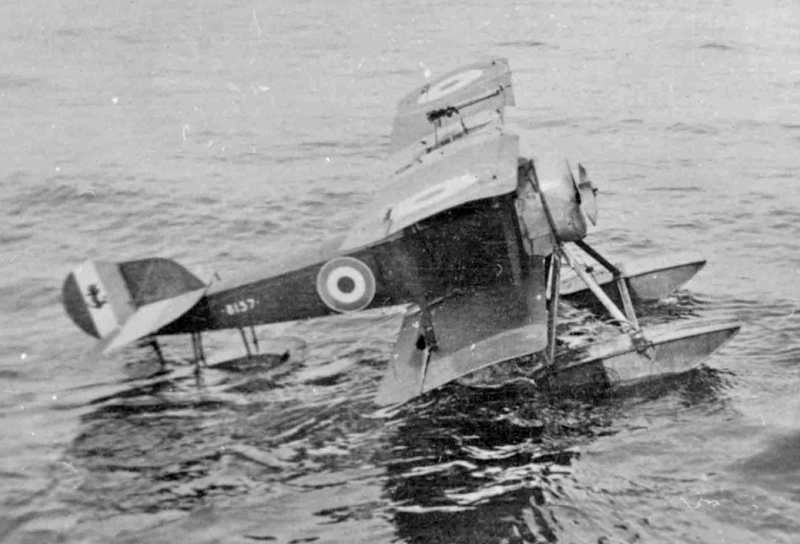
On 22nd July the first Sopwith “1½ Strutter” built against a War Office order by Ruston-Proctor goes from Farnborough not to the RFC in France but Sedgeford in Norfolk to start forming a new RFC Squadron, No.45.
On 23rd July having now seen the flight reports the Admiralty immediately orders 40 Sopwith “Triplanes” from Clayton & Shuttleworth, another of Lincoln’s established agricultural machinery and steam engine companies.
On 24th July with failing deliveries of the latest French Morane scouts and a growing threat from new German fighting scouts, Trenchard’s team in France urgently request a date from the Director of Aeronautical Equipment for a flight of eight Sopwith Pups, even if all but the first two are without engines. Standard Motors, who only had the order 8 weeks ago, promise two in August and twelve per month.
Prototype Sopwith “1½ Strutter” 3686 has now moved from Eastchurch to Grain. Already over 100 “Strutters” have been delivered, they are involved in all sorts of action and quite a few have been damaged or lost.

“Strutter” 9378 (above) is one of two which were crashed by 5 Wing at Coudekerque in May. It has been repaired, possibly locally, and is now with RNAS 1 Wing at Petite Synthe. The other, 9397 (below) appears to have plunged steeply to earth and has unsurprisingly been written off as “wrecked”.
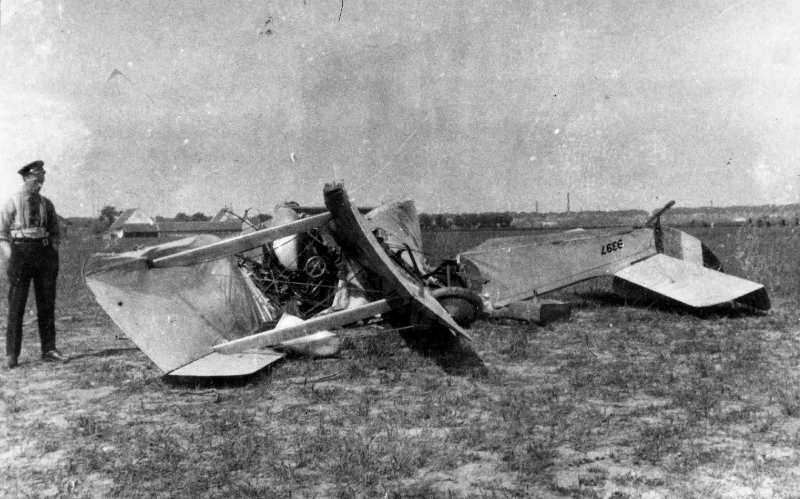
On 24th July RFC 70 Squadron “Strutter” A891 is crashed at Farnborough before ever getting to France.
On 26th July RNAS 3 Wing “Strutter” 9670 is damaged at Manston in Kent and goes immediately for repair to Oakey Ltd’s Ilford Aeroplane Works where they are installing American Curtiss engines in BE2Cs.
On 27th July RFC 70 Squadron “Strutter” 5719 crash lands returning from a reconnaissance flight in France.
Like 5 Wing at Coudekerque, RNAS 1 Wing at St Pol and Furnes have continued their fighting patrols along the Belgian coast when weather permits chasing off enemy aircraft but attracting significant anti-aircraft fire.
The 28th July is a particularly eventful day for these RNAS Wings based around Dunkirk. The prototype Sopwith Triplane N500 with 1 Wing has a close shave when it is so badly damaged by anti-aircraft flak that the wings will have to be returned to Sopwith for rebuilding. Fl Lt Gerrard dives to chase an enemy aircraft over Nieuport when a terrific anti-aircraft blast sends his “Strutter” spinning out of control. Despite the fabric being stripped from a wing he gets it down in one piece, a testament to the strength of the aircraft structure against such a blast. In 5 Wing “Strutter” 9405 over Dunkirk Fl S Lt Hervey’s RNVR observer Lt St John fires a red Very’s light (sic) to stop allied anti-aircraft guns firing at an enemy machine so they can get close. After a 10 minute chase firing his Vickers gun, Hervey dips his aircraft under the enemy and St John fires over the wing with his Lewis gun possibly hitting the observer as return fire ceases but they run out of ammunition and the enemy escapes.
On 29th July C Flight of RFC 70 Sqdn set out for France after long delays getting six “Strutters” equipped with engines, synchronising gear and rear gun rings and after a frustrating 5 day wait for the weather. They are then delayed overnight at Dover due to heavy sea mist where they lose A885 which crash lands in an uneven field. Five arrive at St Omer on 30th July and go on to Fienvillers to join A & B Flights who over the last two days have been escorting 27 Sqdn Martinsydes dropping 112lb bombs on airfields and railways behind the German lines.
On 30th July the Admiralty Director of Air Services makes an inspection of 5 Wing in France. The Sopwith “Triplane” N500 with its flak damaged wings is grounded but they are test flying prototype “Pup” 9496.
RNAS 3 Wing’s “Strutters” way down south at Luxeuil continue to suffer from the rough running engines first experienced on their delivery flights and found to be caused by worn piston rings in their British made Clergets. On 30th July when asked for the first time to assist French Groupe de Bombardement 4 with a strategic bombing raid on Mulheim only three “Strutters” are serviceable. In the one “Strutter bomber” the observer aiming four 65lb live bombs for the first time decides sighting the target through a hole in the floor and using a reversed stop watch to time the drop is a joke. He simply watches for the French machine in front to release its load and does the same a few seconds later. He reports seeing bombs explode in the barracks and fuel stores.
As well as their fighting patrols RNAS 1 Wing now take aerial photographs and report by wireless telegraph not least to RN Monitors shelling the harbours at Zeebrugge and Ostend and its “Tirpitz battery” of 280mm guns.
On 31st July 1 Wing “Strutter” 9419 is able to report enemy shipping movements off the Belgian coast and photograph ports and coastal batteries from 12,000ft despite heavy anti-aircraft fire, clouds and haze. One of five enemy aircraft in the area attacks them but is driven down by the two accompanying Nieuport Scouts.
Sopwith works’ records show 29 “1½ Strutters” sent from Kingston to Brooklands for testing in July to bring the total to 102. The 31st July Admiralty report shows 32 accepted in July bringing the total delivered to 92.
Sopwith’s July total ex-works aircraft output is 32: 29 “1½ Strutters”, the two “Pups” and the last of their 100 “Baby” floatplanes. The RNAS orders for 236 military “Schneider” and “Baby” floatplanes have been the mainstay of Sopwith’s wartime success until the last few months and it is no surprise that the testing of the last one on the Thames outside the Turk’s Albany Boathouse in Kingston is recorded with photographs. (below)
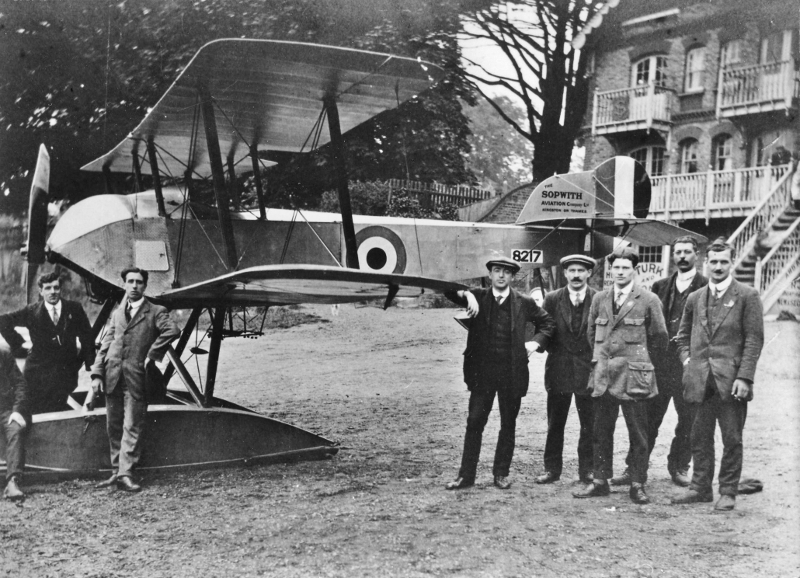
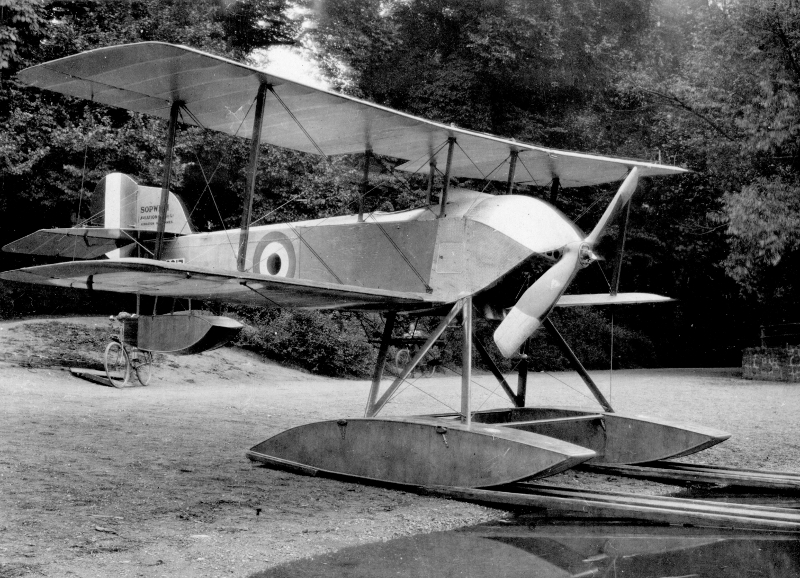
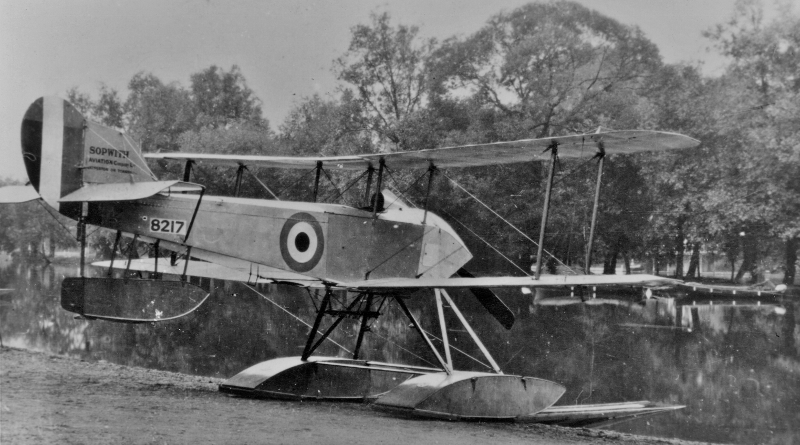
The photographs of 8217 show the “Schneider” style cowl over the 100hp Gnome engine installed in the last 31 machines to release their 110hp Clerget engines for “1½ Strutters”. Noticeable are the ailerons and enlarged fin, the pronounced hump in front of the cockpit and the tube linking the water rudder with the flying rudder
During July Sopwith floatplanes have been very active in the Egypt & East Indies Squadron flying from HMS Ben-my-Chree & HMS Raven. Cmdr Samson is delighted to be receiving his first Sopwiths with 110hp engines.
Late evening on 30th July “Baby” floatplanes 8167 & 8206 are sent out after reported Zeppelins and the next night 8148 and 8161 are amongst 12 aircraft deployed against an ineffectual raid by eight airships.
On 1st August Scapa based “Baby” 8172 damages a wing colliding with a seagull and 8164 from paddle steamer HMS Brocklesby collapses its undercarriage during a crash landing and is completely wrecked.
On 2nd August five airships are back over East Anglia apparently lost. Only one finds a specific target, Harwich injuring one person. Early warnings allow the Navy to send out HMS Vindex for the first example of an aircraft, a Bristol Scout, being launched from a ship’s deck to attack an airship. He drops Ranken darts hitting it apparently without effect. “Schneider” 3736 and “Baby” 8149 launched from HMS Brocklesby both make brief attacks before losing the rising airship in cloud as does “Schneider” 3776 from Yarmouth which lands in the dark by a Belgian steamer, is swept away by strong tides but eventually picked up and returned to Killingholme
Meanwhile in France on 1st August 5 Wing “1½ Strutter” 9388 is completely wrecked after an engine failure. On 2nd August other 5 Wing “Strutters” are involved in a raid on a Belgian coastal airfield and ammunition dump. For the first time their mixed group of bombers are flying in a protective Vee formation with a lone “Strutter” signalling when to break into line astern for bombing and then reassemble in a Vee to return to base.
In 70 Squadron RFC that day “Strutter” A879 suffers a collapsed undercarriage whilst taxying. On the 3rd August 6 of their “Strutters” accompany 8 Martindsydes raiding railways and an airship shed. On 4th August their A382 is damaged during an engine test when the cowl comes loose in flight. Over the next two days four of their “Strutters” A385, A886, A878 and A888 suffer wrecked undercarriages returning from reconnaissance.
In addition to those transferred from the Admiralty, the RFC are now getting more of their own “1½ Strutters”. Only 6 weeks from their War Office order for 100, Vickers have delivered their first two, A1054 and A1055. A1055 joins the first Ruston-Proctor built machine at 45 Squadron RFC who are forming at Sedgeford, Norfolk.
On 5th August Lt H H Griffith with Fl Cmdr Eric Fox Pitt Lubbock of 45 Squadron collect one of three more Ruston-Proctor built “Strutters” from Lincoln. 7764’s tests show 107mph, 1,000ft in 45secs and 6,000ft in 7 minutes. On the journey to Sedgeford they climb to 14,500 ft in 33 minutes. Lubbock has never been so high, his Henry Farman takes 61 minutes to reach its maximum 11,300 ft. 7763 & 7766 follow that same day.
On 6th August two “Strutters” on a 70 Squadron patrol meet ten German bombers flying towards the lines and fight them until they are forced back to their aerodrome where they land still loaded with all their bombs.
On 7th August after reconnoitring Maubeuge Zeppelin Sheds in 70 Sqdn Sopwith “1½ Strutter” A380 2nd Lt C W Blain is forced down behind enemy lines by engine failure. Colleagues watched him deliberately veer into trees and then set it on fire to avoid it getting into enemy hands. Both he and 2nd Lt C D Griffiths are taken prisoner.
70 Sqdn “Strutters” continue to risk locating targets deep behind the lines. On offensive patrol on 9th August 2nd Lts R M S Shepard & J W Gunton are killed when “Strutter” A881 is hit by AA fire and an enemy aircraft.
So far less than twenty Strutters have been single-seat “Type 9700 Strutter bombers”. One, 9733, is now at Chingford for ‘Type Trials’ all the others have gone to the RNAS in France. On 9th August two “Strutter Bombers” attack the airship sheds at Evere and Bercham St Agathe in Belgium.
On 8th August “Baby” 8200 is wrecked by Fl Lt J E Scott after five months at Felixstowe, 8133 suffers a damaged float after two weeks at Yarmouth whilst “Schneider” 3759 is deleted after nine months’ service at Westgate.
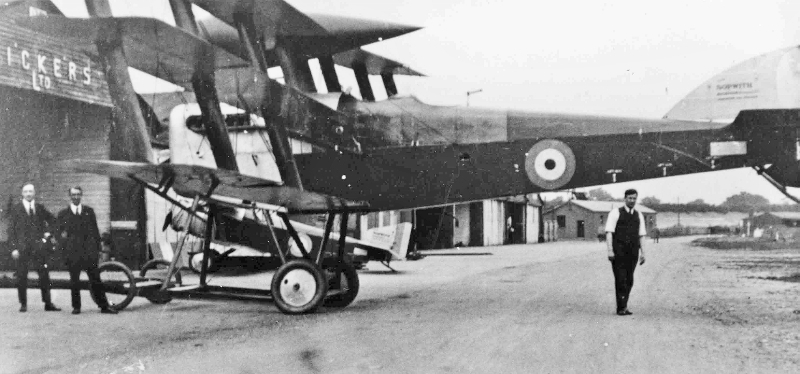
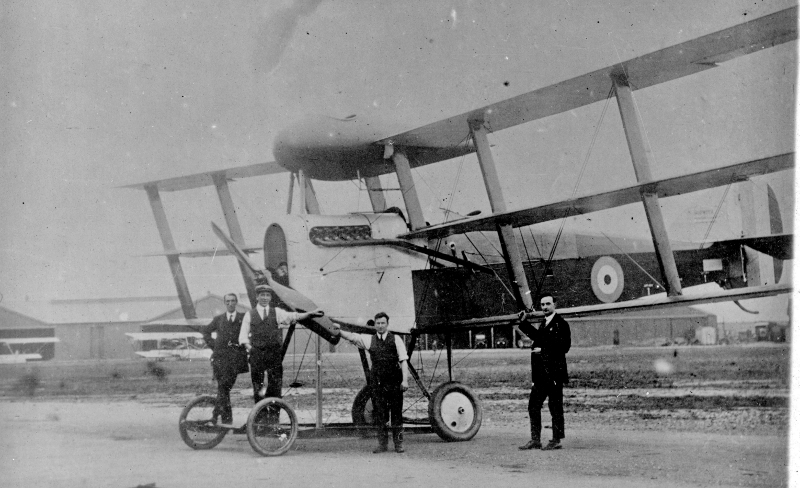
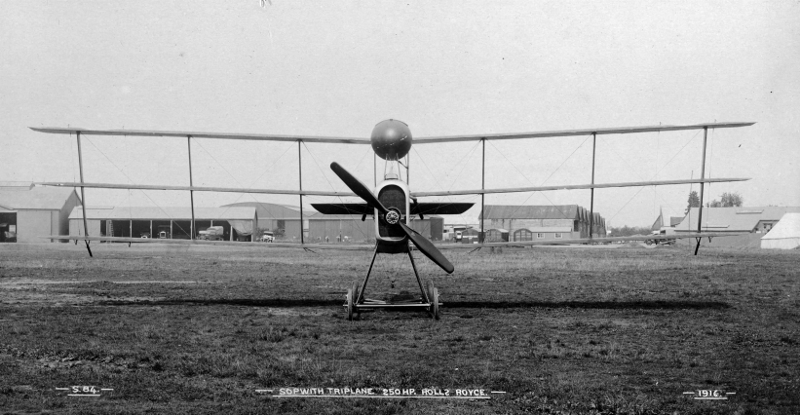
Sopwith’s Long Range Tractor Triplane (LRTTr) is finally assembled and gets photographed with some key members of the Sopwith team. The photographs above reveal its huge bulk but remarkably small frontal area. They also provide a panorama of the south west corner of the Brooklands airfield: looking along the front of the original Vickers and Sopwith sheds to the race track, the 1915 style RFC gabled hangar, the transport shed and the rows of larger early hangars further out on the airfield. Taken for a test flight by Harry Hawker, Ernest Newman in the top gunners pod is not at all impressed when it moves out of true on landing. Despite the 250hp Rolls-Royce engine, its performance does not match their 110hp “1½ Strutter” which by the magic of firing through the propeller and its ring mounted rear gun has almost as much firing freedom. It will still go back to Kingston to be modified. Sopwith are not the only ones who have been developing a 3-seat gun-pod ‘Zeppelin Destroyer’ and long-range bomber escort. Armstrong Whitworth’s prototype FK12 triplane and Vickers’ prototype FB11 biplane both use the 250hp Rolls-Royce engine. Earlier this year Pemberton-Billing produced the unsuccessful PB29 twin 90hp Austro-Daimler engined quadraplane.
On 12th August Westgate “Schneider” 3766 is one of ten machines sent up to catch a lone German aircraft which drops four bombs from high altitude over Dover, one lands on the RNAS Guston Road aerodrome.
On 12th August over 1,000 wounded soldiers are the guests of Sir Charles Wakefield, Lord Mayor of London, in the “magnificent grounds” of Fred Carno’s Karsino Hotel on Tagg’s Island, near Hampton Court. Transported from local hospitals to the river bank by volunteer organisations and ferried across to the island, each is given a packet of cigarettes, a box of matches and a souvenir enamelled badge. The ladies of Wimbledon Swimming Club give a diving exhibition, there is ‘all the fun of an old village fair’ plus a flying exhibition by Harry Hawker. “Planning down from high altitude to 200ft he climbs again to give a great display of vertical banking, looping the loop before returning towards Brooklands to cheers such as only ‘Tommy’ can give.”
The Admiralty report 10 more “1½ Strutters” delivered from Sopwith in the last two weeks with 7 promised 19th August. Two more 80hp Le Rhône “Pups” are promised from Sopwith on 19th August. Beardmore’s first 80hp Clerget “Pups” are promised on 26th August and three more have been ordered from them making 53.
On 14th August Sopwith receive an order to develop a prototype more powerful 110hp Clerget engined “Pup”.
Flight magazine reports that Mr J A Whitehead of Richmond’s Whitehead Aircraft Company recently hosted a very successful Mother’s Day at Hanworth Park for 400 mothers of soldiers and sailors from all parts of London.
On 17th August Sopwith “Schneider” 3715 is deleted after thirteen months’ service on Yarmouth’s anti-Zeppelin trawlers.
More “Schneider” floatplanes originally delivered straight to the Naval Central Stores Depot at White City often without engines are emerging to re-place those lost or deleted. 3737 & 3738 are now at Yarmouth, 3746, 3794 & 3803 are at Felixstowe and 3804 is at Grain fitted with an over-wing Lewis gun. (below)
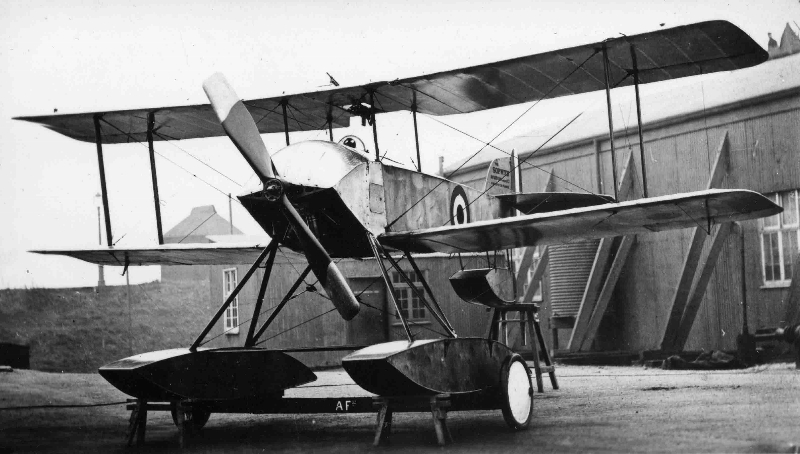
“Baby” floatplanes emerging from White City include 8137 which went to Blackburn Aircraft at the end of June. The Admiralty were expecting their first Blackburn built “Baby” on 5th August. That did not happen but it seems likely that N1010 has now been taken from their Leeds Skating Rink factory and assembled at their Humberside airfield at Brough. These photographs (below), possibly a record of that event, reveal the typical Sopwith construction. The wooden box girder fuselage is formed by four ash longerons with spruce vertical and horizontal spacers positioned in light folded steel brackets and all pulled together by crossed bracing wires tensioned with turnbuckles. The wings’ two spruce spars carry lightweight spruce ribs with fine steel tube leading and trailing edges and tip shapes. Brazed fine steel tube is also used extensively in all elements of the tail unit.
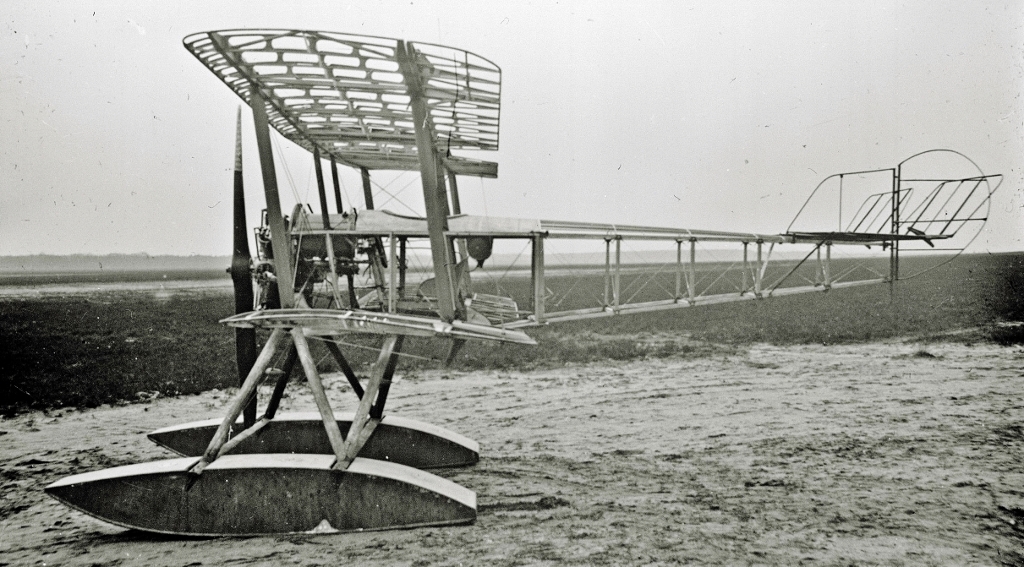

In Kingston Sopwith are establishing “Pup” production alongside the “Strutters” and are on plan to complete the first three production machines in August. Of the three prototypes, 9496 arrives at Villacoublay on 17th August on its way to RNAS 3 Wing at Luxeuil whilst 3691 is still with RNAS 1 Wing at Dunkirk. However it seems that 9497 may have gone to Beardmore in Scotland as a sample to help speed them into production.
On 19th August Sopwith Board confirm and seal the assignment of the leasehold of 2 to 8 Elm Crescent to the company completing their control over the eight homes on the east side of that road and the adjoining four in Canbury Park Road all of which are to be demolished to make way for a fourth large extension to the factory.
On 19th August German Admiral Scheer’s fleet is sweeping across the North Sea to bombard Sunderland protected by four lines of submarines and eight airships. The British Grand Fleet have forestalled him and get through the first line of Zeppelins in the dark but once again without fore-deck aircraft carrier Campania which has mechanical trouble. Misleading Zeppelin and submarine reports about Harwich’s cruisers and destroyers further south lead Scheer to believe they include battleships. He abandons the Sunderland plan to engage his superior force in a decisive sea battle but fails to make contact and returns to base. Killingholme based “Baby” floatplane 8131 intercepts an airship 35 miles east of the mouth of the Humber and attacks it from 11,000ft dropping four 16lb bombs and a box of Ranken darts. The Zeppelin turns a complete circle and its nose drops before Fl Sub Lt Fox’s engine sheds a valve rocker arm which punctures a float. He is forced to land out at sea and sit on the end of the starboard wing to counterbalance the sunken port float until help arrives.
With the airships temptingly visible from the Grand Fleet there is one bold attempt to launch a “Baby” floatplane from HMS Engardine despite the state of the sea but the propeller is smashed in the crest of a wave.
On 21st August 70 Sqdn “Strutter” A2988 suffers engine trouble on patrol and is wrecked by landing in a shell hole. A894 out practising with a camera gun is damaged when its engine also fails. Both crews are uninjured.
On 23rd August Robey-built Sopwith “Type 806” pusher gunbus 3837 is deleted after mysteriously appearing on 13th July with no previous recorded history. This leaves only 3847 at Eastchurch Gunnery School
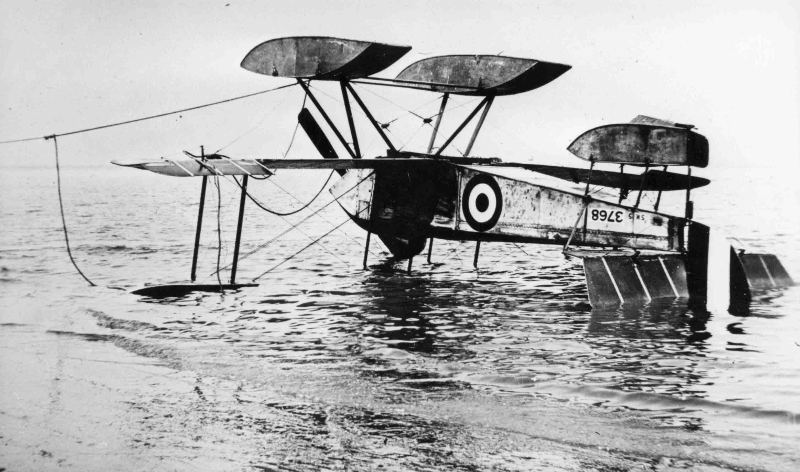
The photograph shows overturned “Schneider” 3768 dragged ashore at Killingholme this week. The only obvious damage is the torn tail float but it has probably been underwater as it is to be deleted from service.
On 24th August RFC 70 Squadron “Strutter” A879 falls behind the group and suffers a direct hit by AA fire. It goes down in a spin from 8,00ft. Capt Hopwood and Gunner Pearce are killed. That day 2nd Lt Vaucour and Lt Bott in A890 are hit by a burning wad from an AA shell which sets fire to fabric on the rear fuselage. Bott squeezes inside and beats out the flames with his gloved hand and then by swinging his gauntlet furiously. Next a fuel pressure pipe is hit by bullets from two attacking aircraft, the engine stops but they just manage to glide back over the trenches. The following day Air Mechanic H Warminger sent out to repair the aircraft gets a lift back to the airfield but is fatally wounded by an AA shell fragment after surviving an attack by three aircraft.
Also on 25th August 70 Sqdn “Strutter” A2987 with 5 days in service is crashed and wrecked at Fienvillers by a new pilot whilst three Dunkirk 5 Wing “Strutter Bombers” attack an airship shed near Namur 100 miles away but Fl Sub Lt Jamieson in 9396 runs out of fuel, lands in Holland and is interned as is his aircraft.
Overnight on 24th/25th August eight of the twelve Zeppelins raiding Britain abandon their mission for various reasons. Just one of the remaining four causes serious damage, killing nine and injuring 40 in the first Zeppelin to reach London since October last year. Two of the twelve RNAS and RFC aircraft sent up to intercept are “1½ Strutters” 9400 & 9414 from Marston. Zeppelins are spotted and chased but escape in the clouds.
Four replacement “Schneider” floatplanes 3721, 3726, 3770 & 3771 have arrived at EI&ESS Port Said since July. On 25th August Samson launches a large scale attack on El Afuleh with the six Shorts and five Sopwiths from his “little armada” of three seaplane carriers. In three waves they effectively plaster the important railway junction further hampering Turkish-German communications. Most are hit by ground fire but all get back.
On 26th August the second Sopwith “Triplane” N504 is flown from Brooklands to RNAS Hendon and the next day visits the RFC at Farnborough.
It has taken a year for French manufacturers to start deliveries of the 50 Spanish designed V-8 Hispano-Suiza engines ordered by the War Office. British licence manufacture by Wolseley Motors is also now underway.
Somehow Sopwith have obtained a 150hp Hispano-Suiza engine for a much enlarged version of their Clerget Triplane, the fast long-range “Hispano Triplane” fighter prototype (below left) which is ready to go to Brooklands. Below right is a head on view of the even larger LRTTr long-range triplane also in the Canbury Park Road factory with a mock-up gun-ring atop the streamlined nascelle.
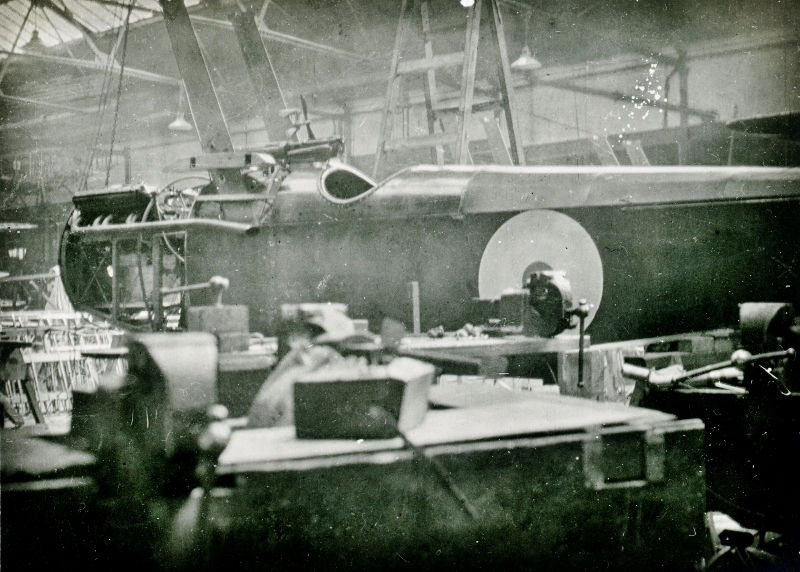
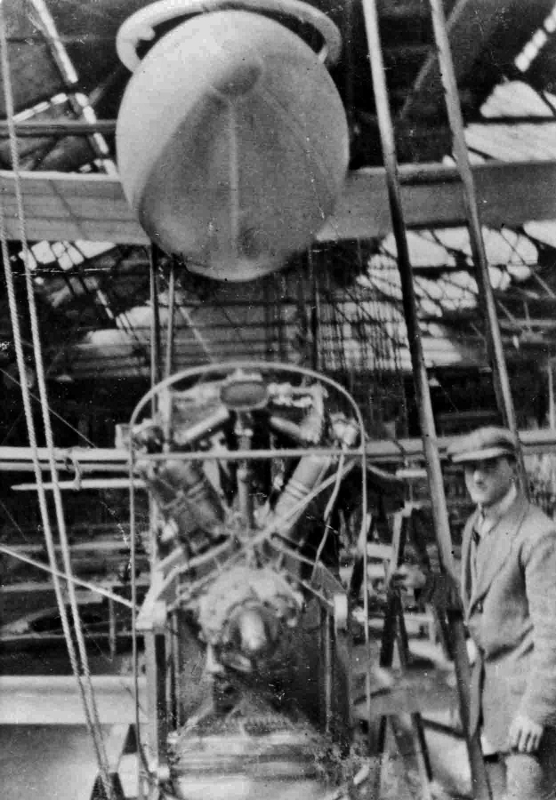
The pair of photographs (below) record the extraordinary journey to Brooklands of the 150 hp Hispano-Suiza Triplane and, on its second visit, the 250hp LRTTr Triplane aboard Sopwith’s Daimler lorry and trailer with the large crate of flying surfaces overhanging at the rear.
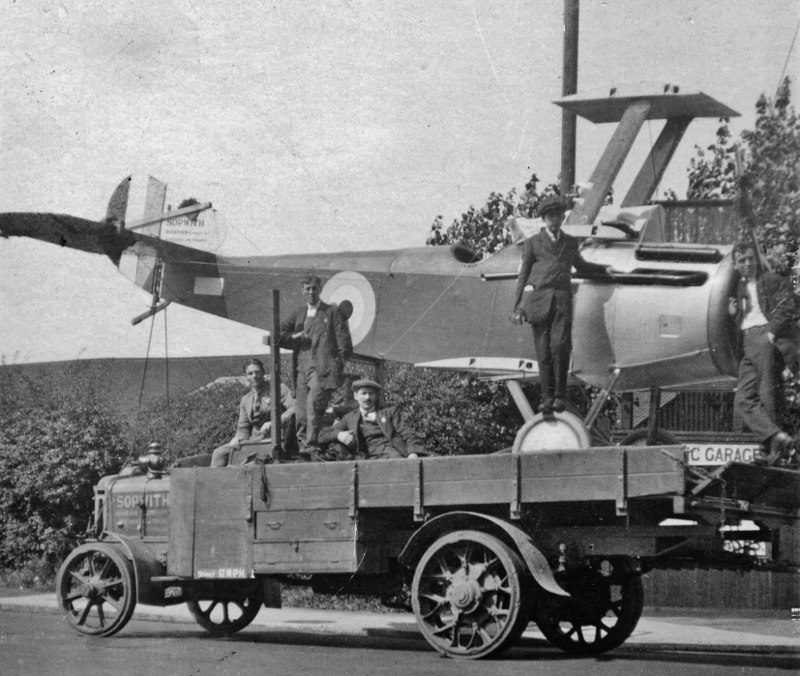
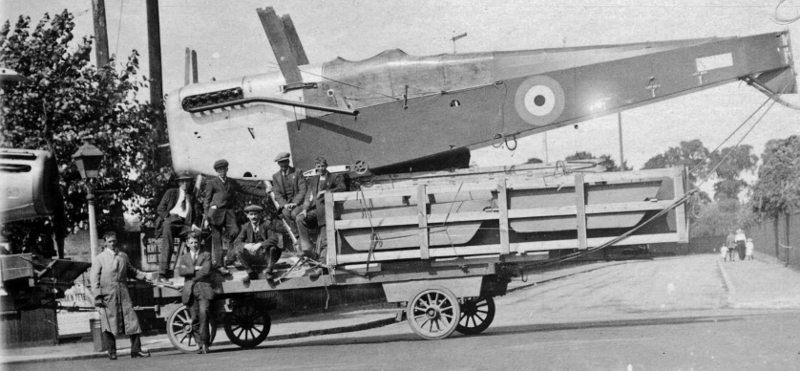
This third image (below) records the arrival of the two machines at Brooklands.
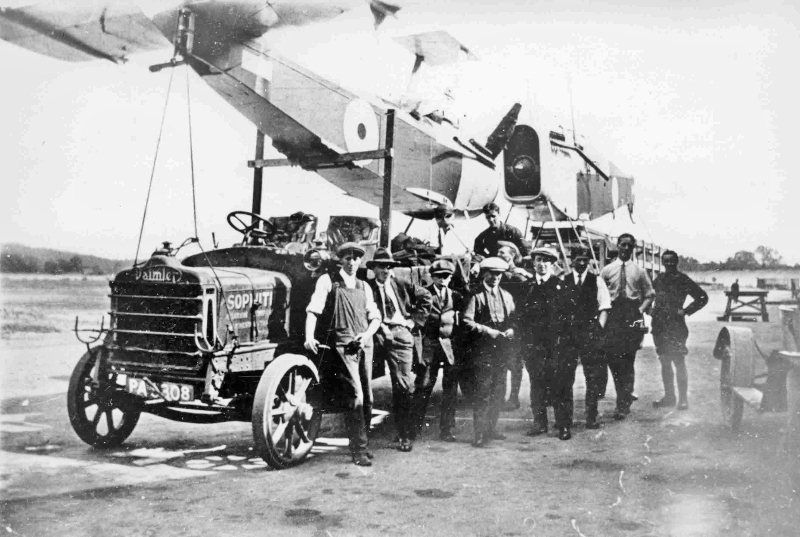
On 28th August 80hp Clerget engined Pup 9496 joins the “Strutters” and other types with RNAS 3 Wing down at Luxeuil after 11 days at Villacoublay. 3 Wing have now loaned “Strutter” 9652 to a French Escadrille at Luxeuil.
At home eponymous Sopwith “Type 9700” Strutter bomber 9700 joins the RNAS Design Flight at Eastchurch.
Two days after it left Farnborough for France, “Strutter” A2989 is mysteriously deleted on 28th August whilst 70 Squadron are in the thick of the action over Bapaume. 9892 is seen to dive on four enemy aircraft before being attacked by six. Out of ammunition and then hit in the fuel tank, Lts Mase & Odling make a forced landing and burn their machine before being taken prisoner. In A888 Capt Salmond & Lt Stewart spot one of the enemy aircraft coming out of the sun and shoot it down at point blank range whilst Lt Keen & Capt Glenday in A2432 send an Albatross DII down in a spinning nose dive. These are the first combat victories for RFC “Strutters”.
On 29th August a letter from Sopwith’s Paris office is passed to the ‘RFC in the field’ from the British Military Commission in Paris. Primarily in France to support French manufacture of “Strutters”, Alan Fenn offers the RFC the services of his ‘staff of Sopwith men’ also noting that he visits London (Kingston) every 3 or 4 weeks.
On 30th August “Schneider” 3806 is taxied into a boat at Scapa by Fl Sub Lt A Gammon.
By the end of the month Sopwith’s first three production Admiralty Type 9900 “Pup” single-seat fighters are at Brooklands being test flown. N5180 with the specified 80hp Le Rhône engine is photographed for the record. (below)
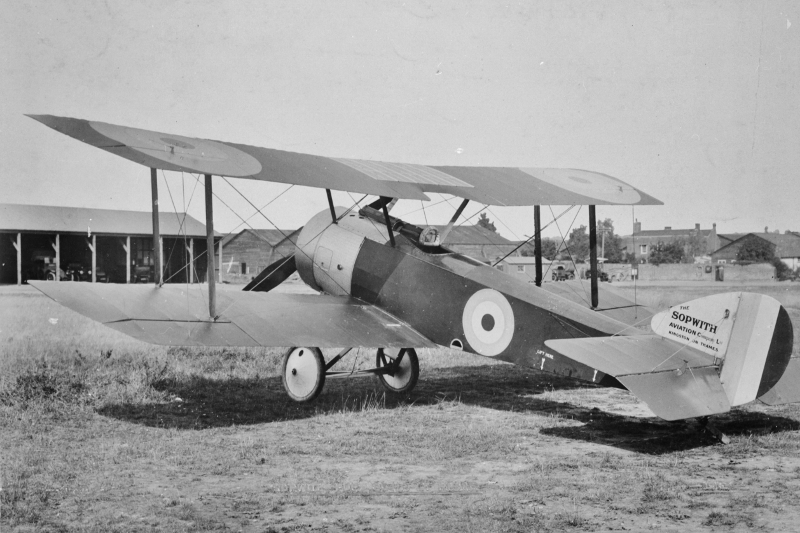
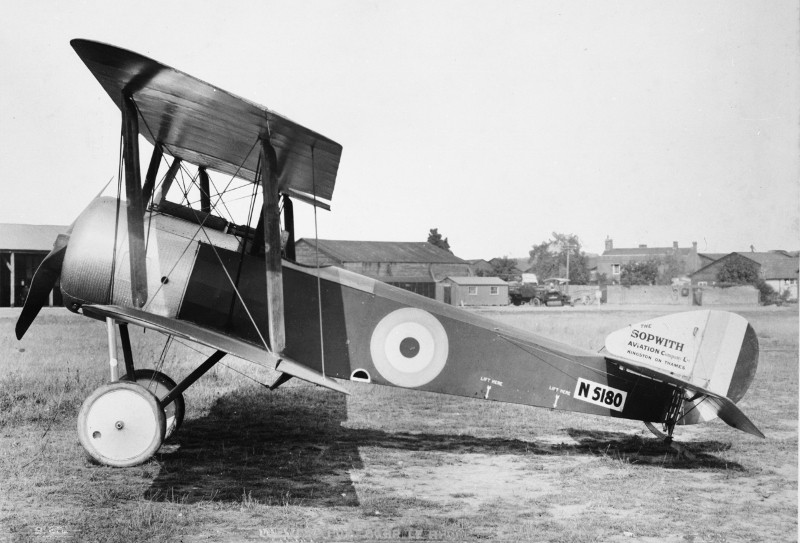
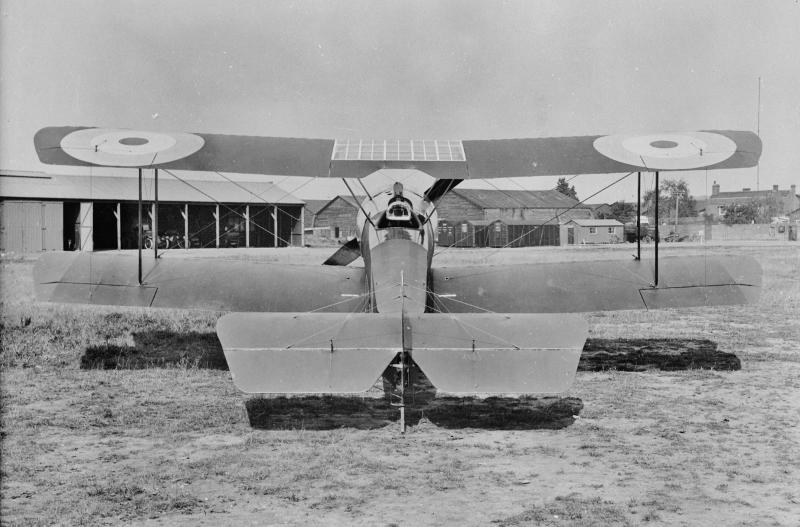
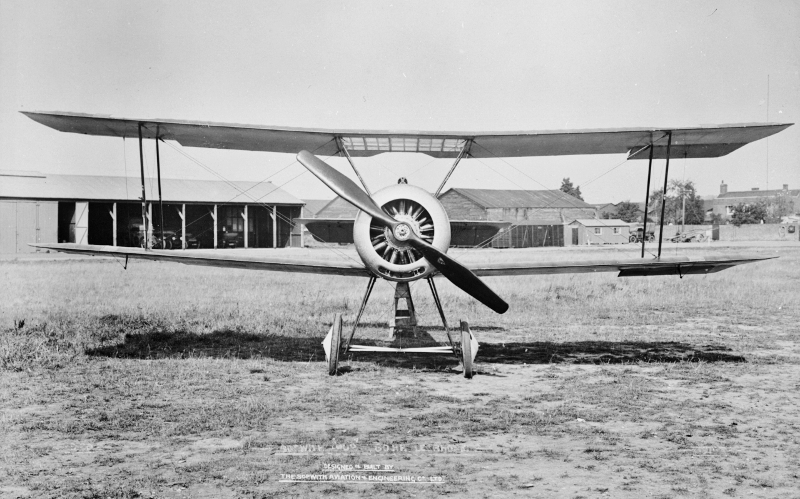
The main differences from the first prototype “Pup” are the taller undercarriage, slightly revised fin and rudder shape and streamlined bracing wires in place of cables between the wings. Both have the variable incidence tailplane like the “Strutter” but lever actuated. Note the transparent panel in the top wing for better visibility, Sopwith’s patent padded windshield/head protector on the rear of the Vickers gun and the tips of the wings and tailplane tapered backwards as on Harry Hawkers 50 hp SLTBP runabout from which the “Pup” evolved.
N5180 and N5181 are delivered to RNAS Chingford on 31st August but N5181 is exceptionally fitted with an 80hp Gnome engine another indication of the limited supply of the most popular engines.
The Sopwith works have had a busy August completing 41 aircraft; three “Pups”, a second “Clerget Triplane”, the first “Hispano Triplane” and a record thirty-six “Strutters”. Ruston Proctor have delivered five more “Strutters” to the RFC in the month and Vickers one or two. Elsewhere, initial “Strutter” production at Westland Aircraft is well advanced as is initial “Pup” production at both Standard Motors and Beardmore.
On 1st September Sopwith get a production order for seventy-five 130hp Clerget “Triplanes” and an Admiralty order for three 80hp Clerget “Pups” for the French Government further swelling their order book.
The next day Clayton and Shuttleworth in Lincoln have their order for forty Clerget “Triplanes” extended by six machines, apparently to be experimental versions as they are allocated special serial numbers N533 to N538.
On 2nd September three RNAS 5 Wing “Strutters” descend through a hailstorm to bomb Hoboken shipbuilding yards near Antwerp whilst a group of four RFC 70 Sqdn “Strutters” on an offensive patrol are attacked by six enemy aircraft behind the Western Front. Cpt Salmond and Lt Stewart in A888 attack two Roland biplanes before being hit by a third, spiralling out of control and crashing on their tail. Wounded in the air and in the crash, both men are taken prisoner. 2nd Lt Drenen and Lt Lowson take on two Roland biplanes firing a Lewis drum at one which dives away. In A892 2nd Lt Vaucour’s observer Alan Bott fires 2½ drums at 50 yards range as a Fokker EIII crosses their tail and it makes a vertical dive streaming smoke. They turn onto another under their tail and firing 20 rounds from the Vickers gun send that one “diving vertically out of control turned on its back”.
Overnight on 2nd & 3rd September the largest combined German Navy and Army raid sees 15 airships set out. They are scattered in adverse winds, heavy rain and icing, only one reaches London. On one of 16 defensive sorties, none of them Sopwith machines, Lt Leefe Robinson in a BE2c uses the new incendiary ammunition to become the first to shoot down an enemy airship over Britain, setting it ablaze over Cuffley in Hertfordshire.
On 3rd September Ruston Proctor built “Strutters” 7768 (fitted with Vickers gun and Scarff timing gear) & 7769 are the first to go to another new “Strutter” squadron, RFC 54 Sqdn at Castle Bromwich. The same day 7771 goes to Farnborough to establish its ultimate strength by suffering their destructive structural test process.
On 3rd September RNAS 5 Wing are out again this time bombing the airfield at Gistelles. RFC 70 Sqdn “Strutter” A377 is wrecked when the engine fails taking-off on a practice flight whilst in A894 Beanlands and Goode are able to fire about 1½ Lewis drums at an Albatross biplane and then a few rounds with the Vickers gun before it jams. The German with an injured observer still tries to tempt them into a trap. Two of Beanland’s Vickers’ gun jams were “of the usual type due to the cold” but the third was due to a cartridge with a thick rim.
On 6th September at 1.45pm 70 Squadron “Strutters” near Bapaume engage four Roland biplanes. One lands and “runs onto the parapet about Flers.” Capt Cruikshank in A895 and Lt Mansell in A2986 both report attacks on other Rolands with one going down into the clouds out of control and one “turning off suddenly, side slipping and spinning” into the clouds. These may be the same machine. At 3.15pm A3432 has another fight. At 6.45pm three RFC 70 Squadron “Strutters” A3431, A894 & A1902 are persistently attacked by a Roland CII over Elincourt. It is hit by all three and eventually at close range by Cpt Sanday and sent down in flames.
After being shot at and the observer hit in the cheek, 70 Squadron “Strutter” A886 crash lands behind the lines due to an engine failure. The aircraft is partly burnt before 2nd Lts Tullis and Taylor are taken prisoner.
On 6th September HMS Campania “Baby” floatplane 8127 at Scapa suffers a burst tail float which damages the chassis whilst “Baby” 8166 is wrecked crashing on arrival at Killingholme from Felixstowe.
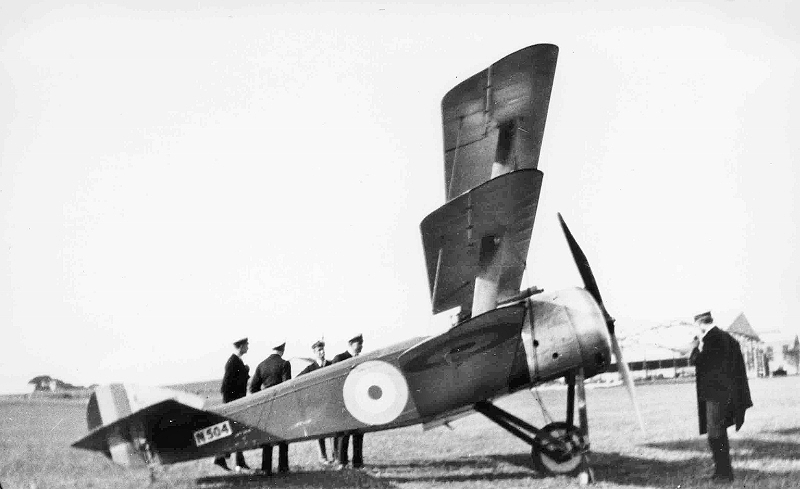
On 6th September after a few days on repair by Sopwith, “Triplane” N504 is at Eastchurch for a speed test. (above) Despite recent reports of a 130hp engine, it most probably still has a Gwynne-built 110hp Clerget.
On 6th September, a day after delivery to RNAS Chingford, the third production “Pup” N5182 travels with N5180 via Dover to the Aircraft Depot Dunkirk (ADD). On 7th September both are in service locally with C Sqdn RNAS 1 Wing and the Gnome powered “Pup” N5181 reaches Dover but stays there.
Sopwith built RFC “Strutter” 7999, originally RNAS 9393, started life at Farnborough for 70 Squadron, passed to 52 Sqdn at Hounslow late July, to 54 Sqdn at Castle Bromwich early August and is now with 28 Training Squadron there. On 7th September it is crashed banking too low on take-off injuring both crew.
On 7th September Flight magazine notes that recent contributions received by the Lord Mayor for the Lord Kitchener Memorial Fund include 100 guineas from the Sopwith Aviation Co., Ltd.
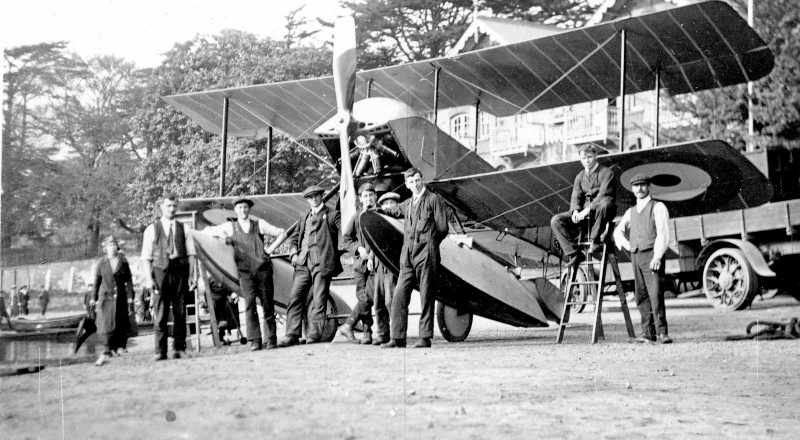
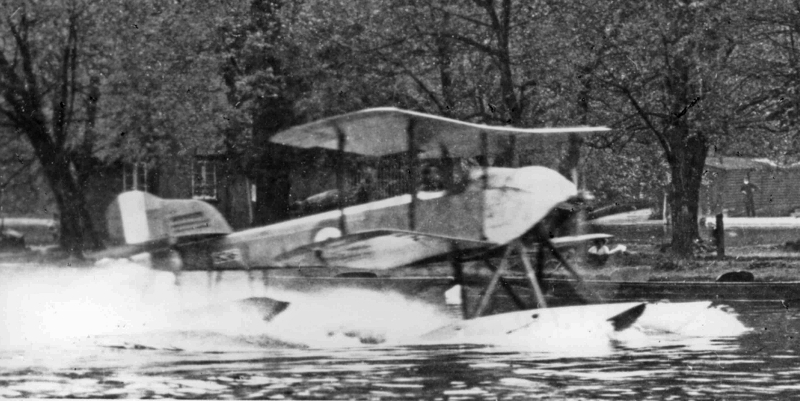
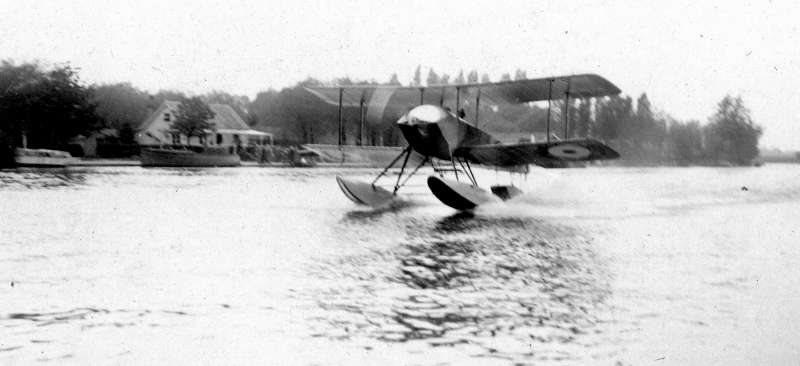
Sopwith have fitted a 100hp “Baby”, possibly 8216, with experimental floats designed by 1900 Olympic double gold medal sailor and famous yacht designer Linton Chorley Hope who has been working for the Admiralty on aircraft floats and hulls since 1915. Testing of this unique machine on the Thames in Kingston is photographed at the Albany Boat House.(right) The floats have very probably been built by established boatbuilders May, Harden & May in their Hampton Wick boatyard right alongside Kingston’s Thames road bridge. The lightweight wood-planked stressed-skin construction is subtly curved compared to the usual square section ‘pontoon’ floats. Aimed at shorter take-offs, they are reported to increase top speed by 8 mph.
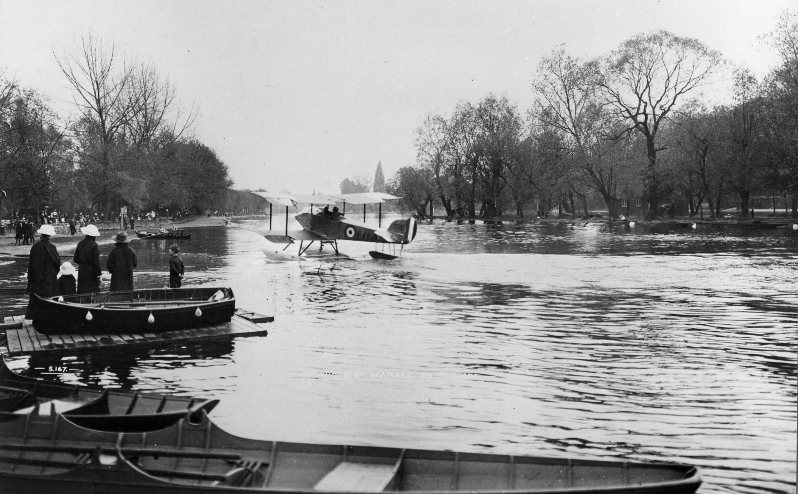
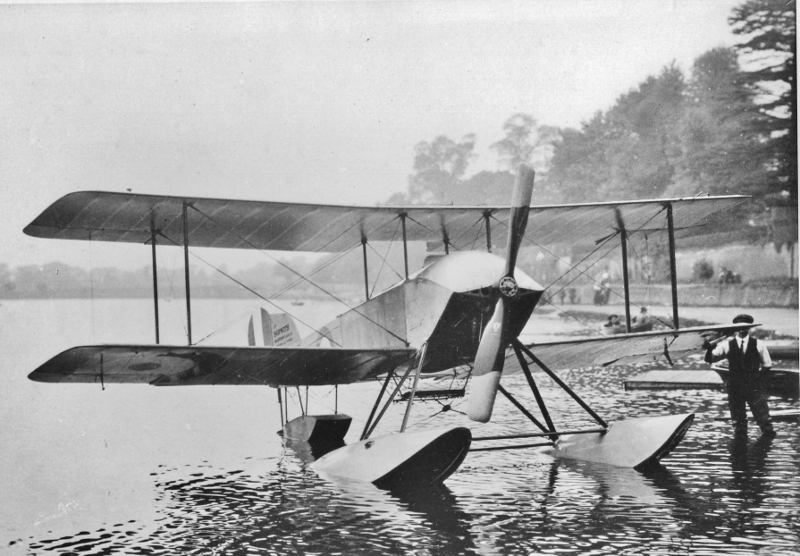
This is Sopwith’s final work with their floatplanes but development continues. On 7th September “Baby” 8123 joins the experimental section at the Port Victoria Aircraft Repair Depot at RNAS Grain where they are building a set of high-lift wings for “Schneider” 3742. Fairey Aviation is working on camber-changing “Baby” wings.
On 8th September “Type 9700 Strutter Bomber” 9733 goes to Sopwith at Brooklands to have its standard 110hp Clerget replaced with a 130hp unit whilst new 9744 arrives at Manston with a defective 130hp Clerget engine. That day “Schneider” floatplane 3796 mounted on a trolley flies off the foredeck of HMS Campania. The next day 3797 suffers a forced landing and is wrecked by the heavy sea before being towed back to Campania who’s 16 month old “Schneiders” 3707 & 3709 have recently gone to Blackburn Aircraft at Leeds for rebuilding.
The 9th September sees the end of the second phase of the Battle of the Somme with the capture of Ginchy, part of High Wood and the last main obstacle on the upper part of the ridge. Air fighting is particularly heavy. 70 Squadron “Strutter” A1911 on offensive patrol between Bapaume and Fins is shot up and forced to land in the French Lines. Observer 2nd Lt Cousans is killed in the action. That same day 2nd Lt Howell in another 70 Sqdn “Strutter” is wounded in action by machine gun fire. On 10th September despite poor weather Horswell & Maclean in a 70 Squadron “Strutter” engage several enemy machines and send one out of control.
On 11th September, still short of Scarff gun rings, Farnborough send “Strutter” A1913 to 70 Squadron with a Vickers gun mount in the rear. Originally designed for the front of a Vickers Gunbus, it is immediately assessed as inferior even to their remaining Nieuport rings which they are desperate to replace with the Scarff rings. “It is heavier, difficult to manoeuvre quickly, complicated and extremely liable to get out of order”.
On 11th September “Strutter” 9407 loses its undercarriage during a forced landing by Fl Sub Lt R Collishaw at Manston whilst “Schneider” 3804 is totally destroyed by fire after just six weeks with Westgate’s Nore Flight.
Dunkirk based “Baby”” 8179 suffers an engine failure on 13th September and makes a forced landing beside HMS Riviera 16 miles north of Zeebrugge but is capsized being hoisted aboard and will be deleted from service.
On 13th September “Strutter” 9717 suffers a collision at Manston whilst 54 Squadron’s A1914 on its delivery flight from Castle Bromwich to St Omer gets lost in cloud, runs out of fuel and lands near Thielt in German territory. It is captured intact and sent to Alderschof for evaluation. 2nd Lt A F Organ is taken prisoner of war.
Having introduced a number of strengthening and practical modifications with their first machine, on 13th September the ninth Ruston Proctor built “Strutter” 7770 is delivered to 45 Squadron with “new cowl and top planes fitted celluloid window” along with 7773 which has “inspection door in planes for aileron pulley”.
Sopwith’s “Pup” production is beginning to flow. By 13th September the fourth machine N5183 is at Chingford, the fifth N5184 has already moved on to Dover and is about to be joined there by the sixth N5185.
Seven weeks from the first production order for Clerget “Triplanes” George Carter signs off the general arrangement drawing.(below) He is in charge of the Production Drawing Office under Chief Designer Herbert Smith. His job is to expand and productionise the prototype drawings done by Reg Ashworth and his team in the Project/Experimental Drawing Office so that they can be easily understood by inexperienced sub-contractors.
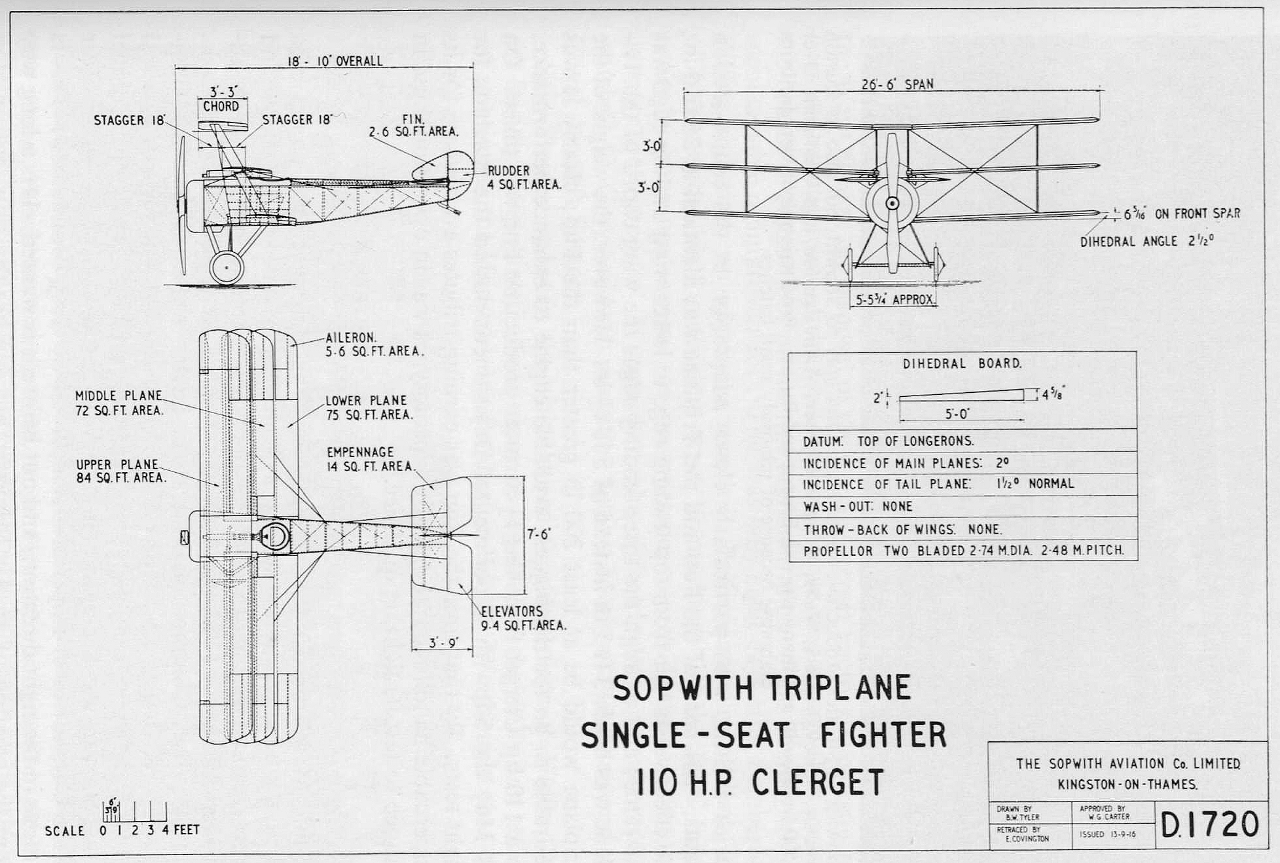
Flight reports that “ideal weather conditions prevailed at Hendon last Saturday and a fair number of visitors turned up to see the flying. During the afternoon a Sopwith Triplane came over and performed various wonderful evolutions, including some climbing loops, which bore the unmistakable trade-mark of Harry Hawker. Later on he, or perhaps another, paid a second visit, gambolling about in a One-and-a-Half Strutter”.
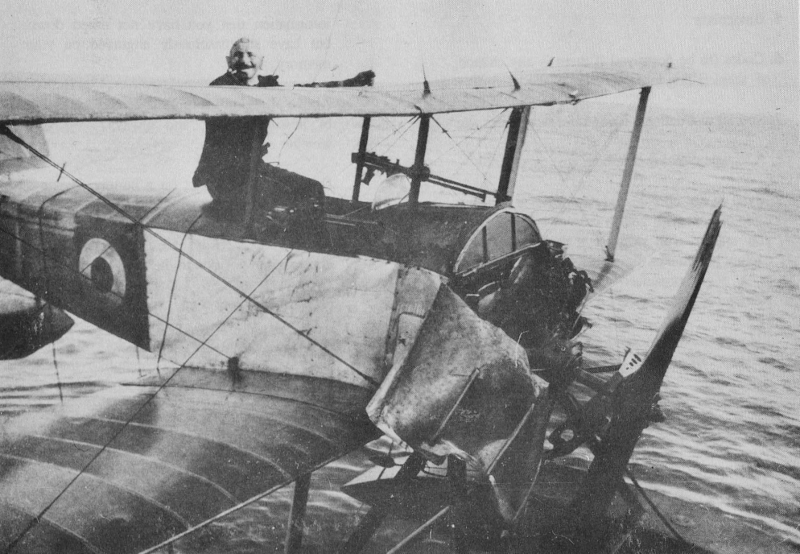
On 14th September W Cmdr Samson is flying Schneider 3789 back from escorting a raid on Beersheba when he experiences increasing serious engine vibration. Relieved to get back at all, he is even more lucky that it is just after alighting that the engine falls out of its bearers. (above) Three months in store and transit and four months constant use in the Middle East summer heat and humidity has proved too much for the forward longerons which are found to be rotten. Note the Lewis gun. With the growing threat from superior German landplanes he has started rigging his Sopwiths with one or even two Lewis guns angled outward like this to avoid the propeller. They have been practising air to air combat by firing at towed targets and now go out in pairs to protect each slower Short two-seater.
On 14th September 70 Squadron “Strutter” A897 is shot down and both 2nd Lt Gale and Sapper Strathy are killed in action whilst the observer in A1908 is “shot over the heart” and dies firing from the damaged aircraft.
The 15th September is the start of a third bold phase of the Somme Offensive and the first use of the new secret weapons: 49 battle tanks. The intensive support from the Royal Flying Corps in every role includes flying around all night to drown the roar of the tanks’ engines as they position near the front lines. Out at dawn, seven 70 Squadron “Strutters” on Observation Patrols meet up with Hauptmann Oswald Boelcke and his newly formed elite Jasta 2. Around Bapaume A1910 attacks two enemy aircraft but gets shot up by five more, with the rear gun jammed and the fuel pipe cut they are forced to land. Wounded they burn the aircraft before capture but 2nd Lt Saint dies a few hours later. Two others, A1903 and A1913 are both shot up and forced to crash land in allied territory, observers 2nd Lt Beatty and Cpt Glenday are both killed in these actions. East of Albert A895 is shot down with the loss of Cpt Cruikshank and Lt Preston whilst A1912 is damaged by enemy action. In “Strutter” A892 2nd Lt Bott is dismantling his jammed Lewis gun when 2nd Lt Vaucour cart-wheels round and races head to head at an enemy machine firing through the propeller until 50 yards apart the enemy turns and puts his nose down. They follow him down still firing until a streak of flame comes from his petrol tank and the next second he is rushing earthwards trailing two streamers of smoke. They later fight off six enemy machines before racing for the lines and safety with a broken landing wire. Three enemy machines catch up, one just high enough over the tail for Bott to fire at it, he drops down to join the others but “to my surprise and joy falls slick into one of the other two machines which breaks into two pieces that fall like stones”.
At Luxeuil on 15th September RNAS 3 Wing Fl Sub Lt Edwards taxies “Strutter Bomber” 9655 into his Flight Commander’s machine and severely damages its tail. They have been doing trials with a pair of 112lb bombs each carrying as much explosive as a 12inch shell in “Strutter” 9657 (below with its 3 Unit marking in the comparative luxury of 3 Wing’s sheds at Luxeuil). Dropped from 5,000ft they produce a neat hole 10ft deep and 24ft wide. Other preparations include the trial installation of a bomb aiming periscope pushed far enough through the side of the Strutter’s fuselage to see past the engine cowling and able to be revolved vertically to keep the target in view at all times until it appears in the sighting orifice in the floor. It is judged too complicated to use. 3 Wing have recently loaned “Strutter” 9413 to the French AMF at Luxeuil.
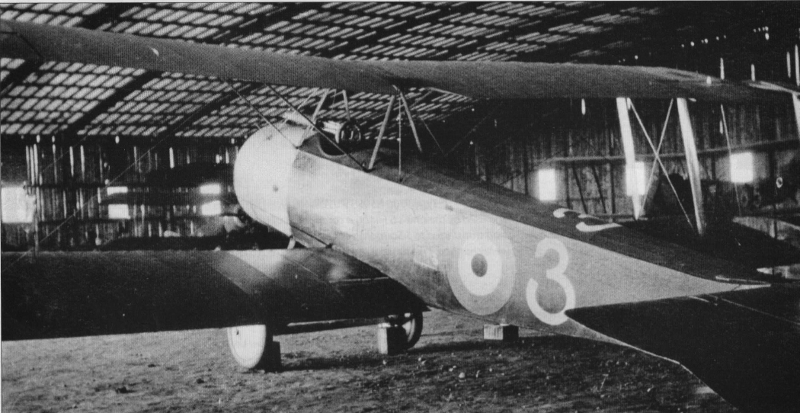
On 17 September at Castle Bromwich Vickers built “Strutter” A1060 breaks up during aerobatic manoeuvres killing 2nd Lts Syson and Hodges. RNAS 5 Wing “Strutter” A9420 on a bombing mission is hit by AA fire and forced lands in Holland where wounded New Zealand pilot Fl Lt Harkness is interned. 70 Squadron “Strutter” A1913 crashes near Hervilly after a series of fights, 2nd Lt Nixon is killed and 2nd Lt Wood is taken prisoner wounded in the head. It has been the most tragic week for 70 Squadron losing 12 pilots and observers, bringing the total over their last ten weeks on the Somme to 27, 17 killed and 10 prisoners of war. Less than a third of the original thirty-six remain and some replacements have already been lost.
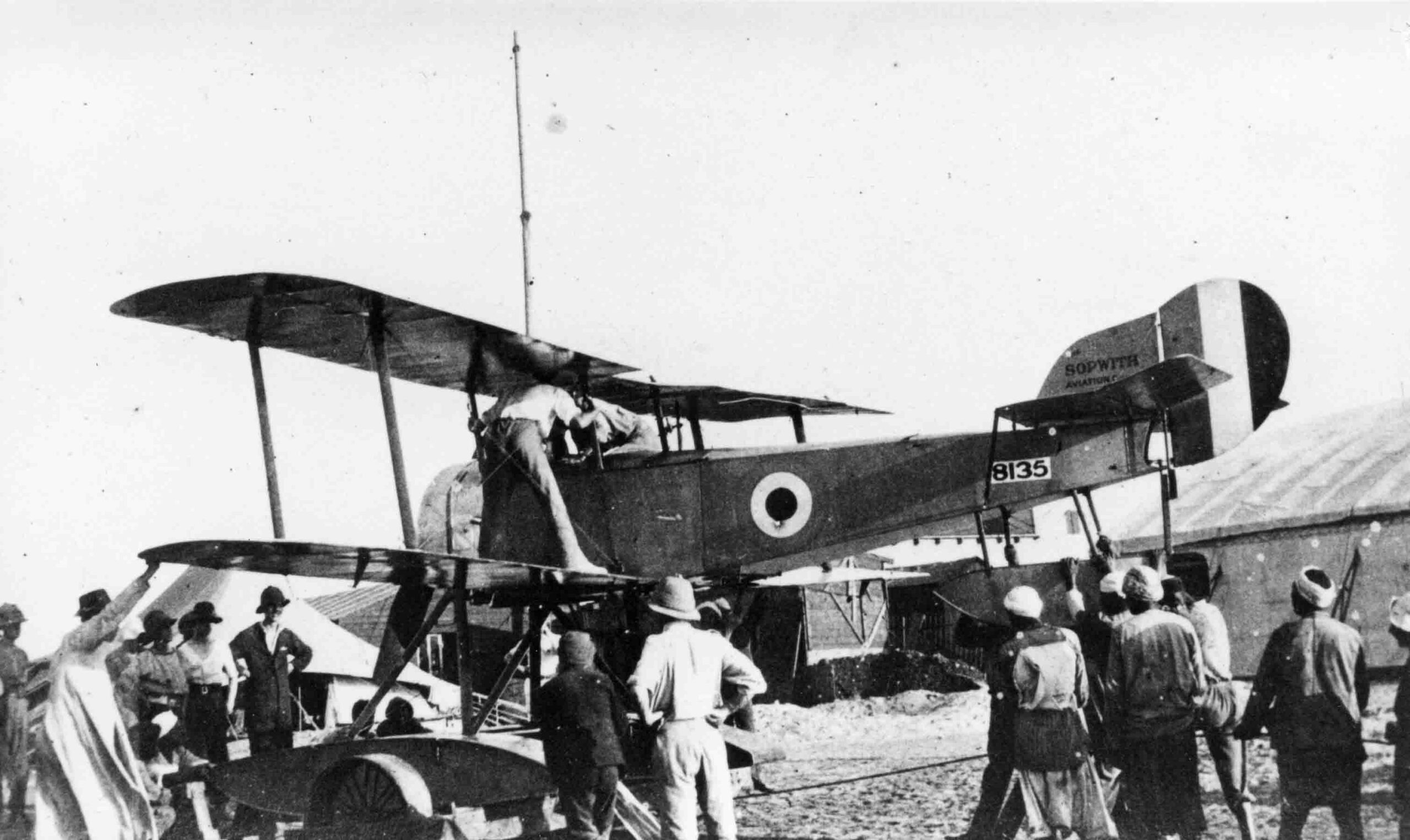
Four days ago “Baby” floatplane 8135 arrived at Port Said.(above) On 17th September flying from HMS Ben-my-Chree it is shot down in flames near El Arish. Samson’s “gallant and skilful” Fl Sub Lt Banks-Price loses his life jumping from the burning aircraft whilst he and Fl Sub Lt Nightingale are escorting a Short floatplane. Nightingale suffers a holed petrol tank but puts down and is rescued. His “Schneider” is salvaged whilst the Short puts the Fokker to flight. Nearby Fl Sub Lt Man in “Schneider” 3777 returns from another mission with engine trouble hits the water too hard and sinks. He is rescued by a trawler.
By 17th September Sopwith’s seventh production “Pup” N5186 has arrived at Chingford and the first six have all reached RNAS 1 Wing at Dunkirk but N5180 has already been wrecked in a crash. The RFC in France are desperately chasing a flight of Sopwith “Pups” from Standard Motors. Five had been promised by now but they are told “it is improbable that we shall be able to send sufficient machines before the second week in October”. Trenchard’s team also only want Scarff rear gun rings on future “Strutters”, no Nieuports. “If necessary send machines ready for Scarff rings, they can be recovered from 50% of machines struck off or sent for repair.”
On 19th September “Baby” 8195 previously stored at White City joins the Seaplane Squadron at Dunkirk.
Flight magazine reports that “with the enormous extensions of the shops in aircraft factories, Mr. Sigrist, Works Manager of the Sopwith Aviation Co has thought out a neat scheme whereby any shop foreman, manager, or other head of a department may be instantly summoned from any part of the works. Suspended from the ceiling in a central position are a series of electric bulbs of different colours, each head of a department having his own colour. If, for instance, Mr. Sigrist is wanted, a blue light is lit from the switchboard and if he does not see it at once, someone is sure to do so. Although in the execution of his duties Mr Sigrist is literally ‘all over the shop’ it took only a matter of minutes to find him, saving a lot of time and temper”.
On 20th September at Luxeuil Fl Sub Lt Scott and Air Mechanic Taylor die in a 3 Wing “Strutter” flying accident.
On 21st September 3Wing “Strutter” 9895 is in a collision whilst 2nd Lt Morgan and Lt Hardman are killed on a practice flight when RFC 70 Squadron’s “Strutter” A1915 stalls on take-off and nose dives from 150ft.
Fl Lt Hardstaff’s tests at RNAS K Section Chingford of the 110hp Clerget prototype “Triplane” N504 confirm the performance reported by the RNAS pilots in France in N500. “Loaded with 20galls of petrol and 4galls of oil, a 180lb pilot, 45lb Vickers gun and 33lbs of ammunition; corrected speeds at heights up to 6,500ft range between 113mph and 118mph with 106mph at 10,000ft. (Engine speed around 1200rpm.) Climb to 3,00ft is 2mins 45secs, to 6,500ft 7mins 40secs and 10,000ft 13mins 5secs. Stability is “Very good”, landing speed 45 knots. Engine is English built by Gwynne. More movement of empennage is required, the machine being tail heavy full-out on level and on climb.” On 22nd September Squadron Commander Harry Busteed takes the machine up to 22,000ft. He recorded 116mph at ground level. (below, “Triplane” over Chingford)
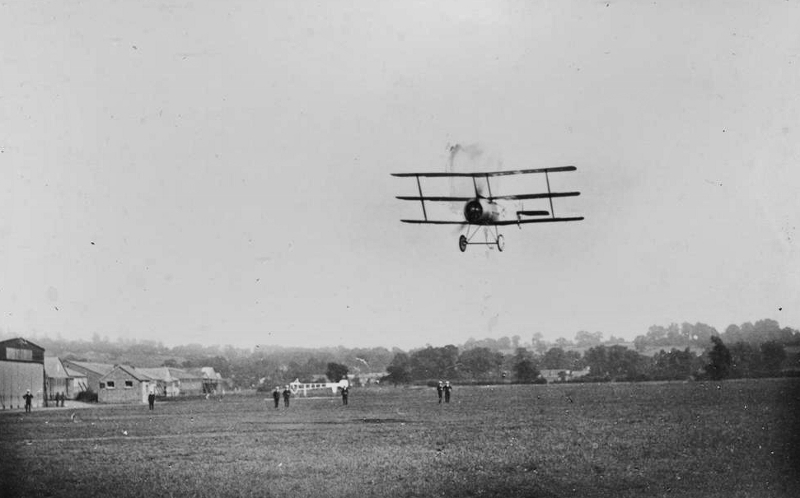
Now, Sopwith’s first production 130hp Clerget powered “Triplane” N5420 is photographed in the Canbury Park Road factory fully trial assembled (below) before being taken by road to Brooklands for flight testing.
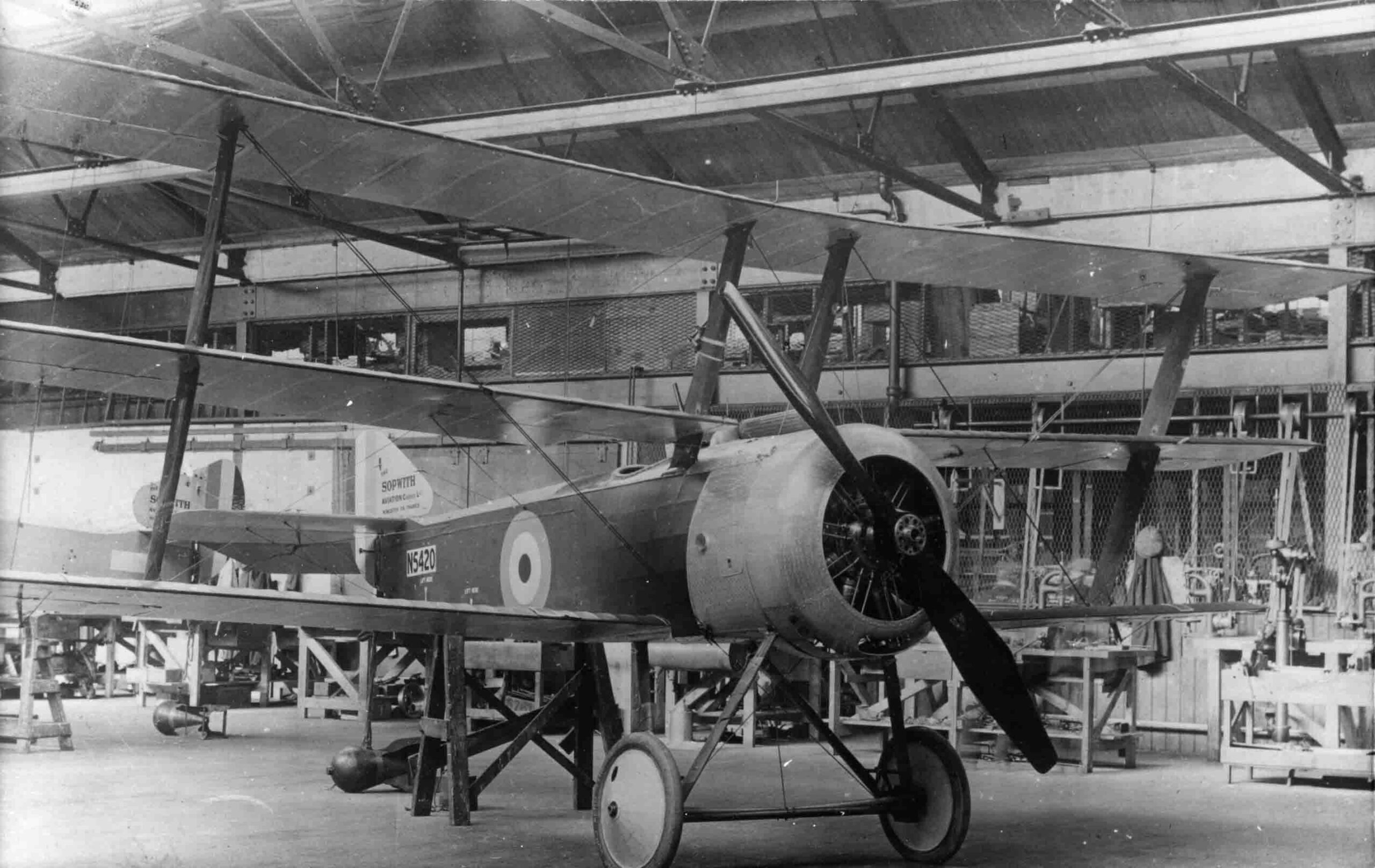
Already assembled at Brooklands is the Sopwith “Hispano Triplane” with the water cooled 150hp Hispano-Suiza V8 engine. Although the fuselage is largely based on the “Strutter”, the whole machine appears to be a scaled-up version of the Clerget “Triplane” with single interplane struts and round radiator/engine cowling despite the V8 in-line engine. The Sopwith team pose (below) with the machine in front of their sheds in the south west corner of Brooklands airfield which still display the names of the pre-war Vickers and Bristol flying schools.
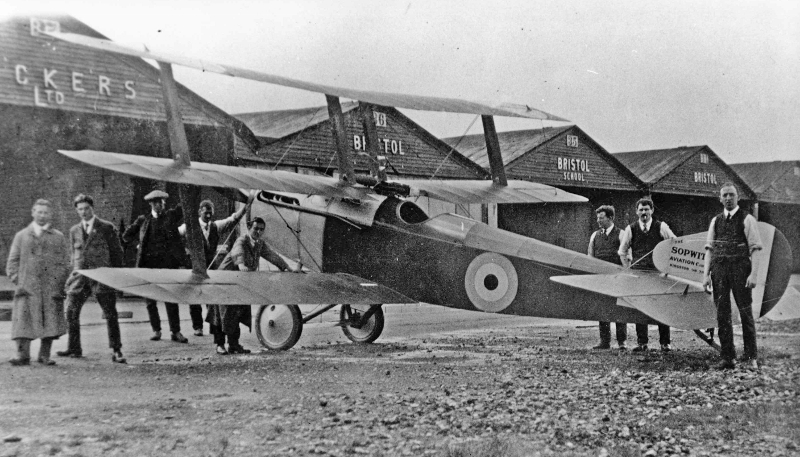
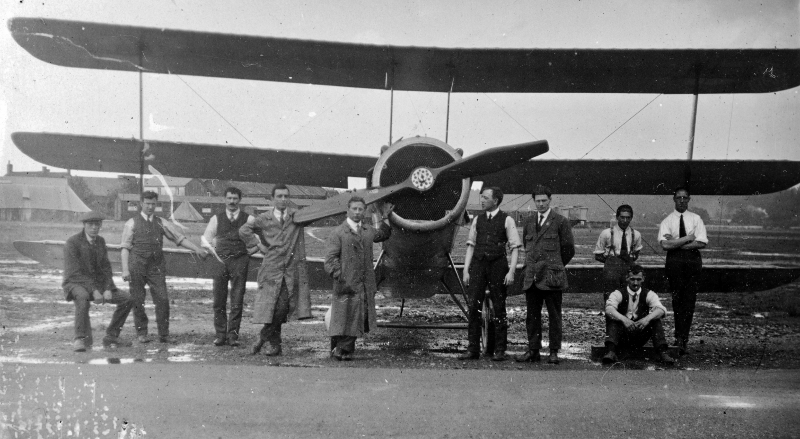
On 22nd September there is another hit-and-run attack on Dover with seven small bombs being dropped from 11,000ft. Three Sopwith floatplanes from Grain and Westgate are among 11 aircraft sent up but are too late.
On 22nd September 70 Squadron “Strutter” A1906 is wrecked in a crash landing returning from reconnaissance. Two RNAS “Strutters” and three “Strutter Bombers” attack a Belgian airfield and fight off an enemy aircraft whilst another on photo reconnaissance at 13,000ft over Ostend is twice hit by AA fire but returns safely. Sopwith’s first 130hp Clerget engined “Strutter Bomber” 9744 arrives at Luxeuil via Paris for RNAS 3 Wing.
On 23nd September six RNAS “Strutter Bombers” bombard two more Belgian airfields and another escorting “Strutter” gets Vickers and Lewis gun shots into an enemy seaplane which dives away presumed shot down.
On 23rd September Australian Lt Woodrow is killed when 54 Sqdn “Strutter” 7772 nose-dives from 8,000ft whilst 45 Sqdn “Strutter” 7773 crash lands and the pilot is injured. Both squadrons are working up for France.
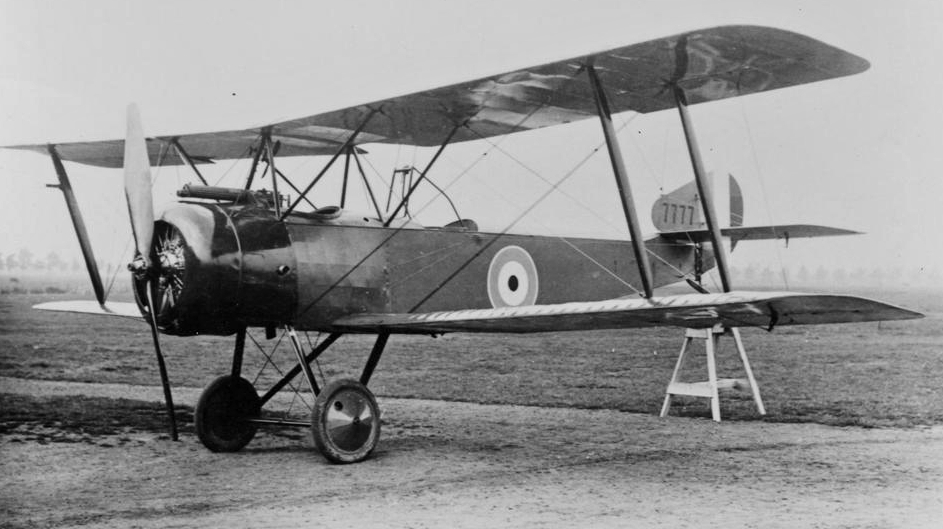
Ruston Proctor take this fine portrait of their “Strutter” 7777 (above) with Nieuport gun mounting and clear top wing panel before delivery on 23rd September from Lincoln to 45 Squadron at Sedgford, Norfolk.
At 19.15 on 23rd September Fl Lt Galpin in Yarmouth based “Baby” 8149 attacks a Zeppelin 30 miles east of Lowestoft but whilst re-loading loses it. Later Fl Lt Cadbury loses control of Yarmouth “Baby” 8196 adjusting his goggles and crashes into the sea with minor injuries. These are two of 26 sorties against a twelve Zeppelin raid on the Midlands and London killing 40 and injuring 130 in which two airships are downed, one initially by an AA shell and one set on fire by a BE2c.
By 24th September HMS Engardine’s Dundee based “Baby” 8175 has been damaged and now 8177 is wrecked on landing. “Schneider” floatplane 3785 is deleted after eight months at Calshot and Bembridge whilst 3724 & 3730 are detached from Felixstowe to the Blackwater River but 3724 is badly damaged the next day.
On 24th September French pilots fly two loaned “Strutter Bombers” from Luxeuil each dropping six 120mm Gros-Andrean bombs on the Krupps Works at Essen, the first French operation with Sopwith aircraft. With French manufacture some way away, they have requested the loan of enough “Stutter Bombers” to equip Escadrilles F29 and F123 of the 4ème Groupe de Bombardment which shares Luxeuil with RNAS 3 Wing.
On 24th September a second 80hp Gnome engined “Pup” arrives at Chingford via Northolt and Hendon whilst RNAS 1 Squadron get their seventh “Pup” N5187 but it forced lands on the beach at La Panne with engine failure. At 15.30 Australian Fl Sub Lt Goble in prototype “Pup” 3691 pursues and shoots down an LGV two-seater near Ghistelles, one of a number that had been bombing Dunkirk. This is the first “Pup” combat success.
On 25th September Fl Sub Lt Grange in “Pup” N5182 shoots at a Sablatnig SF2 seaplane which breaks up and crashes into the sea off Ostend. 70 Sqdn “Strutter”A382 is hit by shrapnel and crashes in the forced landing.
On 25 September Mann Egerton and Westland Aircraft have their Admiralty “Strutter” orders increased by twenty-five to seventy-five each. Westland Aircraft now have a single-seat “Strutter Bomber” 9700 as a pattern machine. The following day Blackburn have their orders for “Baby” floatplanes increased to forty. Also that day 70 Squadron “Strutter” A1916 goes missing after combat with six enemy aircraft, Air Mechanic Grundy is killed and 2nd Lt Echlin dies of his wounds whilst “Strutter” 7998 is wrecked hitting a tree on landing.
On 26th September A D Jones successfully flies Beardmore Aviation’s first Sopwith “Pup” 9901 for the Admiralty from Dalmuir airfield.(below) It has an 80hp Clerget but most of the 50 are to get the preferred Le Rhônes.
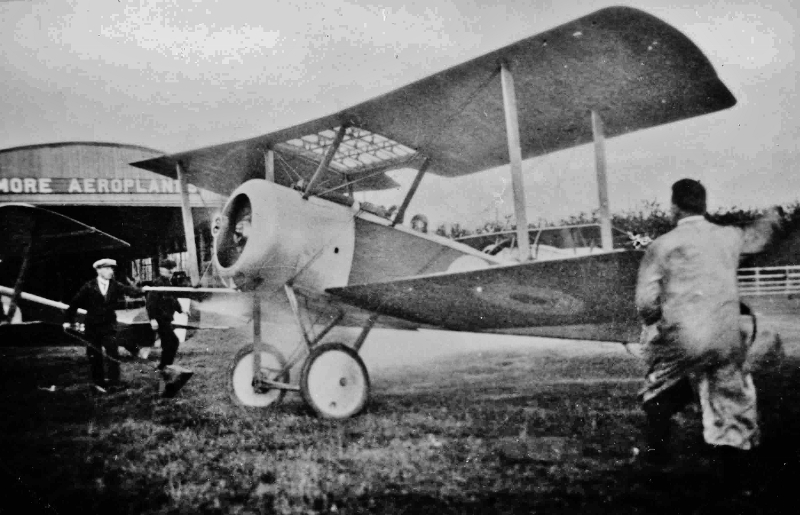
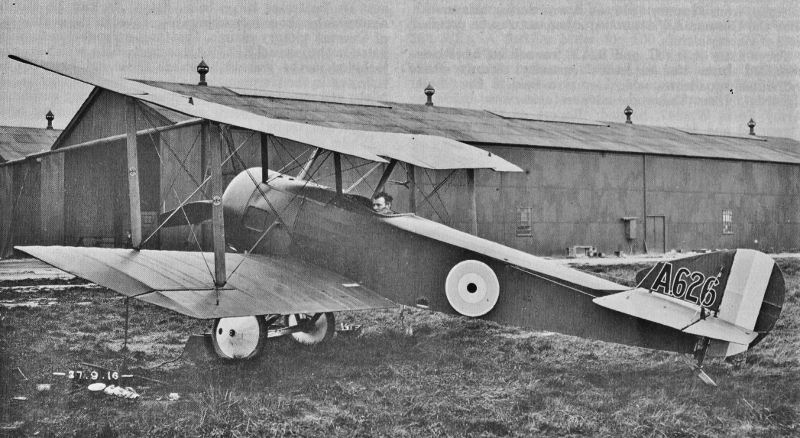
On 27th September just one day after the first Admiralty sub-contracted “Pup” is flown by Beardmore the first War Office sub-contracted “Pup” is flown by Standard Motors at Radford Aerodrome, Coventry.(above) A626 has an 80hp Le Rhône engine. Standard Motors now have orders for 100 “Pups” and await a further 150.
On 27th September the fuel tank and engine of 70 Squadron “Strutter” A1909 is hit by AA fire. Wounded 2nd Lts Faraday and Lowson are forced to land and partly burn the aircraft before being taken prisoner. Meanwhile “Strutter” A894 is crashed and wrecked landing at Fienvillers from a practice flight.
On 28th September Yarmouth based Sopwith “Baby” 8132 is wrecked in a stalled landing whilst RFC 70 Squadron “Strutter” A893 is wrecked landing from a practice flight when the pilot wrongly adjusts the fuel setting. RNAS 5 Wing “Strutter” 9402 is also crashed and damaged beyond repair.
On 29 September HMS Empress based “Schneider” 3783, now fitted with a Lewis gun and a 4 x 16lb bomb rack, goes out on anti-submarine patrol at Stavros in the Aegean.
On 29th September the second and third Blackburn-built Sopwith “Baby” floatplanes N1011 & N1012 are delivered to RNAS Yarmouth by road.
On 30th September eight unused Sopwith-built “Baby” floatplanes (8190,91,92,97,204,5,8,&9) manufactured to take 100hp Gnome engines go to Blackburn Aircraft for modifications to fit 110hp Clerget engines.
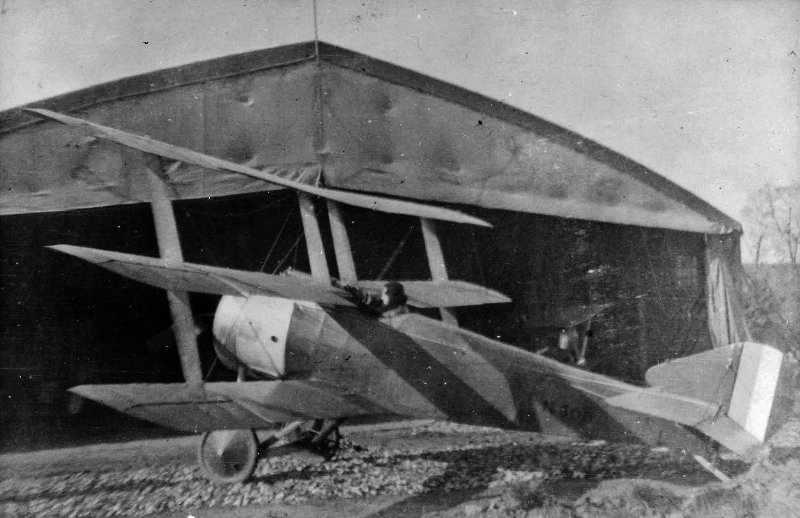
On 30th September FSL R S Dallas in hastily repaired prototype Sopwith “Triplane” N500 (above) shoots down a two-seat artillery spotting biplane near St Pierre Cappelle and drives off an enemy seaplane attacking a Belgian Maurice Farman.
On 30th September 70 Squadron “Strutter” A1915 is completely wrecked when the pilot misjudges the landing at Fienvillers from a reconnaissance patrol and 5719 is seriously damaged in a crash landing from a practice flight when it runs into a Martinsyde.
September brings an end to the undistinguished short service life of the thirty Robey-built Sopwith “Type 806” Gunbuses. 3847 is deleted from service at Eastchurch along with the five unused ones in the RNAS Central Stores Depot at White City.
September also ends the saga of the unsuccessful Sopwith “Type 860” large floatplanes when the balance of the contract is cancelled “as resources are needed for the production of fighting aircraft”. Two have never been built, the seven at Woolston will be dismantled leaving only 852 at Port Victoria for experimental trials.
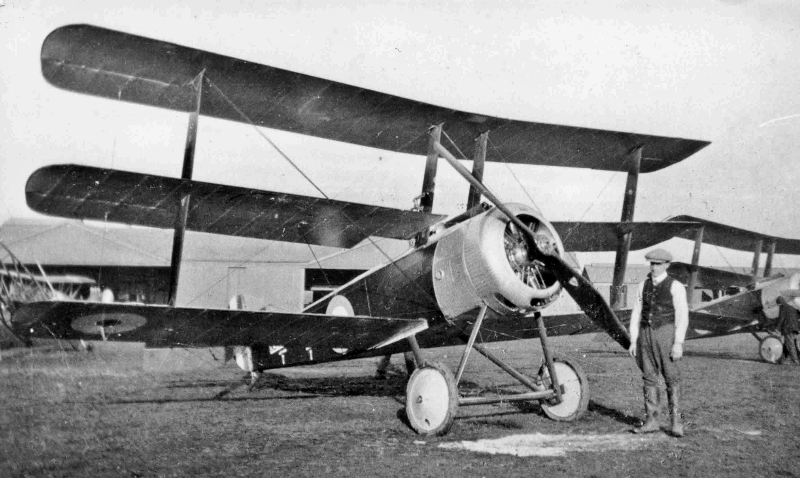
The Sopwith Works have now completed the first two production Clerget “Triplanes” N5420 & N5421. This photograph (above) may well be them side-by-side at Brooklands during testing. N5420 had been promised to the Admiralty by 30th September but that was optimistic whilst N5421 will be going to Clayton and Shuttleworth in Lincoln as a pattern aircraft to help speed them into production.
A total of 35 aircraft have left the Sopwith Works in September: 25 “Strutters”, 7 “Pups” & 3 “Triplanes”. These bring to 338 the total number of new aircraft built in the Sopwith Works in Kingston during the 12 month financial year to the end of September, more than doubling the 164 in the 1914/1915 financial year. Sales income has increased by a remarkable 80% from £247,000 to around £445,000, despite the predominance of small floatplane deliveries in the first half year. It seems likely once again that there will be more than enough profits to self-finance the further planned expansion of plant and facilities in Kingston.
The 338 Sopwith built aircraft in the last 12 months comprise 151 small floatplanes, 164 Strutters, 14 Pups, 4 Clerget Triplanes, 2 large Triplanes, 2 large floatplanes and Harry Hawker’s runabout. A further 66 Sopwith designed aircraft have been built by contractors: Robey 30, Ruston Proctor 25, Vickers 9, Blackburn 3, Standard 1 & Beardmore 1. Except for Robey, those numbers will grow rapidly as contractor’s production lines work up to speed.
An amazing 5,138 aircraft have been built in Britain over the last 12 months, a fourfold increase on the first year of the war. The rapid expansion of Britain’s aircraft industry and its growing dependence on diluted labour is illustrated by this official chart.
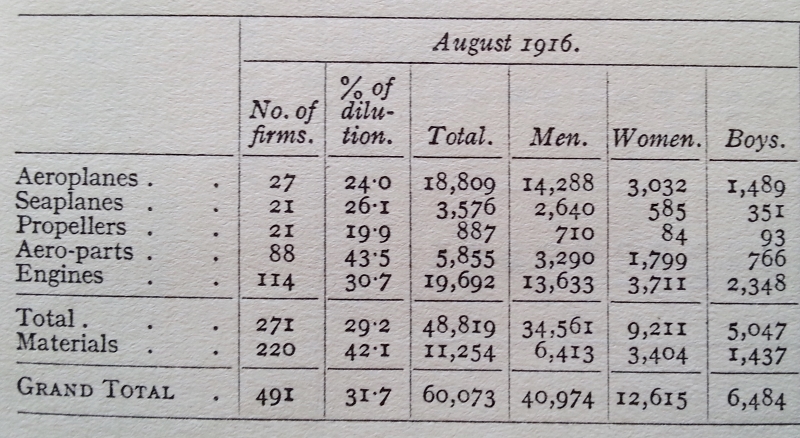
On 2nd October a 4-day-old War Office order for 100 Sopwith “Pups” from the Wells Aviation Co. in Chelsea is cancelled and replaced by an order for 100 Sopwith “Strutters”. Wells, surprisingly set up by people from the London’s art world, have recently taken on the repair of damaged “Strutter” A2985, a useful way for this new company to get familiar with the work involved in building brand new Sopwith “1½ Strutters”.
Aeroplane published the following article in late July: “Quietly and steadily, the Wells Aviation Co. Ltd. has established itself at Chelsea. The famous old art pottery which formerly occupied the site in Elystan Street has entirely vanished, and although every inch of space has been put to use, there is still not enough room to cope with the business in hand. A few months ago the company acquired part of a building in Jubilee Place, which was being used for the painting and storage of scenery for the Albambra. The whole of this building is now devoted to the manufacture of aeroplane parts. Office accommodation has been a problem, the staff having outgrown its quarters long ago. This has been solved by the purchase of two houses in Whitehead Grove, with gardens in the rear adjoining the works. A number of empty shops opposite the works have been adapted with great ingenuity to the needs of this growing enterprise. Numbers of girls are here being trained in the lighter kinds of work, such as the making of ribs, etc., and they are doing well at it. Restaurants and rest-rooms have been instituted, and the whole scheme is calculated to attract a good-class labour supply from the district. Mr. R. F. Wells is fortunate in having with him Messrs. Doyle Jones and Walter Jones, both of them like Mr. Wells occupying prominent positions in the art world and both being equally enthusiastic about aircraft. With so experienced a works manager as Mr. Beeby at hand the progress of the firm is not difficult to understand.”
On 2nd October Canadian Fl Sub Lt Chadwick in RNAS 5 Wing “Strutter” 9658 is bombing Evère airship sheds in Belgium when his engine and compass are damaged by anti-aircraft fire. Lost and forced to land behind the lines near Tirmond, the aircraft turns over. He is hidden by locals, uninjured and planning to escape across the border. The German photograph (below) shows the 12 internal bomb racks, the airbrakes up and the aircraft’s name ‘Buster Brown’ on the side.
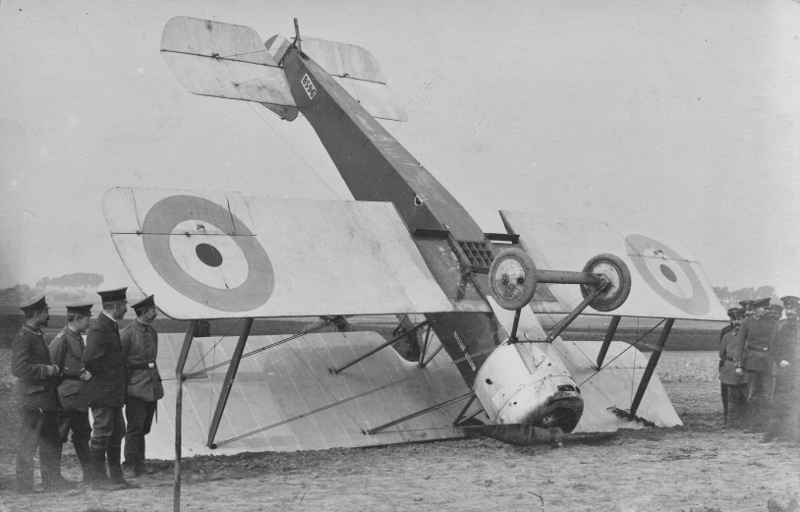
On 2nd October RFC 70 Squadron “Strutter” A381 is wrecked crash landing from a practice flight at Fienvillers and the following day Lt the Honorable M Greville is injured and 54 Sqdn “Strutter” A889 wrecked crashing 30ft from a stall at Castle Bromwich.
Despite being an Admiralty contractor, 62 Sopwith-built “Strutters” have already been transferred to the Army to which have recently been added 34 War Office contractor built machines. Only RFC 70 Squadron is in France but 45, 54 and 64 squadrons are working up to operational status at Sedgford and Castle Bromwich.
Basic flying training for RFC pilots is being done in flying schools but the quality of training depends on the instructors, few with experience can be spared, many are just recently qualified pilots and it is mostly done on old low-powered aircraft types. Up until now training on modern fast combat machines is by listening to anybody with experience and snatching flying time on the squadron’s few available aircraft. In the last week 45 Squadron tried to practise formation patrols but it is surprisingly difficult to keep even three aircraft together. There is no formal training in observation skills, observers simply learn from the older hands on the squadron. Some other RFC instruction is now more formal. Pilots and observers attend a course at the School of Military Aeronautics at Reading covering basic aerodynamics, construction and rigging of aircraft, and other technical topics including the workings of aero engines. They also go on a machine gun course at Hythe. Observers selected for artillery co-operation get a course at the RFC Wireless School at Brooklands. Groundcrew have traditionally been trained by the squadron’s seasoned NCOs but qualified riggers and fitters are now arriving after a five week course at RFC School of Instruction at Reading which opened in July 1916. The Wing Gunnery Officer has been attached to 45 Squadron to supervise the installation of guns and synchronising gear. Ready or not, 45 Squadron are expecting to start moving out to Fienvillers in France on 7th October.
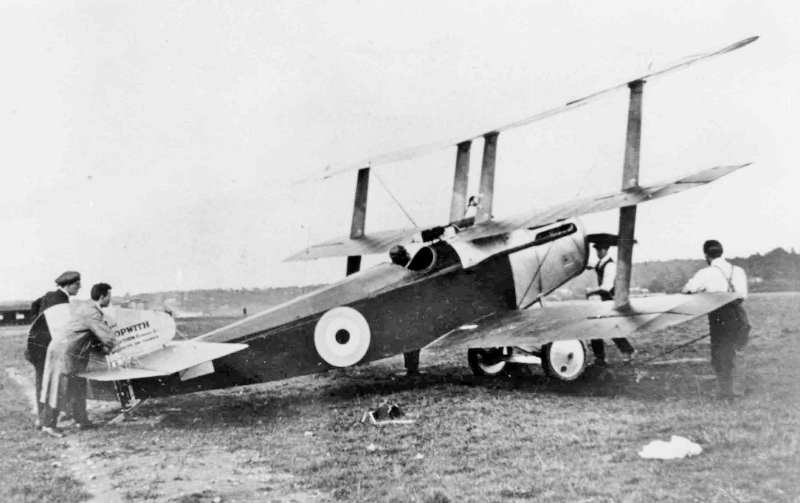
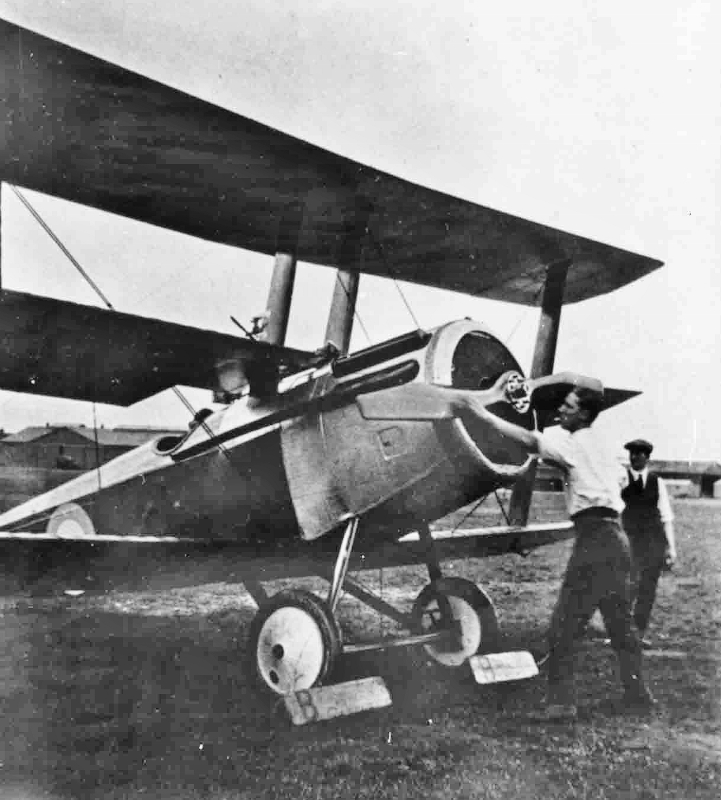
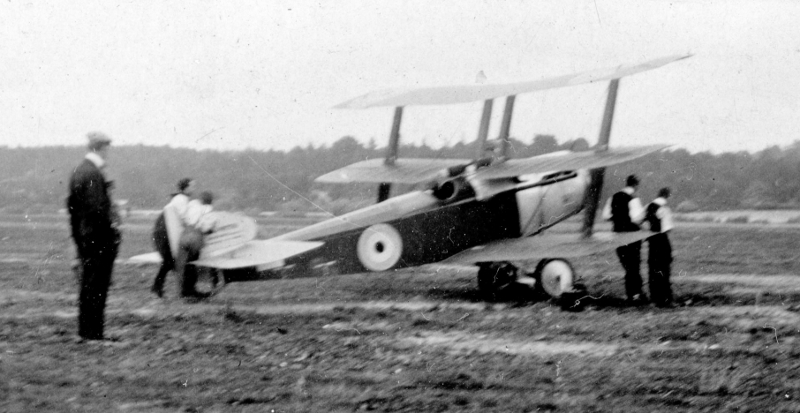
This set of photographs shows the 150hp Sopwith “Hispano Triplane”, now allocated RNAS experimental number N509, on engine trials at Brooklands. The sequence has the pilot outside the cockpit and the engine being turned over, the pilot aboard and the engine being started by Hobart Cato with a cigarette in his mouth and engine running with the tail held down and two mechanics casually leaning against the wing leading edge.
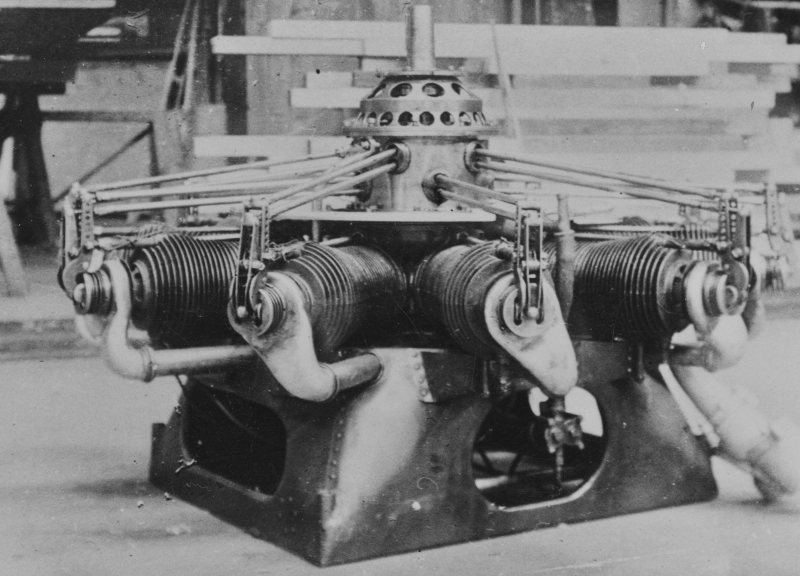
Sopwith have received this example of a Smith “Static” radial engine. (above) It is being fitted to the 111th production “Strutter” 9712. The Sopwith GA drawing (below) shows the engine uncowled. American designed, nominally 140hp and weighing only 180lbs, prototypes were flown in two Vickers Gunbuses in 1915. Production of 250 is underway at Heenan & Froude in Worcester but they are experiencing quality problems.
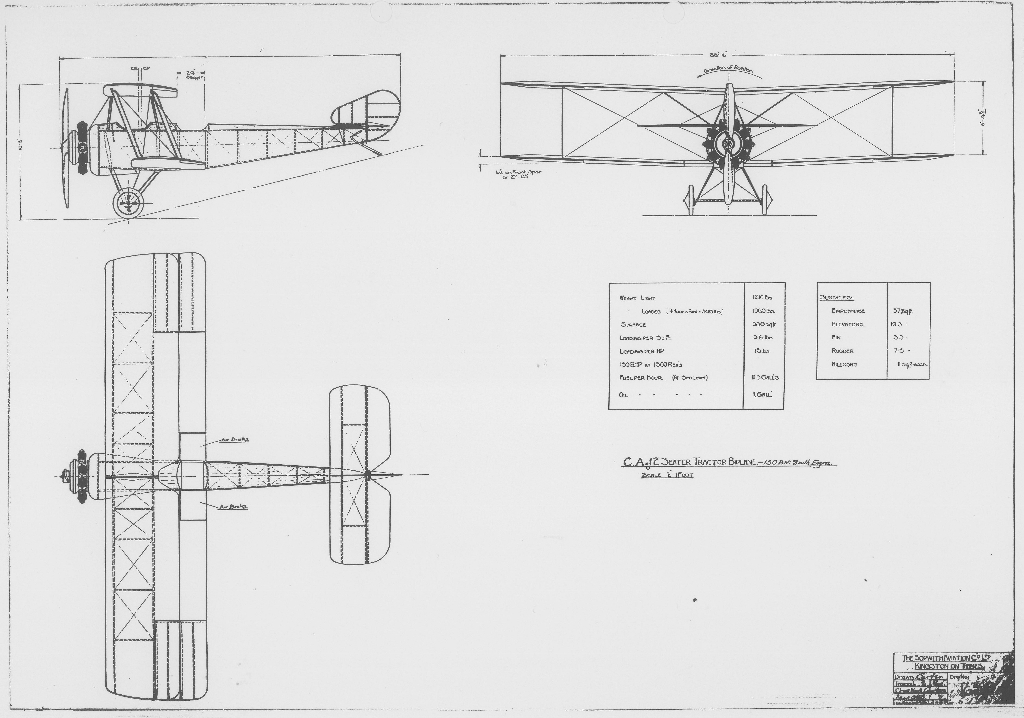
Modified after performance trials at Yeovil, the first Westland Aircraft built “Strutter Bomber” N5120 is delivered by road to Eastchurch on 3rd October with their second N5121 delivered to Hendon the next day. Fairey have also completed their first “Strutter” A954 at Hayes, a standard RFC two-seater it has gone to Farnborough and will be sent in a packing case to France this week for 70 Squadron.
Sopwith-built “Strutter” 9745 diverted to the RFC as A1924 is seen at Farnborough (below) before it is delivered to St Omer this week also for 70 Squadron.
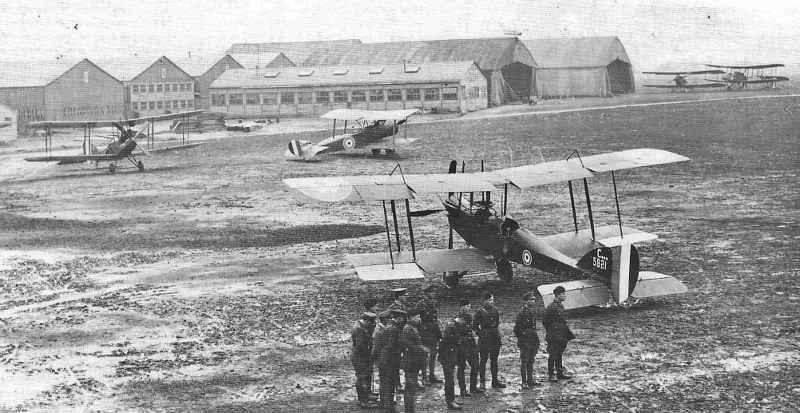
On 4th October 70 Sqdn “Strutter” is wrecked crash landing from a practice flight. The very next day 2nd Lt Mitchell is fatally injured in 70 Sqdn “Strutter” A1918 when the engine cuts out on take-off.
On 5th October the second of two Sopwith-built 80hp Clerget “Pups” 9497, probably sent to Beardmore as a bare reference airframe, has been finished and is flown by their test-pilot A Dunkinfield Jones at Inchinnan.
On 6th October the first Westland-built “Strutter Bomber” N5120 is accepted by Harry Hawker at Eastchurch.
On 6th October the undercarriage on 70 Squadron “Strutter” A1902 is smashed practising landing in the dark.
In five months to 7th October ten different pilots have flown Sopwith ”Baby” floatplanes on twenty-five flights off the foredeck of HMS Campania using wheeled trolleys. A similar number of flights have been achieved with larger Short floatplanes and earlier some with a Bristol Scout. With deck launches of aircraft at sea clearly practical, thoughts are turning to designing specialised ships for wheeled aircraft eliminating the need for heavy draggy floats and extending the sea states when flying is possible. Sopwith “Pup” 9497 has already been allotted to go to RNAS Grain for deck landing experiments. Murray Sueter seizes the opportunity to pursue his long-standing dream of naval aircraft sinking enemy warships with torpedoes. The Sunbeam-powered heavy Sopwith and Short torpedo carrying floatplanes have not been a success needing calm conditions for take-off.
On 9th October Thomas Sopwith receives the following “Most Secret” letter by Admiralty courier from Commodore Murray F Sueter. “Will you please go into the question, with as little delay as possible, re-Torpedo-carrying aeroplane with 4 hours fuel and pilot (1) to carry 1 x 1,000lb locomotive torpedo, (2) to carry 2 x 1,000lb locomotive torpedoes. Torpedo aeroplane will probably be discharged by catapult, giving the machine an acceleration of 90 ft/sec in 60 feet. Details of Short 225 seaplane attached.”
On 10th October 70 Squadron offensive patrols supporting the Somme offensive are in combat with many enemy aircraft. In “Strutter” A382 the fuel tank is hit, observer 2nd Lt Lawledge is killed, and pilot Lt Lawson forced down and taken prisoner: the victory is claimed by Ltn H Imelmann. “Strutter” A1921 is damaged when hit by AA fire and an enemy aircraft, observer 2nd Lt Corry is wounded. A2984, damaged two days ago when a Martinsyde ran into it, is wrecked landing out at 9 Squadron’s aerodrome after shooting its own propeller away with its Vickers gun and A379 is wrecked when Capt Saxby lifts the tail too high on take-off.
On 10th October second Westland “Strutter Bomber” N5121 is accepted at Hendon to be prepared for 3 Wing at Luxeuil. It is to be joined there this month by N5122, N5123 and N5124.
45 Squadron’s motor transport column of 49 vehicles and 79 men left Sedgeford for Avonmouth six days ago and a second column left two days later. Without their tents the pilots and mechanics (deemed more useful than observers in the event of a forced landing) are quartered in the Hunstanton Hotel awaiting suitable weather. Despite the weather two Flights take-off on 10th October. One pilot steers a reciprocal course going off at 180 degrees towards Lincoln but manages to get back to Sedgeford before dark, another with engine problems is forced to land puncturing a tyre. The four remaining aircraft of B Flight confronted by towering clouds call it a day at North Weald. On 11th October they head out over the Channel immediately losing one machine and trailing another with a faltering engine. Then A1061 suffers an engine failure and puts down 7kms short of St Omer. The other three make it there to be joined by Major Read and just one of C Flight the rest having got lost. It takes ten men an hour to retrieve A1061 from a ditch but it is dismantled and taken to St Omer to be re-rigged. The six pilots and six mechanics decide to pause at St Omer and take stock.
Meanwhile on 11th Calshot based “Schneider” floatplane 3780 overturns landing in a rough sea but is salvaged.
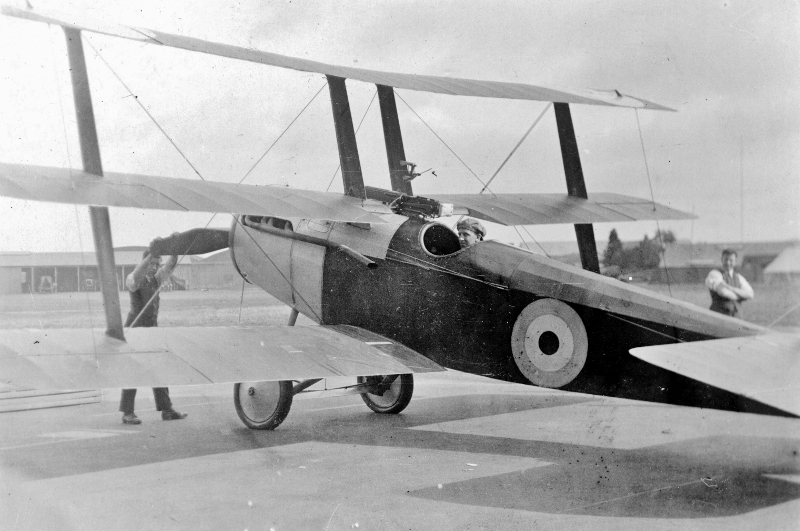
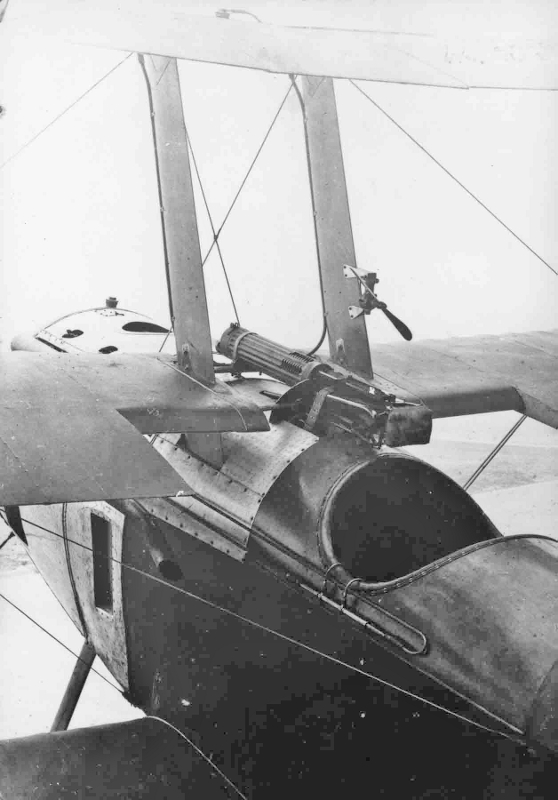
These further photographs of the 150hp Hispano-Suiza powered Sopwith Triplane N509 at Brooklands show Harry Hawker in the cockpit, the Vickers gun installation and the fuel pressurisation pump with its small propeller on the cabane strut.
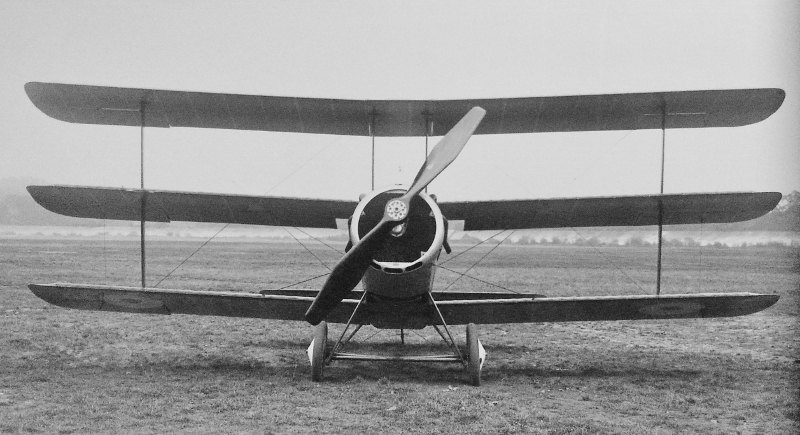
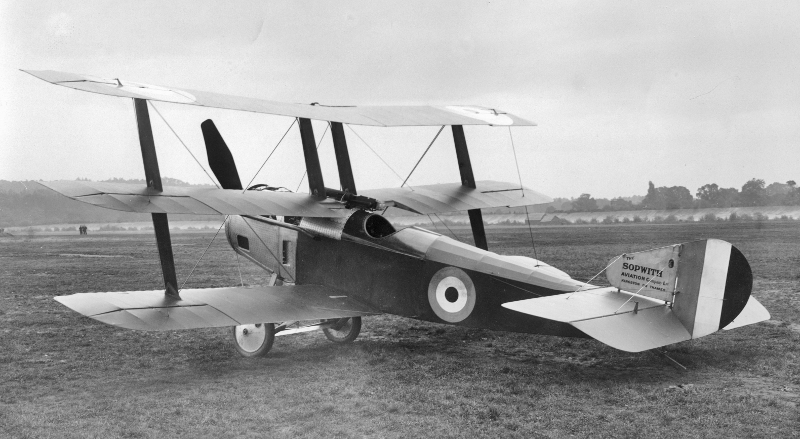
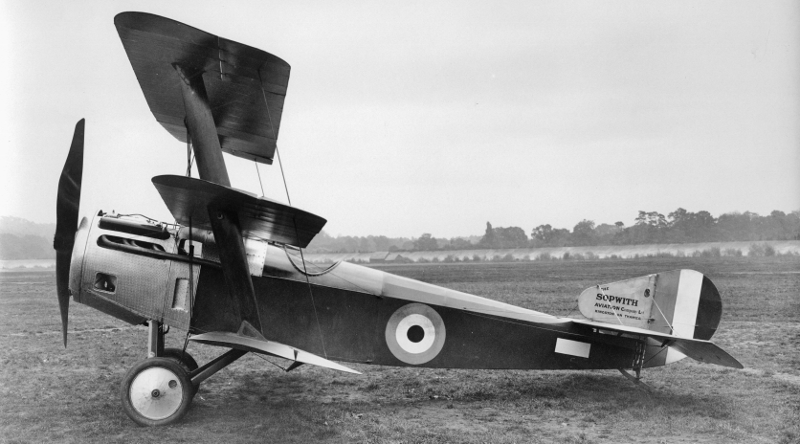
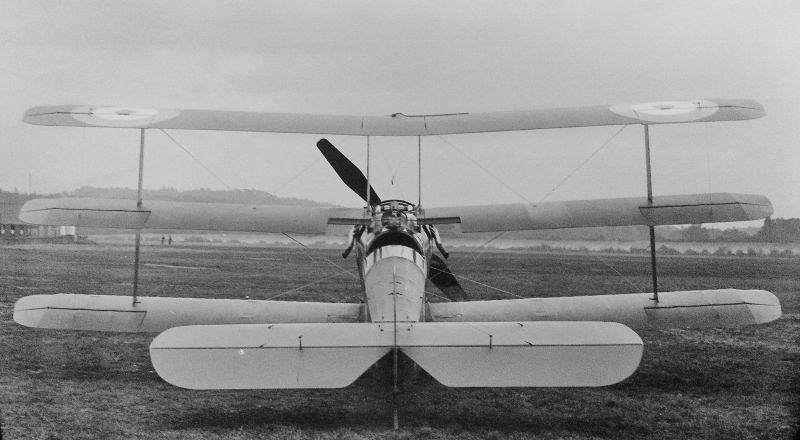
N509 has now been joined at Brooklands by N510 (above, a second Hispano-Suiza Sopwith Triplane. This has a similar engine but with a 4:3 speed reduction spur gearbox allowing it to be run faster and produce an extra 50hp whilst the propeller still rotates at the optimum speed. The only external difference between the 200hp and 150hp aircraft is the slightly higher propeller position, cooling slots in the engine cowl and no visible fuel pressurisation pump. (Note the small gearbox below the propeller in the first image)
On 12th October twenty-one aircraft from RNAS 3 Wing at Luxeuil set out on the first mass strategic bombing raid with at least twenty-five aircraft of the co-located 4ème Groupe de Bombardment to bomb a Mauser rifle factory at Oberndorf in the Rhine Valley 108 miles away over the Vosges and Black Forest mountains. Practice has shown how difficult it is to find and join a particular formation of aircraft. To distinguish aircraft of Red and Blue Squadrons large red or blue squares have been painted on a white background behind the roundel on 3 Wing’s “Strutter Bombers” and, in the case of Red Squadron, on top of the tailplanes. The formations include four French Nieuport fighters and seven two-seat “Strutters” also displaying the coloured squares. (below)
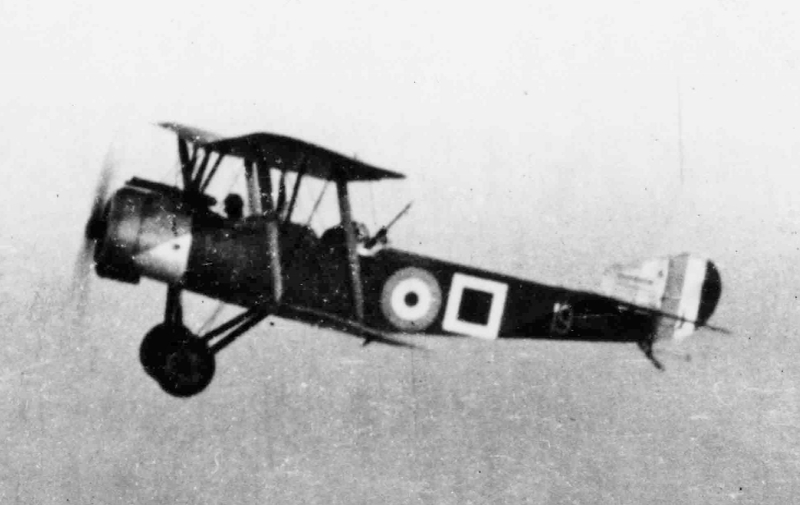
Red Squadron follows the first French group hitting the target from 6,000ft and returning in formation unscathed 4 hours later. Altogether 3,900lbs of 3 Wing explosives fall on the industrial complex. Other formations meet more effective German defences. Seven French aircraft and three RNAS aircraft fail to return. All four crew of two RNAS Breguet bombers are taken prisoner. Canadian Fl Sub Lt Butterworth is also captured with his “Strutter bomber” 9660 after being shot down injured by a Fokker DII. FL Sub Lt R Collishaw flying 130hp “Strutter” 9407 claims a Fokker biplane shot down. FL Cmdr Jones and Sq Ldr Downes in 9654 claim they send a two-seat biplane out of control before they are forced to land 35 miles south of Luxeuil. “Strutter” 9741 also forced lands away from base and 9661 is damaged on the raid. Following their heavy losses the slow French Breguet and Farman pusher bombers are deemed suitable only for night bombing. The “Strutter” bombers are more of a success the pilots finding they can outpace the fighters on the return journey. More “Strutter bombers” are now to be transferred to the French force.
On 14th October Sopwith’s 9th production “Pup” N5188 flying from Hendon to Dover and Dunkirk is somehow damaged at Harty Ferry on the Isle of Sheppey and will be taken back to Hendon for repairs. Meanwhile 70 Squadron “Strutter” A882 is damaged by machine gun fire after straying across the lines on a practice flight.
Also on 14th October after 3 days at RFC St Omer, five 45 Squadron “Strutters join 70 Squadron behind the Somme battlefield at Fienvillers. This is a crowded aerodrome also home to 19 Squadron’s BE12s and 27 Squadron’s Martinsydes all of Wing Commander Dowding’s 9th Wing uniquely assigned not to a Brigade but to the RFC General Headquarters. Few preparations have been made for 45 Squadron, there is a hut and three bell tents as offices but no rations, water, blankets or accommodation. Five more of their “Strutters” arrive the following day and two the day after. 2nd Lt Glorney immediately wrecks 7776 in a crash landing. This is not a rare event, 70 Sqdn “Strutter” 5719 is wrecked that day crash landing from a practice flight and the previous day the undercarriage of 70 Sqdn “Strutter” A2431 collapsed on landing. 45 Squadron’s motor transport columns finally arrive on 16th October with the other squadron members and their equipment. The squadron’s strength is reported as 27 officers and 183 other ranks, not just observers, fitters and riggers but drivers, storemen, blacksmiths, carpenters, sailmakers, cooks and butchers many recruited as ready-qualified civilians.
Sopwith have built more than 160 “1½ Stutters” for the Admiralty before taking these photographs (below) of N5093 at Brooklands to illustrate the full extent of protection afforded by the Lewis gun on the Scarff ring mounting.
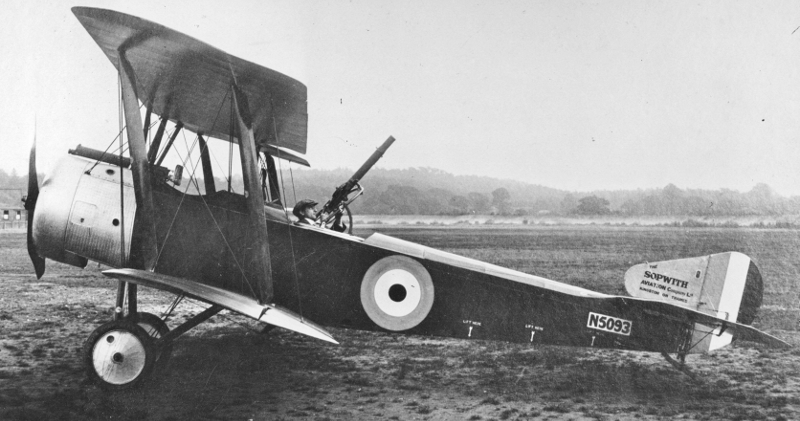
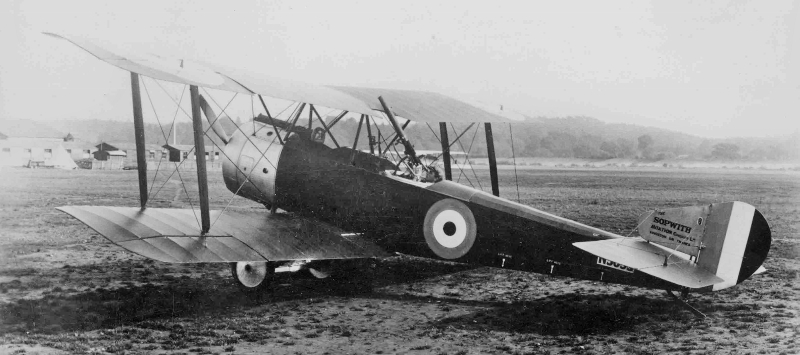
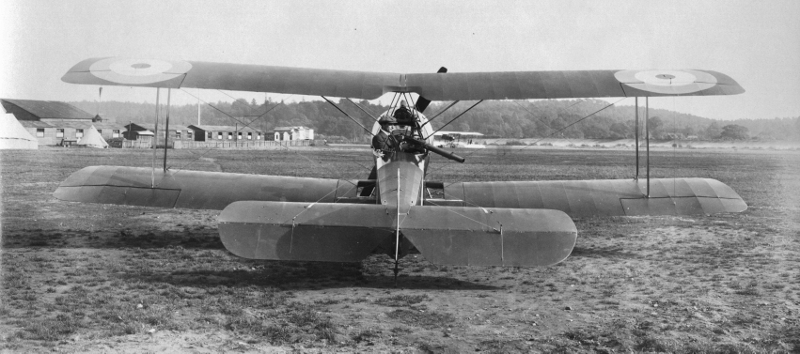
On 18th October the War Office re-allocates the 100 Sopwith “Pup” contract recently placed in error on Wells Aviation ordering 50 each from Darracq Motor Engineering of Fulham and Whitehead Aircraft of Richmond upon Thames. Almost immediately the Darracq order is cancelled for them to build more FE8s and Whitehead get their order increased to 100. The Whitehead Company three miles from Kingston becomes the RFC’s second “Pup” supplier alongside Standard Motors. Both have more “Pups” on order than Sopwith themselves.
On 18th October the second prototype Sopwith “Triplane” N504 upgraded with the 130 hp Clerget engine is flown By S Cmdr Busteed and Fl Lt Jackson for the Design Flight at Eastchurch. Its tail is to be strengthened.
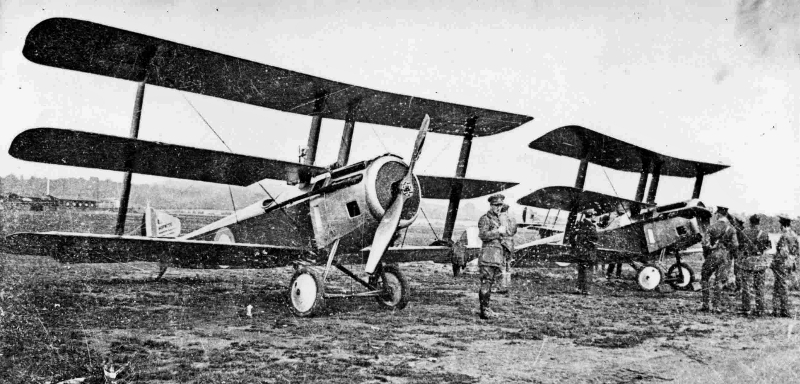
The 150hp and 200hp Sopwith “Hispano Triplanes” N509 & 510 are photographed together at Brooklands (above) before going to the RNAS Design Flight at Eastchurch on 20th October. On a second test flight that day N510 suffers severe tail flutter during a speed test. The tail breaks away and the machine crashes from 100ft killing RNAS test pilot Fl Lt L H Hardstaff.
The first prototype Sopwith “Pup” 3691 is now at RNAS St Pol, Dunkirk for a complete overhaul after three months active service with C Squadron 1 Wing. Following discussions with Sopwith’s representative in France they request a long list of new parts to bring it up to the standard of the recently received production “Pups”.
On 20th October 45 Squadron “Strutters” makes their first operational mission, a defensive patrol over the battlefront of the Somme and have a brief skirmish with four enemy aircraft. A2431 makes a forced landing to clear a jammed gun whilst 7782 is badly shot about and hits a fence on landing back at Fienvillers.
On 21 October 45 Squadron “Strutters” fly more defensive patrols and 7778 is wrecked landing when a reconditioned engine fails. 2nd Lts Fenwick & Bennet suffer facial injuries. 70 Squadron’s A1924 is wrecked crashing on take-off at Fienvillers and A892 is damaged whilst out on reconnaissance.
Meanwhile on 21st October RNAS Australian Fl Sub Lt Dallas claims another victory in 1 Wing’s 110hp prototype Sopwith “Triplane” N500 shooting down an enemy LVG biplane over Dixmude. Named ‘Brown Bread’ N500 is pictured(below) with a Nieuport probably at Furnes.
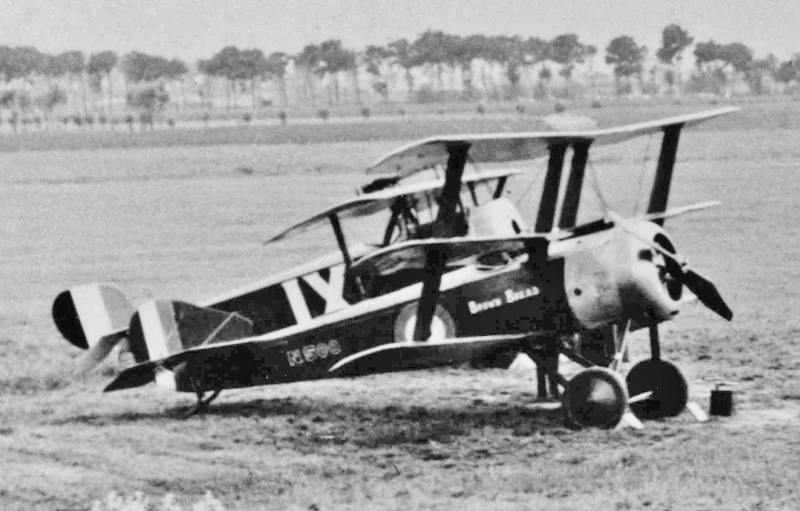
On 22nd October Canadian RNAS Fl Sub Lt Galbraith destroys a German floatplane, his first victory in a “Pup”. The next day FL Lt Keeble in “Pup” N5183 also destroys a seaplane off the Belgian coast.
On 22nd October six RFC 45 Squadron “Strutters” are prepared for a five aircraft patrol. Four get away but after five minutes 8888’s Clerget sheds a cylinder. Without any distinguishing markings, the others fail to link up, two mistaking 70 Squadron machines for their companions. A1066 is damaged in combat with five Albatros DIIs and Lt Surgey is wounded but they claim an Albatros sent down out of control. At 10.15 another patrol of four takes off, one returns with a jammed gun but 7777, 7786 & A1061 are unfortunate enough to be attacked by some of the leading pilots of Jastas 2 & 4, the crack German fighter squadrons on the Western Front including Oswald Boelcke. All three are shot down. Sgt Snowden and 2nd Lts Samuels, Wade, Thuell & Fullerton are all killed in action whilst Cpt Porter is taken prisoner fatally wounded.
The last three days have seen the heaviest aerial combats yet over the Western Front. With the newly strengthened opposing air forces lured out by good weather casualties have been tragically high.
Also that day, 70 Squadron “Strutter” A1908 on reconnaissance is wrecked in a forced landing and A1069 is wrecked after an engine failure taking-off on the last leg of its delivery flight from Sedgeford to 45 Squadron. On 23rd October “Strutter” A1072 is wrecked on its way out to 45 Squadron in France.


The photographs of RNAS 3 Wing “Sopwith “Strutters” at Luxeuil (above) show their flight/squadron markings are getting more complex than the initial simple red and blue squares on white. At short notice some have moved 60 miles north Maleville near Nancy to reduce the distances to key strategic German targets along the Moselle and Saar rivers.
In daylight on 23rd October at least ten 3 Wing “Strutter bombers” and six fighters follow up the French overnight raid on the Thyssen iron works at Hagendingen, meeting heavy but inaccurate AA fire and no German aircraft. Three of the five blast furnaces are damaged.
On 23 October Sopwith-built RNAS “Pups” N5190, 92, 93 & 94 which have arrived at Dunkirk over the last six days go to join others at C Squadron RNAS 1 Wing now at Vert Galant. With the delayed delivery of the RFC’s own Standard Motors built Sopwith “Pups” it had been agreed that these four were to be diverted to RFC 60 Squadron in France as A8732, 3, 4 & 7 but 60 Squadron has now acquired sufficient Nieuport 16s.
Over the last week the second Standard Motors built 80hp Le Rhône Sopwith “Pup” A627 has arrived at RFC 54 Squadron at Castle Bromwich whilst the first A626 has been undergoing trials at the RFC Central Flying School at Upavon. The trial reports state that it is fitted with Vickers interrupter gear but no gun. The average speed at ground level over a short reciprocal course is 113mph. It achieves 105mph at 5,000ft and 101mph at 11,000ft dropping to 85mph by 15,000ft. The climb rate is 1,000ft/min to 2,000ft, 5,000ft is reached in 5mins20secs and 10,000ft in 16mins after which the rate of climb is less than 400ft/min taking 29mins10sec to reach 15,000ft. In a calm wind take-off run is “about 40 yards” and landing with engine stopped is “about 60 yards”. It takes 3 minutes to prepare the engine for starting, uses about 6 gallons of petrol and 10 pints of oil per hour. It is “very similar to the Bristol Scout but of lighter construction giving better performance and lower stalling speed” but “very uncomfortable to fly in rough weather probably due to its light loading and small size. It is difficult to handle on the ground in wind”. There is a list of suggested improvements in design including the need for steel axles not duralumin, a back rest for the pilot, packing around the cowl to prevent oil leaking over the windscreen and on the gun, fuel tank to be divided or a second tank, top plane centre section to be covered with transparent material. The report recommends that “the calculations of this machine be gone into at once and that it be sand tested. It is doubtful whether it is sufficiently strong to stand up to a dive and sharp flatten out, necessary in this type of machine”.
On 23rd October Dunkirk based Sopwith “Baby” floatplane attacks a German LVG two-seater at 11,00ft but his Lewis gun jams after eight rounds due to faulty ammunition and he has to abandon the attack.
On 24th October Dundee based “Baby” floatplane 8177 is wrecked on landing and sister-machine 8175 is severely damaged by a gale. 45 Squadron’s 2nd Lt Glorney is killed when he crashes in Kent ferrying a new “Strutter” from Lincoln. In France, 45 Squadron “Strutter” A1064 is wrecked on an instructional flight as is 70 Squadron’s A1921 when it hits a tender during take-off.
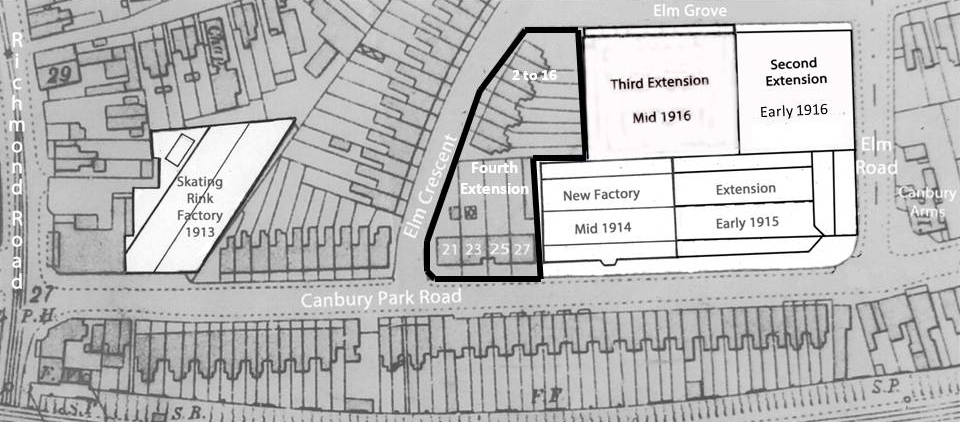
With the twelve homes in Elm Crescent and Canbury Park Road already demolished and rapidly escalating demand for their aircraft, Sopwith’s architect A J Windybank submits plans to the Council for a fourth extension to the factory. The plan is to extend westward the single story 1914 factory and the two, partly three, storey third extension to increase total workshop floor area by some 15% and to erect an imposing three storey brick office building on the corner of Elm Crescent and Canbury Park Road. On 25th October Windybank receives a letter from the Borough Surveyor enclosing a disapproval notice pointing out that for a three storey building it is necessary to have 22 inch walls. Apart from wall thickness there are requests for clarification on numbers of people, washing facilities, drains ventilation, fire escapes etc. indicating that they are likely to approve revised plans. However there is a second set of issues noting that extensions two and three submitted in March have never been approved and that the iron store on the roof is now brick making it a three storey building requiring thicker walls. The acetylene plant, tool maker’s shop, part stores and paint shop are deviations raising questions about ventilation. They note that the acetylene shop is over a foul manhole, the staircases are not as originally proposed and there are doubts about the fire escapes. Some of this may be difficult to resolve as the buildings are already in use.
The Sopwith Experimental Department based in the roller skating rink factory is now also using some garages off the Cromwell Road on the other side of the railway to help cope with their workload.
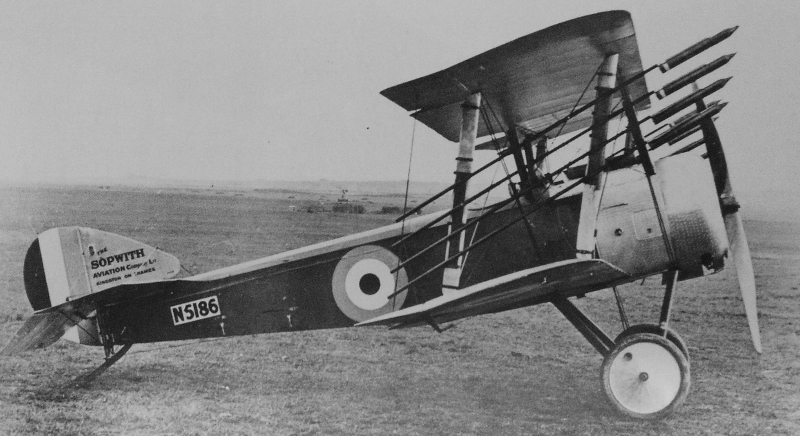
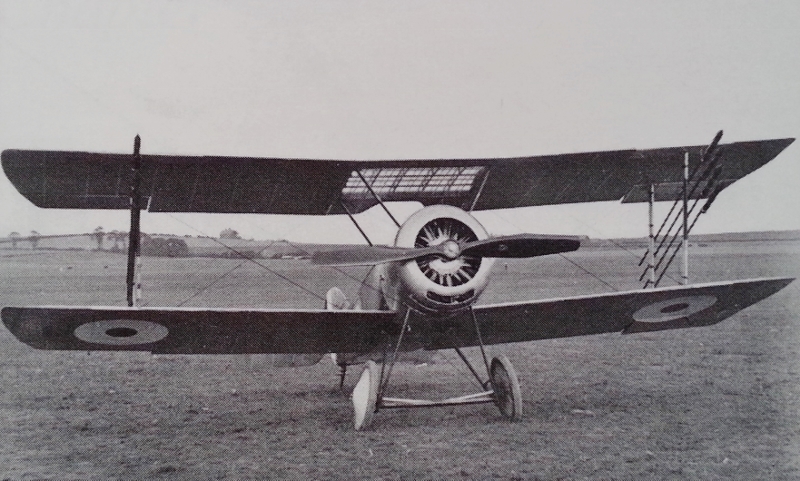
On 25th October Sopwith “Pup” N5186 is at Eastchurch (above) with a trial installation of eight rockets on the wing struts. Triggered electrically, individually or in a salvo, and intended for use against airships and balloons, the RNAS have been experimenting Le Prieur ‘Aerial Torpedo’ rockets using ten on at least one Sopwith “Baby”. (below) They are also testing Brock ‘Immediate’ rockets.
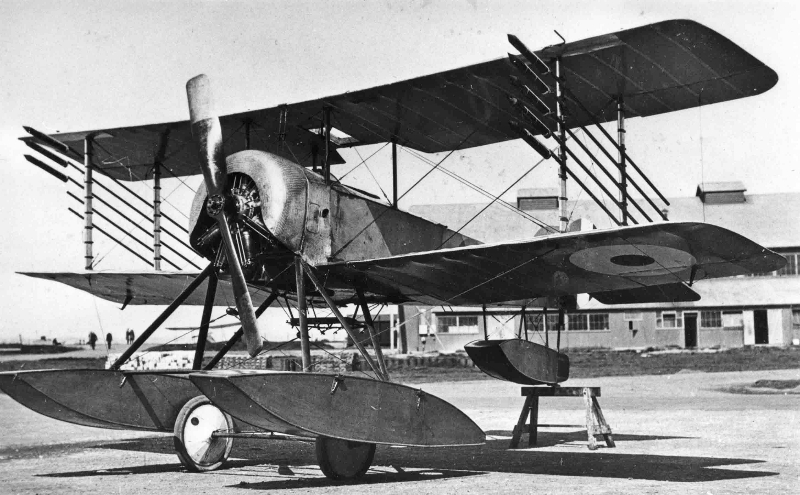
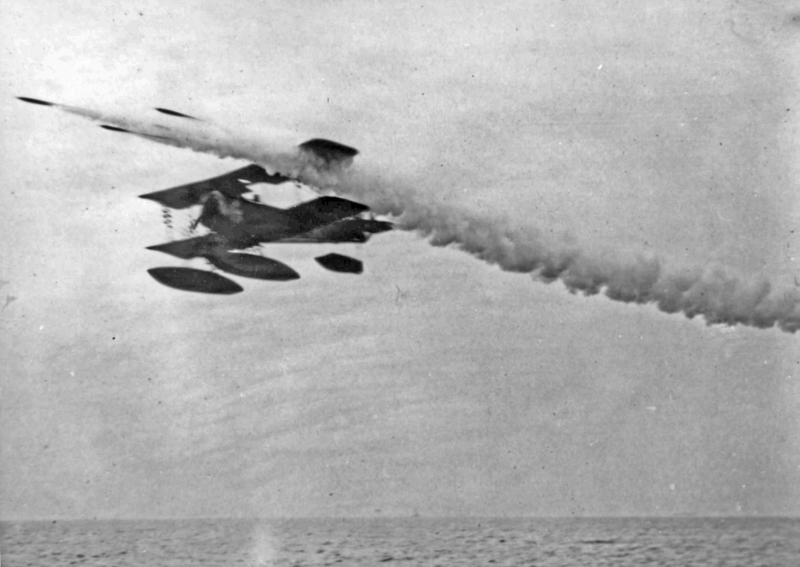
On 25th October the only Sopwith 80hp “1½ Strutter” trainer 9891 is deleted after 13 weeks with the RNAS.
After a partial move to Nancy last week, RNAS 3 Wing is moving permanently slightly further north to Ochey. On 25th October Canadian Fl Sub Lt R Collishaw ferrying “Strutter” 9407 from Luxeuil without a rear gunner strays eastward and is jumped by six enemy scouts. In a stream of bullets his goggles are hit, filling his eyes with powered glass. Hardly able to see he flings the aircraft around to throw them off but as his sight returns discovers that he is close to the ground. A German diving steeply on him miscalculates and crashes into a tree. He waits for each subsequent attacker to fire before turning inside them until one flies across his nose and he hits it flipping it into a vertical dive. He finally shakes off his pursuers and heads back west landing at a likely airfield only to discover he is taxying amongst aircraft with Iron Cross markings. Jamming the throttle forward he takes off clipping the tops of two trees but gets home. These are Raymond Collishaw’s first two victories.
Whilst RNAS’s Dunkirk Wings are intent on reducing the menace of German submarines in the English Channel with bombing raids on Belgian ports, their fighting scout pilots are meeting little opposition apart from an occasional floatplane. Consequently Trenchard’s urgent appeal to the Navy for aerial support over the Somme is answered by the formation 8 (Naval) Squadron of volunteer experienced RNAS fighter pilots with flights of six Sopwith “Pups” from 1 Wing, six Nieuport scouts from 4 Wing and five Sopwith “1½ Strutters” from 5 Wing. By 26th October 8(N) Squadron is at Vert Galand airfield 65 miles south of Dunkirk close to 45 & 70 Sqdns at Fienvillers. Pilots, aircraft & supplies will come from Dunkirk but it will be under the command of RFC 22 Wing.
On 28th October “Pup” N8253 of the new 8(Naval) Squadron is damaged at Fienvillers.
On 30th October the Admiralty invites RNAS Headquarters at Dunkirk to list minor modification felt to be necessary with the next order for 50 “Pups”. Dunkirk’s Squadron Commander immediately suggests five: fuselage side cut down further to allow the pilot to lean over, wooden straight control stick to allow more side movement than the Y handle and stop the chill from the metal one at high altitude even through gloves, flexible copper fuel tubing with long nipples to avoid solid pipes and rubber joints which perish blocking jets and choking pipes, remove the windscreen on the handle of the gun which gets clouded by oil making it impossible to sight the gun and substitute a small pad, fit ammunition belt shields to avoid interference with the gun mechanism. He will be reporting defects with the gun synchronising gear and ammunition belt wheel.
On 31st October the Sopwith Board approve a Lloyds Bank account for their Paris office with an overdraft of up to £50. They also endorse a salary Increase to £500 per annum for Company Secretary H P Musgrave backdated to 25/12/1915. They also approve and seal applications for six patents: Improved device for attachment of cable, wire and the like on aircraft. Improved construction and arrangement of seat for observer or pilot. Improved construction and arrangement of axles. Improvements in and relating to windscreens for the pilot or observer operating guns. Improved means of operating empennage (tailplane, rudder or the like). Improvement in or connected with wind brakes for aeroplanes.
In just four flyable days since 22nd October the RFC have lost sixteen aircraft in action with twenty-four airmen dead, four taken prisoner and five wounded. The superiority of the German fighters is taking its toll although their brilliant leader Oswald Boelke is killed on 28th October during air fighting when he collides with another German aircraft. On 31st October 70 Squadron “Strutters” are going out on Line Patrols from Fienvillers. A887 is hit by shell fire but gets home needing replacement wings. 2nd Lt Ward is injured when A1919 is also hit by shell fire and he is forced to land away from base. A1923 suffers engine failure and is forced to land behind enemy lines. Lts Nicholson & Johns are taken prisoner after deliberately destroying their aircraft by stalling from 20ft. A1904 is damaged hitting a fence on landing. A1920 is wrecked in a forced landing after take-off on a practice flight.
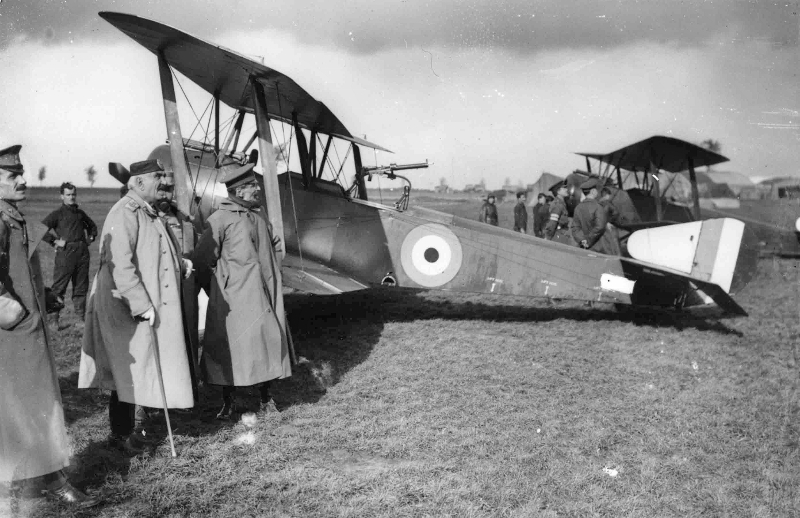
On 31st October the recently exiled King Nicola of Montenegro, a supporter of the now largely overrun Serbia and with his own country conquered by Austria-Hungary, visits Fienvillers and spends time with 45 Squadron.(above) Major Read’s offer to take the King for a flight in one of their “1½ Strutters” is declined.
On 30th October A J Windybank submits his response to the Council’s recent disapproval notice for the 4th extension to the Sopwith factory. On 1st November the Borough Surveyor implies that the issues have been addressed by stating that he will place Windybank’s letter before the next meeting of the Property Committee.
Sopwith factory output in October 1916 is recorded as 37 machines: the second Hispano “Triplane”, 28 “Strutters” (192 so far) and 8 “Pups” (18 so far).
There are no new Clerget “Triplanes” completed this month but volume production is well underway, not just those overdue to the RNAS but also those overdue to the French Centre of Marine Aviation at Dunkirk. They ordered ten on 18th August expecting deliveries at one per week from the end of September priced at £1,000 each, fitted with French free-issue 130hp Clerget engines and delivered without guns.
October 1916 is the first month that more Sopwith aircraft are built by contractors than in their own factory. Best estimates indicate 42 such aircraft built in the month: 2 “Pups” by Beardmore (3 so far) and 3 by Standard Motors (5 so far); 17 “Strutters” by Vickers (26 so far), 9 by Ruston-Proctor (34 so far), 1 by Fairey Aviation (2 so far) and 5 each initial deliveries by Chelsea coachbuilders Hooper and Westland Aircraft in Yeovil, Somerset.
The Vickers and Ruston built RFC “Strutters” are going to Sedgeford and 45 Squadron in France. Fairey Aviation’s A955 is going via Farnborough to France and all but A1511 of the first five Hooper ones, A1511 to 1515, are going in packing cases to the Aircraft Depot at St. Omer also for squadrons in France. The five Westland Admiralty machines are single-seat “Strutter Bombers” going to RNAS 3 Wing at Ochey.
No more Blackburn-built “Baby” floatplanes are recorded to the RNAS since the first three in August and September. Blackburn may be giving priority to the French Centre of Marine Aviation at Dunkirk order for five at £1,400 each which came with the “Triplane” order (above) back in August and were promised for October.
Two of the last ‘Baby’ floatplanes with built by Sopwith in Kingston, N8214 & N8215, are now being evaluated at the Venice Naval Air Station as patterns for potential local licence production by Sopwith’s Bleriot-owned licensee in Italy (below, N8215 in Italy)
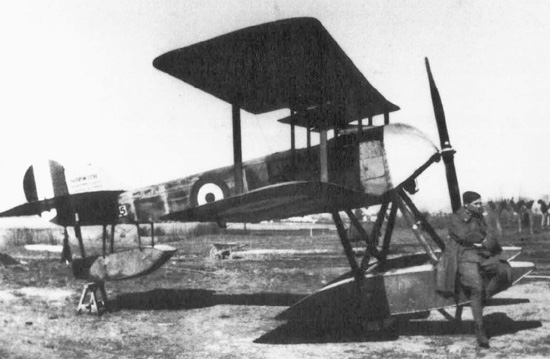
On 1st November on the same day that the first Beardmore built “Pup” 9901 is delivered to Eastchurch by crate, the second Sopwith-built 80hp Clerget-engined “Pup” 9497 which has been at Beardmore for many weeks is flown by their test-pilot A Dunkinfield Jones to RNAS Grain ready for deck-landing experiments.
On 2nd November 8 (Naval) Squadron make their first patrols over the Somme. On 3rd November 1 Wing “Pup” N5185 hits a flare lorry landing in high winds. On 4th their prototype “Pup” 3691 returns from a 6 week rebuild.
In three traumatic weeks over the Somme seven RFC 45 Squadron crew have been killed and two injured. Three pilots have been rejected as not up to scratch and five others are confined to hospital or bed with a bug not helped by their damp living conditions at Fienvillers. On 4th November the surviving Squadron members and their eight surviving “Strutters” are temporarily withdrawn to Boisdinghem west of St Omer to regroup.
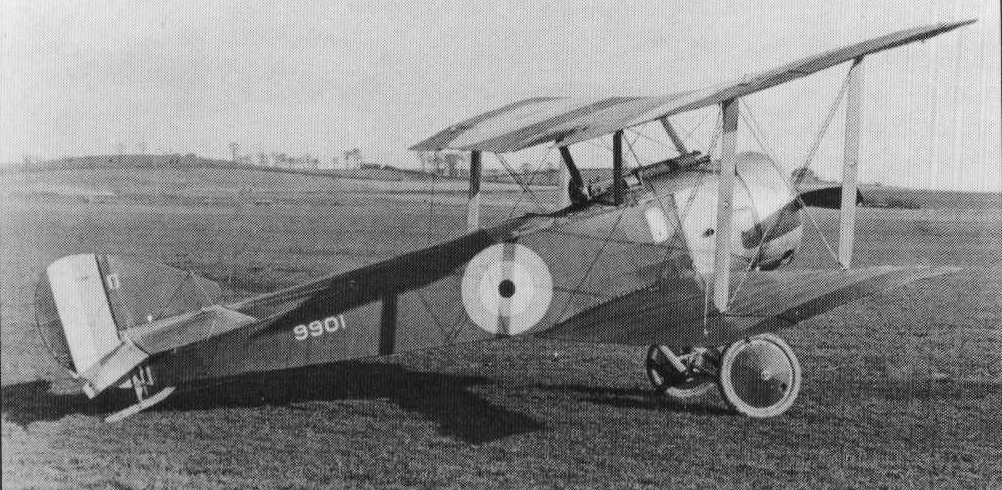
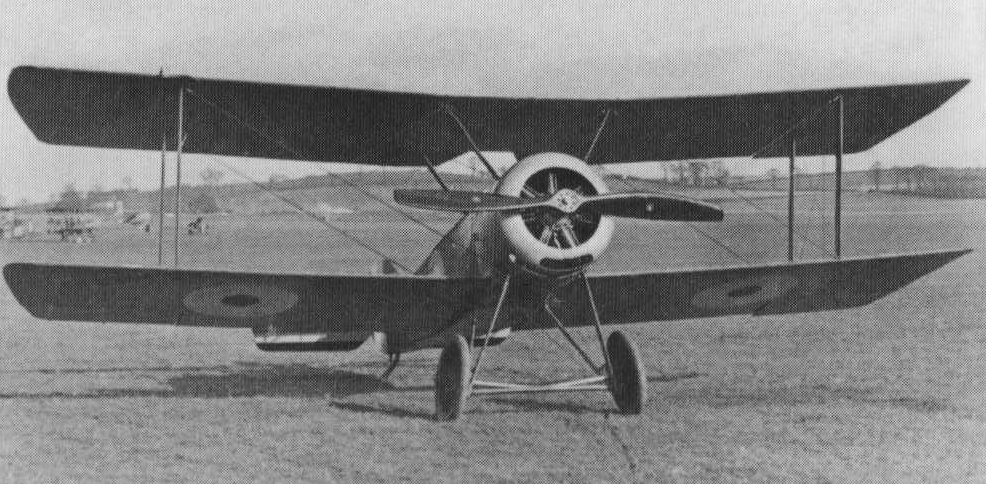
On 6th November the first Beardmore “Pup” 9901 now assembled at Eastchurch (above) is flown by Sqdn Cdr Harry Busteed who notes that it is tail heavy at all speeds, presumably despite the variable-incidence tailplane. It does not carry the Sopwith name on the fin, has tricolour span-wise stripes on the tailplane and underwing roundels inboard of the ailerons. As Sopwith-built “Pup” 9497 has arrived at Grain in this Beardmore paint scheme it seems likely that it was a bare airframe when it was sent to Beardmore as a manufacturing pattern.
Whilst most of the RFC “Pups” from Standard Motors are to go to 54 Squadron, the first A626 is now with 70 Squadron in France, the third A628 has been allotted to the Experimental Station Orfordness for trials but is damaged going up on its nose on arrival on 6th November and the sixth A631 is on its way to the Royal Aircraft Factory at Farnborough to be tested to destruction to confirm its ultimate strength and factors of safety.
On 6th November Fl Lt Dallas in 1 Wing’s prototype Sopwith “Triplane” N500 encounters three enemy two-seaters circling over Westende at 14,000ft apparently practising tactics. He banks around them unobserved, gets behind one and fires but his Vickers gun jams after 40 rounds. Set upon by the others he uses the superior climb of his triplane to go through clouds but nearly collides with another as he emerges and dives back to Dunkirk to sort out his gun. Frozen fabric ammunition belts and faulty ammunition are a constant problem.
On 8th November 45 Squadron in temporary withdrawal at Boisdinghem have ten pilots and ten “Strutters” starting an intensive training programme of formation flying, air-to-ground gunnery, combat, map reading and photography. The newer pilots are doing circuits getting practice in the “crucial art of landing the delicate and sometimes capricious Sopwiths” and are keeping the mechanics busy repairing bent undercarriages and re-rigging strained airframes. Tragedy strikes again. 2nd Lts Lowe and Jordan are killed 2 miles east of the airfield in 7783 when attempting a forced landing after an engine failure. Their funeral is in St Omer the following day.
On 8th November Sopwith’s first production “Triplane” N5420 is flown via Dover to St Omer and on 9th November joins RNAS 1 Wing at Furnes alongside Fl Sub Lt Dallas’ prototype N500. Now to be called 1(Naval) Squadron, 1 Wing has lost all its Sopwith “Pups” to the volunteers in 8(Naval) Squadron on the Somme.
On 10th November 8(Naval) Sqdn Fl Sub Lt Galbraith in “Pup” N5193 claims a Roland sent out of control over Bapaume and another’s observer hit. Fl Sub Lt Stanley also in a “Pup” forces a scout to land. After a week with RFC 70 Squadron, Standard Motors’ first “Pup” A626 becomes the only RFC-owned aircraft attached to 8 (Naval) Squadron supporting the RFC over the Somme.
Meanwhile 5 Wing “Strutters” are involved in dropping 138 bombs on destroyers and barges in Ostend docks whilst Canadian Fl Sub Lt Chadwick, who has been hidden by Belgian locals since he forced landed his damaged “Strutter” behind the lines on 2nd October, finally escapes back across the border disguised as a nun.
Also on 10th November RFC 70 Squadron “Strutters” are out on Observation Patrols. A385 is shot up and forced to land out with observer 2nd Lt Macrae killed in action. A885 is shot down, breaking up and crashing east of the lines killing both 2nd Lt Allport and Lt Bennett.
In South East France on 10th November the weather has cleared enough for nine 3 Wing “Strutter Bombers” from Ochey to follow a night time French raid on the Volklingen Iron Foundry and blast furnaces in the Saar Valley. They meet much AA fire which perforates the wings of an escorting two-seat “Strutter” and injures an observer slicing through his helmet. Fl Cmdr Draper and Sub Lt Pearkes in “Strutter” 9407 claim a Fokker D shot down on the way to the target and a two-seater sent out of control on their homeward journey. Fl Sub Lt Harrower gets lost in cloud. Trying to recognise landmarks he keeps on going south west to be sure he is over friendly territory and lands in a field in Central France near Moulins, three times as far as he needed.
On 11th November nine 3 Wing “Strutter bombers” with seven two-seaters are bombing the same target but from 9,00ft as the visibility except straight down is too poor at the usual 6,000ft. (below 3 Wing “Strutter bomber” 9741 on tail stand probably for gun testing)
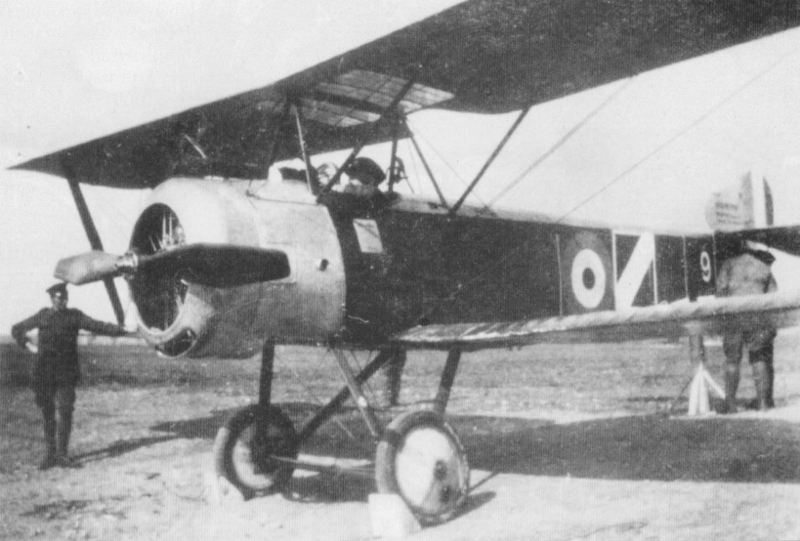
12th November is the third consecutive day 3 Wing “Strutters” are bombing, this time St Ingbert. They meet AA fire held back until after the bombing but no enemy aircraft, a good thing as their 110hp Clerget engines have become prematurely worn. All their engines are now to be overhauled allowing the ‘veteran’ crews some leave. The Canadians with over a year’s active service are to get two months in Canada. This week 3 Wing have loaned six more “Strutter Bombers” to the French without engines, 9673, 9895, N5097, N5101, 103 & 125. The French claim that their engines perform better than those built under licence in Britain.
Sopwith Aviation receives an order for fifty more “Strutter bombers” to follow straight on from existing orders.
On 12th November Fl Sub Lt Malet flying Sopwith “Baby” floatplane 8181 from Dunkirk harbour crashes into the sea and is killed. It is suspected that one of his own bullets hit the propeller.
Meanwhile Ft Sub Lt Keeble in “Pup” N5189 which arrived with the newly renamed 3(Naval) Squadron at Dunkirk two days ago, chases an enemy seaplane but is forced by an engine failure to land in the sea. He is picked up by the French patrol boat Capricorn and towed into Calais.
On 13th November RFC 28 Squadron “Strutter” 7797 is wrecked and 2nd Lt Gleed injured when he hits a hedge after landing too fast in fog at Castle Bromwich.
On 14th November prototype “Triplane” N504 is flown by Sq Cdr Busteed from Eastchurch to Dunkirk ready to go on to 1(Naval) Squadron to help replace their “Pups”.
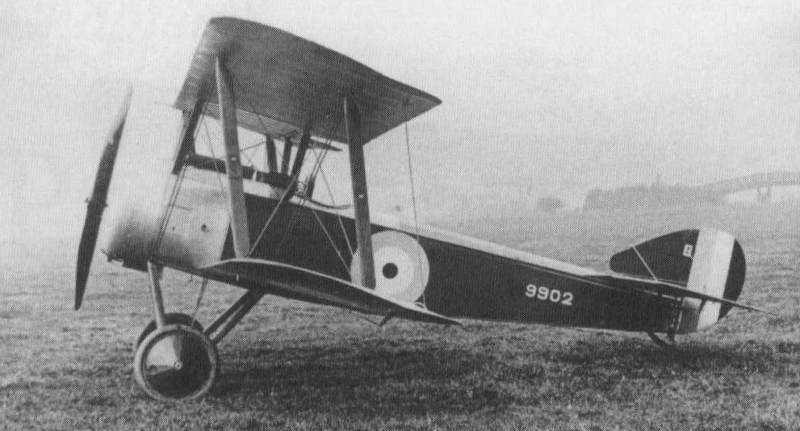
After its first flight 20 days ago and official acceptance by the RNAS on 8th November the second Beardmore-built “Pup” 9902 (above) arrives on 14th November at its operational destination RNAS training base at Cranwell.
Sopwith are no longer involved in the development of their “Baby” floatplanes but Blackburn and others are. The Port Victoria Marine Experimental Aircraft Depot at Grain have fitted Sopwith “Baby” 8134 floatplane with a set of high lift wings of their own experimental design. These have the same area as normal Baby wings but are longer and narrower with heavily cambered aerofoils based on wind-tunnel work by the National Physical Laboratory at Teddington. The wings are also more heavily staggered to give the pilot a better view. Rapidly produced, the wings are 300lb heavier. (some say 450lb) The level speed is reduced by some 20mph to 77mph but the aircraft achieves the expected improvement in climbing performance and has flown up to 8,000ft.
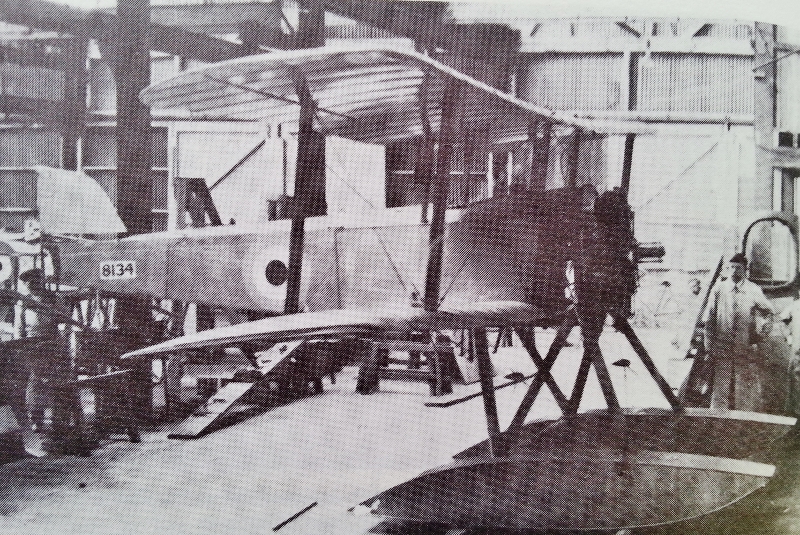
Meanwhile Sopwith-built “Baby” floatplane 8134 which has been back at Fairey Aviation for repair since 23rd October is being rebuilt (above) with a set of their experimental “camber gear” wings. The entire trailing edge of each wing is hinged from the main spar and lowered by a handwheel in the cockpit. A differential device allows these ‘flaps’ to be actuated as ailerons for lateral control. The increased lift at low speeds is intended to help the floatplane get ‘on top of the water’ which in some conditions presently requires even more power than is needed to get airborne. Fairey Aviation also now has Sopwith built RNAS “Baby” 8193 “for a deck flying-off conversion”.
On 15th November Sir Douglas Haig finally gets approval from the War Office to expand the number of RFC Squadrons in France by twenty to fifty-six. This requires many more aircraft and adds another 13,500 men to the RFC’s shortfall of 10,200 trained men for the existing 86 service squadrons and 60 reserve squadrons.
Standard Motors receive an order for 50 more Sopwith “Pups” for the Royal Flying Corps making 100 so far.
After earlier raids on 10th and 12th November, on 15th November 5 Wing “Strutters” are amongst those bombing Ostend marine workshops and this time the Electric Power Station although that is not hit.
Since 24th June RNAS Dunkirk has had four Sopwith ”Baby” floatplanes from HMS Vindex on strength mainly to patrol off the Belgian coast whilst the RNAS continue those bombing raids on the Belgian ports. The French have lent the RNAS some homing pigeons to use for messages when no other communication is available.
On 16th November Fl Sub Lt Graham in “Baby” 8138 is forced down onto the sea by engine trouble. A float springs a leak landing in heavy waves and the aircraft turns upside down. Graham releases his nearly drowned homing pigeon but it does not reach the loft. Over four hours later a searching Short floatplane spots the pilot on an upturned float and lands making many unsuccessful attempts to collect him until he goes out of sight in the broken water. Taking off again the Short finds him and lands close enough to pick him up utterly exhausted but could not then take off with the extra weight. The Short pilot sends his pigeon with the message “12 miles NE Nieuport taxying NW”. The pigeon arrives in Dunkirk an hour later and a French torpedo boat is sent out to locate them and bring them back. (Photo shows a “Baby” pilot releasing his pigeon)
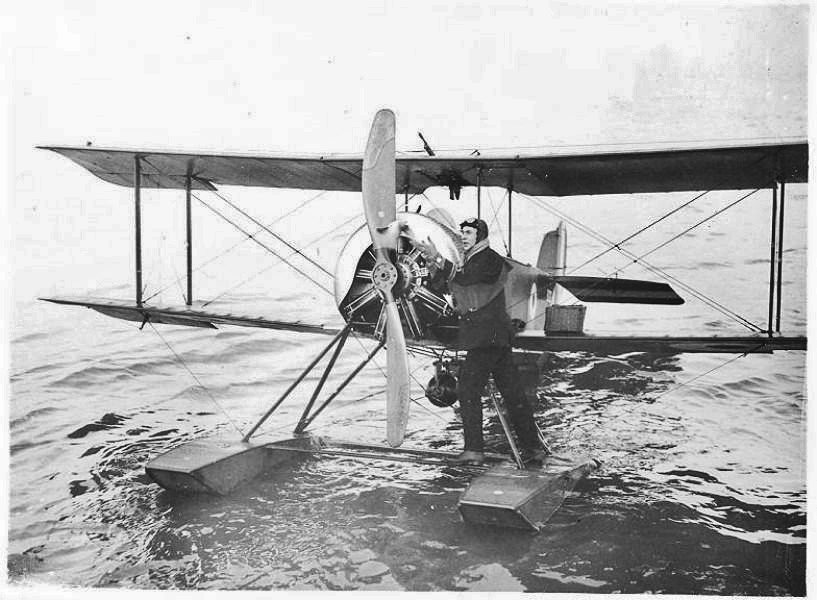
On 16th November 70 Squadron “Strutter” A2432 is shot down, Sgt Evans and 2nd Lt Struben are killed in action whilst 70 Squadron “Strutter” A1907 is hit by anti-aircraft shell shrapnel and forced lands near Crois Contes.
On 16th November Fl Sub Lts Galbraith and Goble in 8(Naval) Squadron “Pups” N5193 and N5194 each shoot down an LVG two-seater and on 17th November Goble downs another. The two-seat “Strutter” fighter flight of 8(Naval) Squadron at Vert Galand has now been re-equipped with “Pups”. Meanwhile at Furnes east of Dunkirk another new Sopwith “Triplane” N5422 has joined the two already with 1(Naval) Squadron.
In July the French replaced the 110hp Clerget in a borrowed Sopwith “Strutter” with a 130hp unit and reported speeds up to 97mph and a climb to 10,000ft in 19 minutes. Sopwith are delivering a few “Strutters” with 130hp Clergets including N5114 this week to the Design Flight at RNAS Eastchurch. Their report of its test flights on 16th and 17th November shows similar speeds to the French, slightly faster climb rates and general approval of the machine. The only complaint is that “there is a slot in the whole width of the floor just ahead of the observer which makes his seat both cramped and uncomfortable. A 3-ply fitting for a Ranken Dart Dropper is across the slot on the port side and it is apparently intended to fit a camera in the remaining space”.
The two-gun firepower of the latest German fighters demands some new thinking. In September the Admiralty ordered an extra six Sopwith “Triplanes” from Clayton and Shuttleworth with twin forward-firing machine guns but they are some way off. The Admiralty have also ordered an up-rated 110hp Clerget “Pup” N503, initially on Beardmore but now Sopwith can take advantage of the latest 130hp Clerget rotary engines.
In Sopwith’s Experimental Drawing Office Reg Ashfield has been working on ideas for the upgraded “Pup” with much input from Chief Designer Herbert Smith, Tommy Sopwith, Harry Hawker and Fred Sigrist. Sigrist has asked for a parallel chord continuous top wing to simplify manufacture and “turn them out by the mile”. Ashfield’s latest drawings incorporate that top wing, a 130hp Clerget engine and twin machine guns. The design has clearly evolved from the successful 80hp “Pup” but despite the 60% extra power it is more compact to enhance manoeuvrability. The rear fuselage is 8 inches shorter and the pilot is further forward closer to the centre of gravity. It has a smaller tailplane, as already recommended by Harry Hawker for the “Triplane” to make that more agile, and slightly longer narrower chord wings which should improve climb rates, also from experience with the “Triplane”. The general arrangement drawings have now been approved by Herbert Smith, detailed design is well underway and a prototype of this new Sopwith “F1” fighting scout is to be built over the next few weeks in the Skating Rink Experimental Shop in Kingston.
Again on 17th November RNAS Sopwith “Strutters” are amongst twenty aircraft bombing Ostend marine workshops and failing to hit the Electric Power Station. This time they meet even heavier anti-aircraft fire.
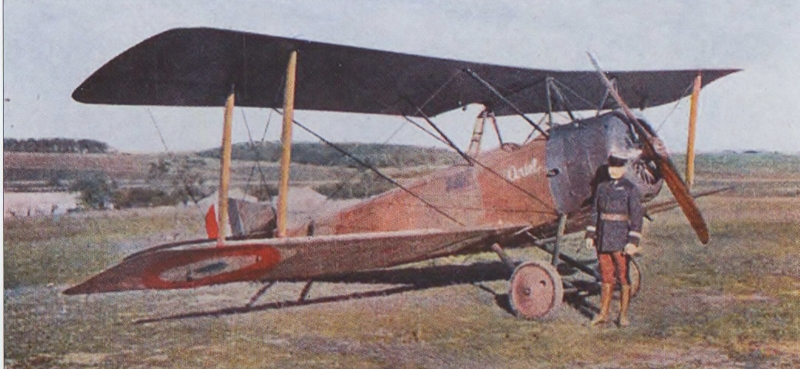
On 17th November in another spectacular long distance raid Capitaine L R de Beauchamp of the 4me Groupe de Bombardement takes off from Luxeuil at 8am “dressed like an eskimo” in his specially prepared camouflaged “Strutter” Ariel (above) and flies 350kms to spiral down and drop bombs on Munich railway station at midday before flying at 12,000ft across the Brenner Pass and over the Dolomites to Venice but cannot find the French airbase there. Short of fuel after a 6hour 45minute flight of more than 650kms, he lands in a field but hits a hole and breaks the undercarriage slithering to a halt in the mud. (below) His feat is widely celebrated, makes the headlines in newspapers and causes dismay in Germany.
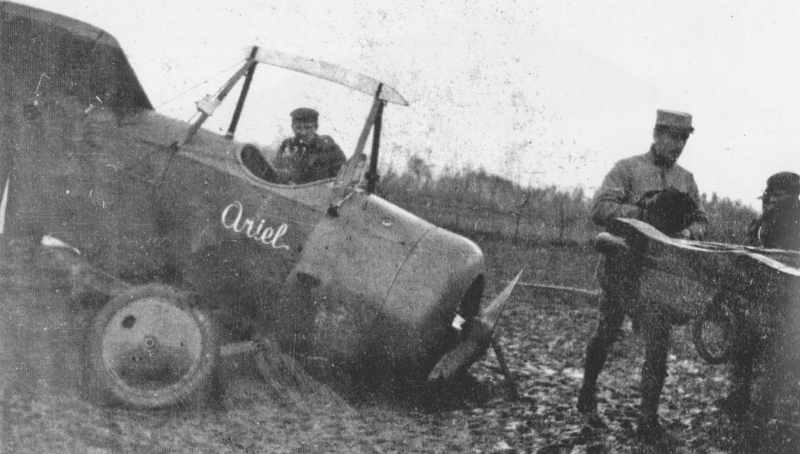
The French now have orders for hundreds of Sopwith “Strutters” on seven different local manufacturers with 135hp or 145hp Clerget engines or 135hp Le Rhônes. They are using logical designations Sop 1A2, Sop 1B1 and Sop 1B2 for the three variants, A or B for Artillery or Bombardment and 1 or 2 for the number of seats.
On 18th November in the last of the Somme attacks the limited objectives are largely met and a thaw sets in changing the battlefield back to a sea of mud “ending the greatest continuous battle the world has yet seen”. It has achieved some wider objectives – keeping the main German forces pinned to the Western front whilst our allies fight hard on other fronts removing the tension at Verdun and allowing the French to sweep the German armies back almost to where they were in February and dealing a blow to the morale of enemy troops. The Germans acknowledge that relentless artillery and the RFC work have played very significant roles in this.
On 19th November the fourth Beardmore “Pup” N9904 is accepted to be delivered to Great Yarmouth.
On 20th November two Hooper-built RFC Strutters A1512 & A1513 are deleted in France as wrecked, with 14hours 40mins and 35hours 40mins flying time respectively. The “wrecks” are transferred to RNAS Dunkirk.
On 20th November ten days after Fl Sub Lt Harrower got lost returning from a “Strutter” bombing mission and landed in a field in Central France, a truck arrives with fuel and a mechanic in answer to his telegram. Flying back he has an engine failure and in the forced landing hits a startled horse killing it and wrecking the machine.
On 21st November two enemy aircraft try to bomb the RNAS airship shed at Mudros. Splinters damage the ant-submarine Blimp SS8. Fl Sub Lt Brandon in Sopwith “Schneider” floatplane 3783 recently allotted to airship protection pursues and forces down the Friedrichshafen floatplane which is destroyed by shelling from a ship.
A week ago the Admiralty Air Department, referring to an event at Eastchurch on 1st November, enquired if RNAS Dunkirk had experience of the celluloid window in the top plane of their Sopwith “Pups” bursting while the machine is in the air. The response on 21st November from 1 Wing via Headquarters Dover Command confirms that they had this problem with an aircraft with entire centre section covered with celluloid but not with the 80hp Gnome machines “with celluloid only between the main spars where it is more securely fixed”. (The different clear celluloid applications can be seen in the two photographs below)
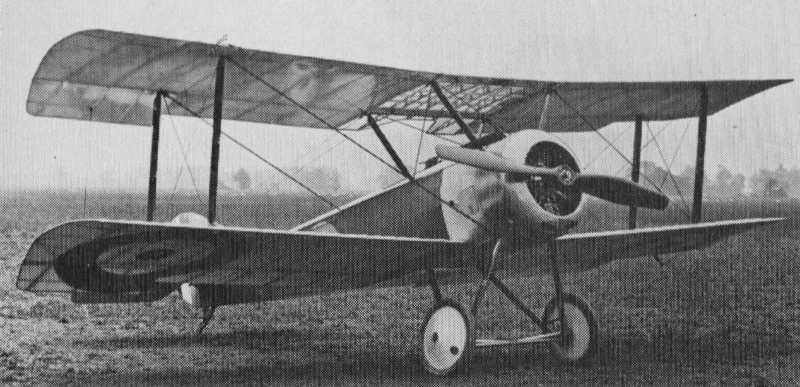
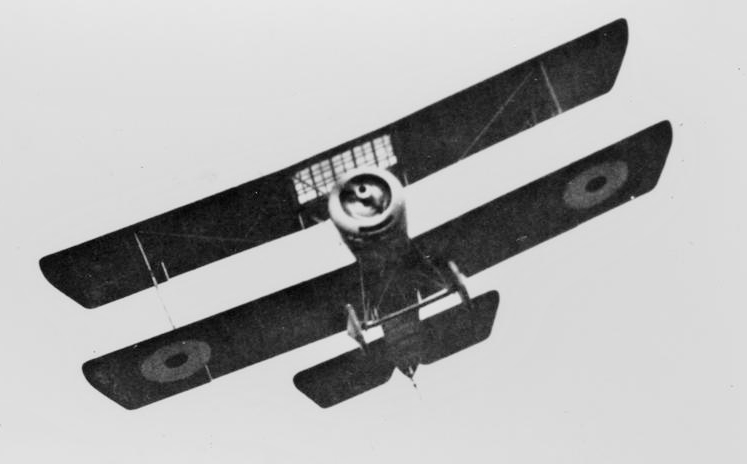
On 29th November 21-year-old Basil George Watson flies his newly completed homebuilt copy of Harry Hawker’s “SLTBP” runabout over 90 miles from Point Cook to his home town of Bendigo where fire bells are rung to announce his imminent arrival at Epsom Racecourse. On the longest flight so far in Australia he had been flipped upside down by strong air currents over Mount Macedon but at 6,000ft had been able to recover. Since returning to Australia last June after going to work for Sopwith Aviation in England in April 1914, he has used mostly local materials and some local craftsmen to build the machine at his parent’s home, now in Brighton, Victoria.(below left) He acquired the 50hp Gnome engine from Horace ‘Horrie’ Miller another ex-Sopwith Australian who used it in his own briefly flown homebuilt aircraft.

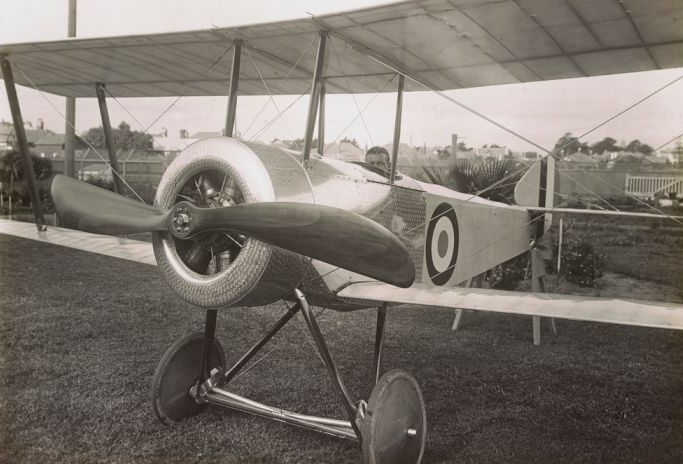
Photographed in the garden (above right) Watson’s machine is beautifully finished including a spot-burnished circular cowling, a Tasmanian walnut propeller and patriotic British military markings. Although he has not been allowed to enlist for the Australian Flying Corps due to the injuries he sustained in a flying accident at Brooklands in June 1915, he has had official permission to test fly his aircraft at Albert Park during November and is now venturing further afield.
Sopwith have been building four more of these 50hp “SLTBP Sparrows” during 1916. It is possible that much of the work was done before Basil left England in which case he may have witnessed that and obtained some parts which might be difficult to source or manufacture in Australia. Sopwith’s four new “Sparrows” are apparently stored engineless at Brooklands, possibly an unsuccessful attempt by Sopwith to supply small aircraft to the top-secret Aerial Target (AT) Project, a title which deliberately hides its true purpose of developing radio-controlled unmanned flying bombs. Sopwith previously built a rudimentary even smaller un-manned biplane for that project but it was damaged and abandoned before it was flown. (below, damaged with mock 4-wheel undercarriage)
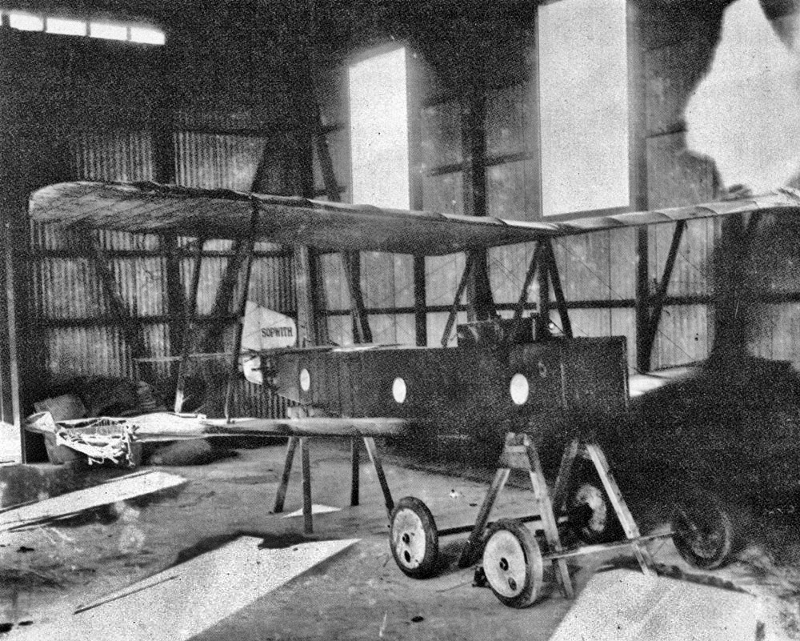
There is a further setback to getting Blackburn built “Baby” floatplanes into service on 30th November when their second machine N1011 crashes en route to Dover. At Dunkirk, 3(Naval) Squadron is re-building its “Pup” force with the arrival of 9898, N5185, 87, 88, 95, 98 & 99. At Luxeuil three more RNAS 3 Wing “Strutters” N5118, N5127 & N5131 are loaned to the French bombardment group, two without engines.
Sopwith’s eleventh “Triplane” for the RNAS N5430 has been diverted to Martlesham Heath for formal evaluation by the Royal Flying Corps who are apparently about to order two hundred and six 130hp Clerget “Triplanes” A9000 to A9099 & A9813 to A9918 from Clayton and Shuttleworth. New to aircraft manufacture they are only just about to complete their first “Triplane” against their existing Admiralty orders for forty-six.
Sopwith Works Record Cards show a factory output of 36 aircraft in November: 19 “Strutters”, 6 “Pups” and 11 “Triplanes”, bringing their totals to 204, 25 and 16 respectively.
Beardmore have delivered 3 RNAS “Pups” this month whilst Standard Motors have delivered 10 to RFC 54 Sqdn at Castle Bromwich. Expecting more in December, this first RFC “Pup” Squadron is working up to go to France.
Production of RFC “Strutters” by Vickers at Crayford is well organised and they have produced 21 this month. Recent ones have been going to the Training Brigade at the Central Flying School at Upavon including A1090 (below) with duplicate instruments and controls in the rear cockpit for the instructor.

Elsewhere this month Ruston Proctor have built another 14 RFC “Strutters” at Lincoln, although “Strutter” 7795 has been crashed before ever reaching its Squadron. Fairey Aviation have built 9 RFC “Strutters” and Westland Aircraft another 8 “Strutter bombers” for the RNAS. For the first time more than one hundred Sopwith designed aircraft have been built in a single month.
On 1st December Sopwith receive an order for two “FS1 Baby (improved) tractor biplane seaplanes”. The clue is the “F1”. N4 and N5 are to be naval seaplane versions of Sopwith’s 130hp “F1” two-gun fighter project.
On 2nd December the first Clayton & Shuttleworth built “Triplane” N5350 is delivered to the No.4 Aircraft Acceptance Park at Lincoln.(below)
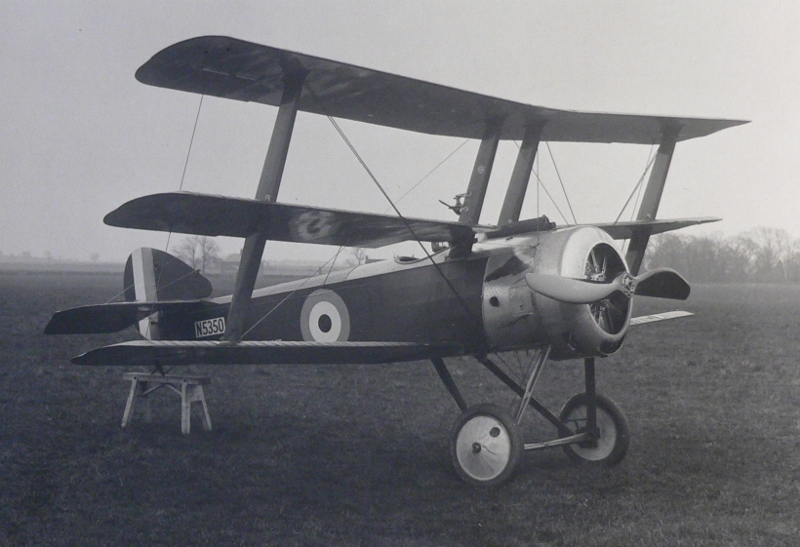
On 4th December Sopwith-built “Triplane” N5424 forced lands in fog but the next day joins RNAS Manston’s War Flight as a fast-climbing high-altitude addition to the Home Defence force.
On 4th December Australian’s Little and Simpson in 8(Naval) Sqdn “Pups” N5182 & N5194 each send one of the latest enemy fighters ‘out of control’, a Halberstadt DII and an Albatross DI.
RFC 70 Squadron “Strutter” 5719 is crashed for the fourth time on a practice flight whilst, in England, 2nd Lt Startin is injured in RFC 54 Squadron “Pup” A643 when he stalls whilst banking and nose dives to the ground.
On 5th December Blackburn’s first “Baby” N1010 finally joins the RNAS in the Seaplane Design Flight at Grain and Grain based “Baby” 8123 now moves to their Gunnery School. Over the last few days four more of the Sopwith-built “Baby” floatplanes delivered to the RNAS Central Stores Depot at White City seven months ago probably without engines have entered service. 8210 to 8213 are now at the Seaplane Flying School, Calshot.
On 6th December RFC 45 Squadron and their “Strutters” make their first eleven sorties over the Ypres front having moved to their new base at St Marie-Cappel 15 miles east of St Omer two days ago from a month’s rest, replenishment and intensive training. The airfield is 400 yards square with proper hangars and huts, a great improvement on their primitive tented facilities at Fienvillers. A captain from 11 Wing headquarters comes to swing their compasses and he finds one 30ᴼ out. The response from the pilot is “Thank God I never use it”. New “Strutter”A1084 suffers a forced landing on its delivery flight to 45 Squadron from St Omer.
On 4th & 6th December two more Sopwith-built French “Triplanes” are delivered to Dover from Brooklands. Sopwith have mistakenly applied large identity numbers 2 & 4 to match their factory build numbers F2 & F4. (F4 below note tiny “F4” on the fin). The Centre d’Aviation Maritime (CAM) at St Pol already has Nieuport 17 fighters numbers SP2 and SP4 similarly marked 2 & 4.
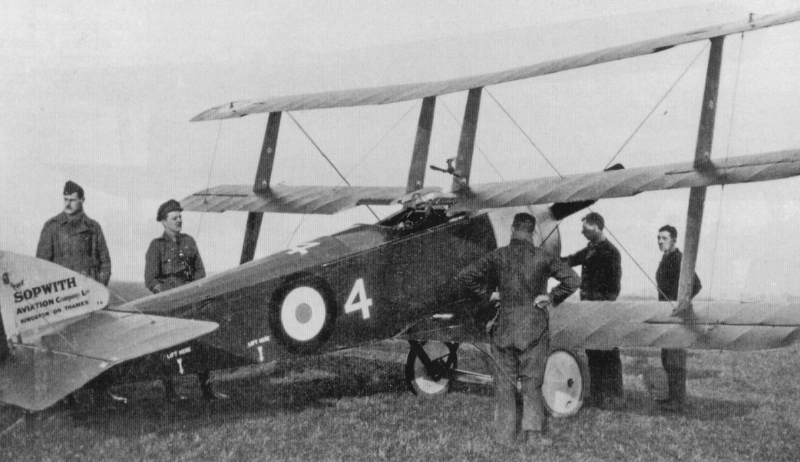
By 7th December the first Clayton & Shuttleworth “Triplane” N5350 is at Chingford already needing repairs before it can go to the Design Flight at Eastchurch.
By 7th December N5501 to 03, the first three of 50 “Strutter bombers” only ordered four weeks ago, have been accepted at the Sopwith works ready to go to 3 Wing at Luxeuil. An order for a further 15 has been cancelled.
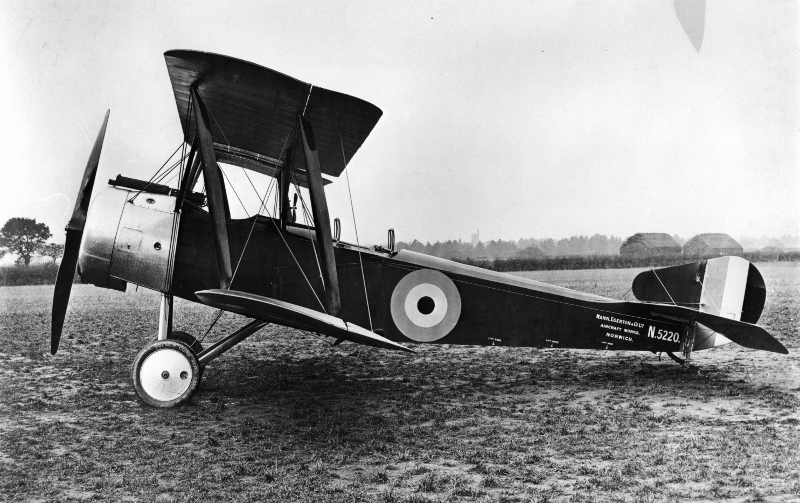
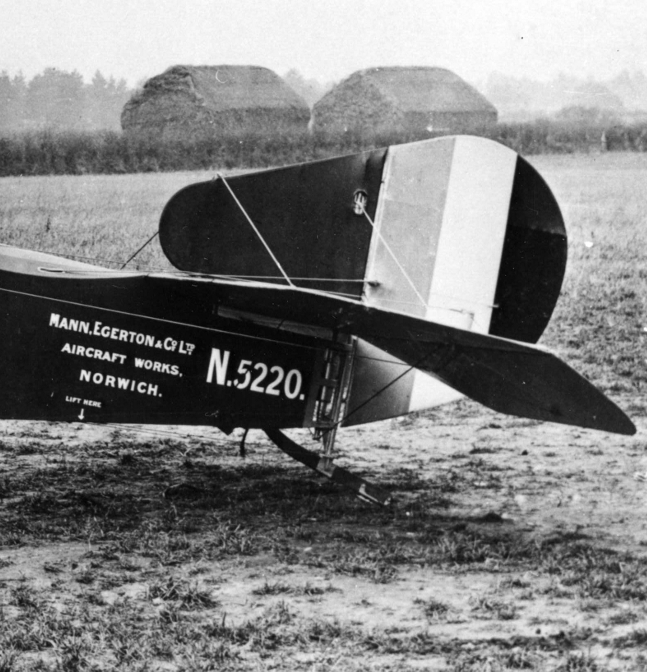
On 7th December the first Mann Egerton built “Strutter” N5520 (above) is delivered by rail from Norwich to the RNAS Design Flight at Eastchurch. On 8th December two more arrive at Dover for erection. Previously motor engineers and coachbuilders, they have orders for 50 two-seat “Strutter” fighters and 25 “Strutter Bombers”.
On 8th December following the 28th November 8(Naval) Squadron report on their Sopwith “Pups”, the Admiralty Air Department notifies RNAS Dunkirk that “ arrangements have been made to strengthen centre section struts on 80hp Sopwith machines and to send spare struts for all aircraft that have been delivered”. Sopwith apparently also agree with the squadron’s judgement that “no advantage appears to derive from the adjustable tailplane”, as new “Pup” production is being switched to a simpler fixed tailplane.
Engine supplies are a major problem in the plan to fully equip 8(Naval) Squadropn with “Pups” by the end of December. The RNAS depot at Dunkirk is now overhauling 80hp Le Rhônes from crashed RNAS Nieuports and sending them to Dover to be fitted to new “Pup” airframes delivered engineless from Kingston.
On 10th December at Vert Galand Fl Sub Lt S V Trapp is killed when the wings collapse on 8(Naval) Squadron “Pup” N5192 as he pulls out of a dive on a test flight.
“A” Flight of the RNAS eastern Mediterranean 2 Wing is now based on the Greek island of Thasos just off the enemy held coast of Macedonia. On 10th December a “Schneider” floatplane from Thasos chases an enemy seaplane back to its base at Gereviz. The next day a Schneider and a Farman drop some bombs on that base.
On 11th December Fl Lt Goble in 8(Naval) Squadron “Pup” N5196 claims another enemy biplane sent down out of control whilst RFC 45 Squadron “Strutter” 7790 is written off in a misjudged landing returning from a reconnaissance mission, RFC 70 Squadron “Strutter” A1904 is ‘wrecked on a travelling flight’ and RNAS Sopwith “Baby” floatplane 8126 is wrecked hitting a ship’s mainsail at Dunkirk.
On 11th December French pilots fly the first three French “Triplanes” from Dover to St Pol where the Centre d’Aviation Maritime shares responsibility with the RNAS for aerial cover of the strategic naval base at Dunkirk.
On 7th December after five months as Secretary of State for War Mr Lloyd George with a coalition government succeeded Mr Asquith as Prime Minister. In place of the larger War Committee he formed a five member War Cabinet including Leader of the House of Lords and President of the Air Board Lord Curzon. On 11th December Major-General Trenchard attends Curzon’s Air Board meeting to emphasise that he is now in a position where it is obligatory for the army to obtain everything the navy could afford to lend, making it clear that there is no possibility of meeting the urgent need for 20 extra fighting squadrons from the RFC’s resources and stock should be taken of all material being produced for both air services over the next few months. He asked for four complete naval squadrons plus 100 Rolls Royce and 50 Hispano engines from the Navy to equip six further squadrons: two each of DH4s, Bristol Fighters and SPADs.
On 12th December the Army Council approve a further expansion of the RFC by 20 service squadrons and 35 training (reserve) squadrons to 106 service squadrons and 95 reserve squadrons but all these plans to expand the RFC are too late to provide the air power Trenchard says he needs in France in the next few months. Lord Curzon decides to explain the urgent situation on the western front at Lloyd George’s next War Cabinet to call attention to the problems of air policy and supply and to seek wider powers for his Air Board which has been struggling to have any control over the very significant aviation procurement activities of the Admiralty. Meanwhile the Air Board has put Trenchard’s request for naval squadrons and engines before the Admiralty ‘at this moment of great need’.
At Eastchurch since 11th December, Sopwith’s fourth Clerget “Triplane” N5423 fitted with an experimental set of 3ft 6in chord (3in broader) wings has demonstrated no appreciable improvement in performance.
Blackburn have received an Admiralty order for 30 more “Baby” floatplanes making 71 in total. They also have the French order for 5. Standard Motors have received a third RFC order for Sopwith “Pups”, this one for 150 brings their total to 250.
On 15th December two Beardmore-built 80hp Clerget “Pups” 9904 & 9905 fitted with rocket rails and equipment for flying off ships’ decks are accepted at Great Yarmouth to take over some of the anti-Zeppelin patrol and interception work from their older landplanes and “Baby” floatplanes. Yarmouth is a very active naval home defence air station as is Manston which now has unmodified 80hp Clerget Beardmore “Pup” 9906.
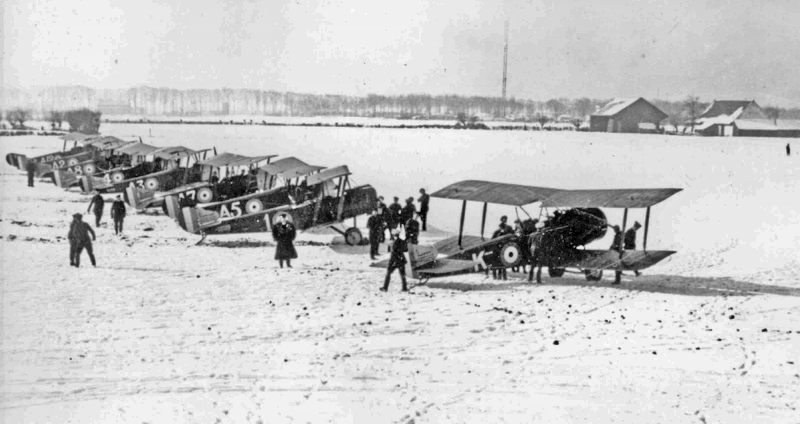

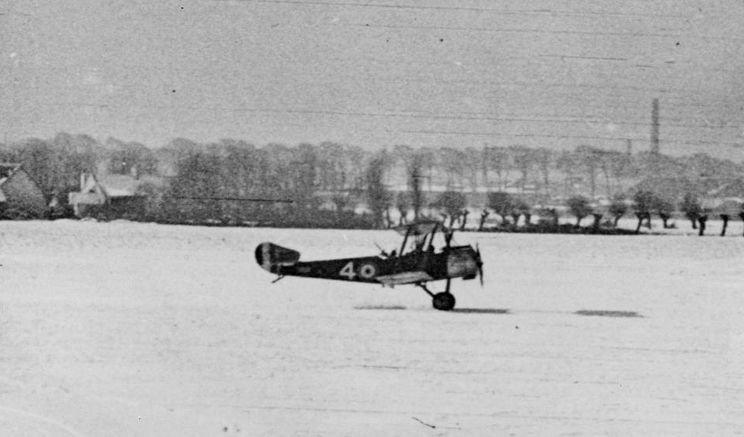 At Coudekerque they have seen the first snow but it does not stop RNAS 5 Wing “Strutters” going on patrol in the winter sun. (above & right)
At Coudekerque they have seen the first snow but it does not stop RNAS 5 Wing “Strutters” going on patrol in the winter sun. (above & right)
By 16th December three more Westland-built “Strutter bombers” N5129, N5133 & N5134 have been loaned to the French at Luxeuil but all without engines.
On 16th December RFC 45 Squadron receive four more “Strutters” at St Marie-Cappel to make a full complement of 18 but they still only have 16 pilots and 12 observers.
On 19th and 20th December 45 Squadron fly successful reconnaissance missions, the latter with nine aircraft.
RFC No.2 Aircraft Depot at Candas behind the Western Front have substituted a 130hp Clerget engine for the 110hp Clerget in a Sopwith “Strutter”. Tested on 20th December it climbs to 10,000ft in under 17 minutes.
The 20th December is a record day for the “Pup” pilots of 8(Naval) Squadron over the Somme. Little, Hervey and Todd in N5182, 84 & 93 each send down an enemy biplane whilst Soar in N5180 and later N5181 gets two.
There may be some further adjustments to the Sopwith Aviation Co Ltd accounts for the financial year to 30th September 1916 before the January Annual General Meeting but the ledgers are revealing continued rapid business growth and high profits. The value of sales of aircraft and parts indicate a further remarkable year on year increase of 80%. With the addition of other income, mostly from War Loans and other investment of previous profits, the total company income is likely to be around £450,000. Design/Drawing Office salaries, bonuses and expenses were 2.4 times the previous year reflecting the cost of introducing so many new designs and technically supporting Sopwith aircraft manufacture at other companies. There were also large increases in Income Tax payments, depreciation and general expenses plus even higher percentage commission payments to Thomas Sopwith’s two key operational managers, General Manager Reg Cary and Works Manager Fred Sigrist, for achieving the continued rapid growth of the business. Reg Cary’s income with commission now approaches the ‘Captain of Industry’ salary being taken by Thomas Sopwith himself with Fred Sigrist’s about half that. Sopwith’s contribution to the local economy is significant with over £100,000 paid in wages and salaries to the workforce probably now approaching 700, and over £30,000 paid for sub-contracted work, much of it local.
It seems that company profit will still be over 30% of income despite the significantly higher expenses. The amount of that profit which will be subject to the Inland Revenue’s 60% Excess Profit Tax cannot be calculated from these figures. For a company like Sopwith without a full pre-war year trading profit comparison, it will probably be applied to profit greater than 9% of the capital employed in earning the profits. Whatever the calculation there should be more than enough retained profit to continue to self-finance the growth of the business including extra buildings, plant and equipment, and to pay Thomas Sopwith’s and his sister May’s 6½% dividends on the 26,000 company shares.
On 22nd December the unnumbered prototype Sopwith “F1” is passed by the Experimental Department. If everything goes to plan with the ground testing at Brooklands it could be flying before Christmas Day and certainly before the end of the year. With news of the remarkable achievements of their 80hp Sopwith “Pups” in combat in France there must be hopes in the Sopwith team that this more compact biplane fighter with 110 or 130hp and twin machine guns will prove an even greater success.
In a surprising move on 22nd December the Admiralty order twenty 100hp “Daily Mail” two-seater tractor N1340 to 59 from Sopwith presumably similar to the twelve “Type 807” folder floatplanes bought two years ago but this time with Le Rhône engines. That same day they order 25 Sopwith “Triplanes” N5910 to 34 from Oakley Ltd of Ilford in Essex, cancelling an order for 25 Sopwith ”Strutters” with the same numbers. Oakley has previously only done light foundry work, installation of Curtiss engines in BE2Cs and repairs.
The uncoordinated rapid development and zeal for aviation in both services has led to a bewildering situation with 9,400 aircraft on order of 76 different kinds and 20,000 engines of nearly 60 varieties, many as yet unproven. On 22nd December Lloyd George’s War Cabinet decides the powers of the previously toothless Air Board shall be widened to decide “the proper allocation of the aerial resources of the country whenever conflict of competition arises between the Admiralty and War Office”. A Fifth Sea Lord will be added to the Board with the status and authority of the Army’s Director General of Military Aeronautics. There is also to be a representative of the Ministry of Munitions who are to control and co-ordinate the supply of materials, aircraft and engine production and inspection during manufacture. Air Board President Lord Cowdray becomes the Minister of this new Government Department.
Meanwhile the Air Board’s request for naval support for the RFC has been considered by the Admiralty. Despite imposing considerable reductions in their naval air stations at home and their bombing forces, the Admiralty agree to place four additional squadrons at the disposal of the Royal Flying Corp early in 1917, plus 55 Rolls Royce engines and sixty complete SPAD aeroplanes from their contract for 120.
On 22nd December after two months working up and training at Castle Bromwich, the RFC’s first “Pup” Squadron No.54 fly some Standard-built “Pups” to London Colney in preparation for a Channel crossing.
On 23rd December 12 month-old prototype “Strutter” 3686 joins the Observers School Flight at Eastchurch.
On 23rd December three RFC 45 Squadron crews fly “Strutters” to St Omer to ‘test’ a “Triplane”, “Pup” and Nieuport scout. Later preparations for their Christmas festivities are set back when a gale demolishes several hangars. They still go out on patrol on 24th December and have several encounters with enemy machines finally chasing one some 10 miles over the lines firing 300 rounds, at least half of which hit the machine.
Meanwhile on Christmas Eve RFC 54 Squadron’s “Pups” fly across the Channel to St Omer from London Colney and on Boxing Day fly from St Omer to their first operational base at Bertangles joining the 14th Wing of 4th Army Brigade primarily to protect the unit’s observation, photographic and artillery direction aircraft from marauding enemy aircraft.
Sopwith’s sixth production “Triplane” N5425 delivered to Dover two days ago, goes on to St Omer on the 24th December whilst N5427 and N5429 move to 1(Naval) Squadron at Dunkirk. That day Sopwith’s ninth Clerget “Triplane” N5428 is completely wrecked when the engine chokes after take-off. This would have been the sixth “Triplane” to join 1(Naval) Squadron at Dunkirk but there are a further six due to arrive over the next ten days.
Naval Wings are being converted into squadrons more in line with RFC practice. 1 & 2(Naval) Squadrons are forming from 1 Wing whilst 4 & 5(Naval) Squadrons are evolving from 5 Wing. 1 Wing’s cheerful Christmas message (below) has a “Pup” replenishing a Dover patrol airship.

Through November RNAS Grain have been using Sopwith-built “Pup” 9497 for shore based experiments for landings on ships’ decks. They now have a dummy ship’s deck with an experimental system of arrester wires. “Pup” 9497 is back there from Beardmore now fitted with an experimental arrester gear hook and a guard for the propeller. On 24th December it is test flown by Squadron Commander Cave-Brown-Cave.
On Boxing Day the first three of Sopwith’s recent final order for 50 “Strutter bombers” N5501 to 03 arrive with 3 Wing at Luxeuil to start to replace at least 16 already loaned to the 4me Groupe de Bombardement.
The first two Beardmore-built “Pups” with rocket armament 9910 & 9911 are accepted at Dalmuir (below) ready to be packed for transit to Felixstowe.
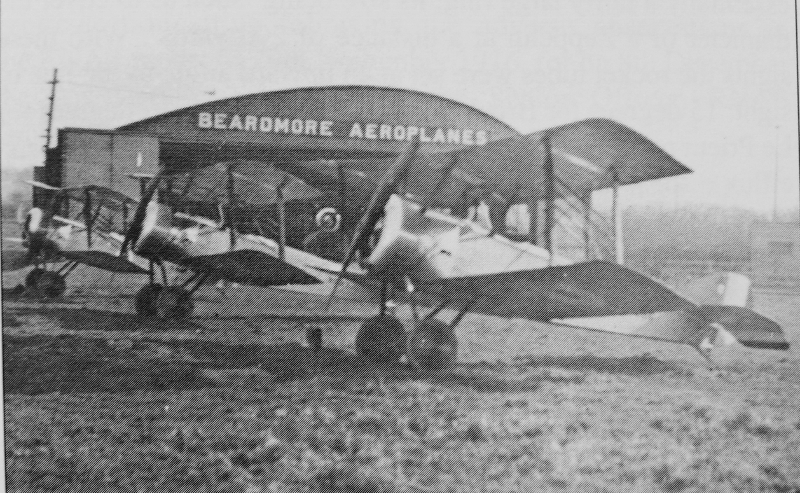
RNAS Gunnery Memorandum No.92 issued 16th December states: “Le Prieur Rockets are generally slow at getting off and do not appear to keep well and should therefore be used for practice. The Brock Immediate Rocket is half the size and weight and leaves very quickly. These should be reserved for actual attack. Present rockets with 20ᴼ elevation carry about 500 yards. Future rockets now in the experimental stage will carry 1,000 yards. It is proposed only to use Brock rockets.”
Also on Boxing Day 8(Naval) Squadron’s Fl Lt Croft in “Pup” A626 engages two hostile machines near Bapaume sending one down and Fl Cmdr Huskisson in N5186 also sends one down in a series of uncontrolled stalls near Ypres. Fl Sub Lt Woods in prototype “Pup” 3691 shares the shooting down of a Halberstadt with Fl Lt Hervey in N5197. The next day Fl Lt MacKensie in N5198 claims the squadron’s sixteenth victory in just eight flying days in December and their twenty-fourth since October, twenty by “Pups”. In that time they have lost two pilots.
On 27 December RNAS 3 Wing make another attack on Dillingen blast furnaces from Ochey. At least one “Strutter bomber” has a Lewis gun fitted on the top wing. His air pump seizes on the way but fuel tank pressure is kept up with a hand pump. With a strong headwind it is 1hr 40mins before they drop to 6,000ft to spot the target between the thick banks of cloud. Anti-aircraft fire is reported as “very good”.
Meanwhile on 27th December Cdr Samson has taken HMS Ben-my-Chree & HMS Raven II to the north east corner of the Mediterranean to make a surprise bombing attack on the strategically important Chicaldere railway bridge 30 miles inland on the Turkish heavy weapon supply route from Constantinople to Baghdad. Whilst some floatplanes draw the ground fire others run in at 400ft, a Short dropping a 65lb bomb on the bridge and two 16lb bombs on the track, but all three fail. Cdr. Samson in veteran “Schneider” 3770 makes a direct hit on the bridge.(below) Two more Shorts make the second direct hit and, in the third wave, a Short, a “Schneider” 3778 and a “Baby” cause more damage. The bridge will take at least a week to repair. Samson is keen to risk returning the next day but the command is satisfied with the results and orders a return to Port Said.
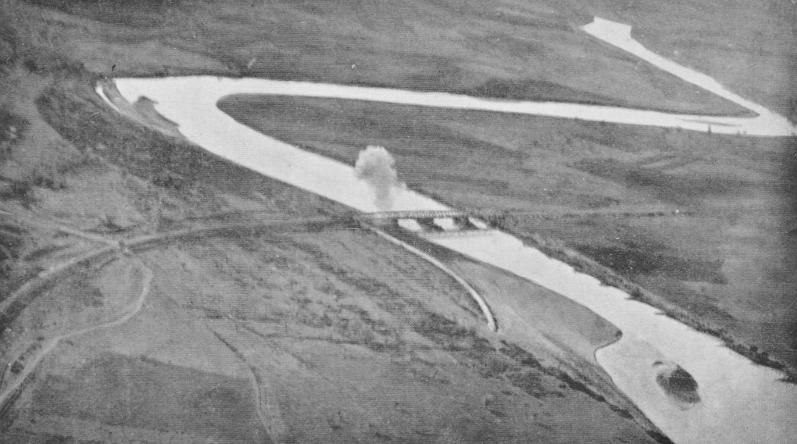
From 24th to 27th December RFC Upavon in Wiltshire has been performance testing Ruston Proctor built 110hp Clerget engined Sopwith “Strutter” A2391. The 10 page report is summarised in the charts below. Apparently RFC “Strutters” are still being delivered with Nieuport ring mountings not the much preferred Scarff gun ring.

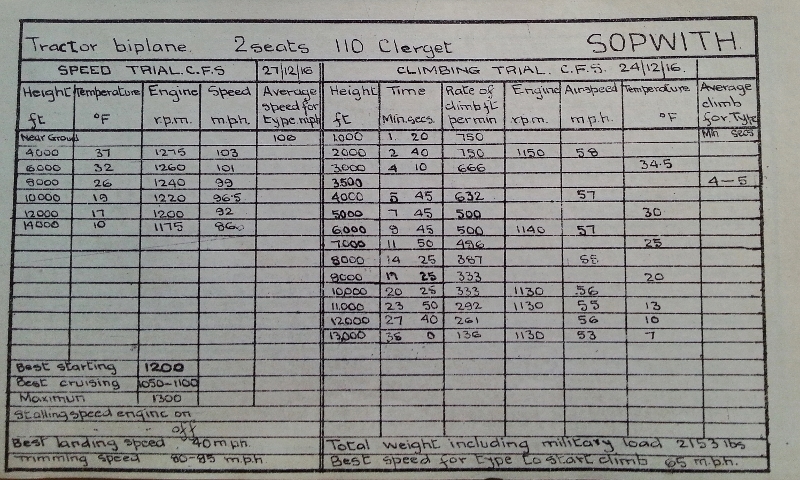
On 27th December as new “Triplanes” N5435 & 6 arrive at 1 (Naval) Squadron at Furnes, N5433 crashes in a ploughed field next to the aerodrome. On 28th December Sopwith’s first production “Triplane” N5420 crashes damaged beyond repair at St Omer but three more new “Triplanes” N5432, 4 & 7 arrive that day at St Pol.
On 30th December the fourth of ten Sopwith-built French “Triplanes” ordered in August is flown to join the French forces at Dunkirk whilst the fifth is at Dover for engine fitting before collection by French pilots. The photograph(below) shows the first three still wrongly marked as SP1 to 3.

On 31st December six RNAS 3 Wing “Strutter bomber” pilots down south at Luxeuil , five of them Canadians, find they are to join 3(Naval) Squadron by the end of January. Equipped with “Pups” this is to be one of the new RNAS fighter squadrons attached to the RFC on the Western Front.
On 31st December new Sopwith-built “Triplane” N5431 arrives disassembled at the RNAS Central Stores Depot at White City in preparation for shipping to the Aegean.
Sopwith started 1916 with “Schneider” or “Baby” floatplanes operating from RNAS Air Stations around the British coast and at Dunkirk, and from ships of the Royal Navy in the North Sea, the Aegean and with the Egyptian and East Indies Squadron. By the end of the year Sopwith machines have had a much more extensive impact on the war. The floatplane work continues but “Strutter” two-seat fighters have been successful with the RFC on the Somme and with the RNAS at Dunkirk and Luxeuil alongside the single seat “Strutter Bombers” attacking strategic installations. Single-seat “Pups” are proving to be valuable combat fighters in both the RNAS and RFC and “Triplanes” have started promising combat careers. The French have bought “Triplanes” and “Baby” floatplanes and have borrowed “Strutter bombers” which they are now building in large numbers in France. All of this looks likely to continue in 1917 but in much greater numbers.
With the successful introduction of these new designs, Sopwith have taken orders in the twelve months of 1916 for 406 new aircraft: 270 “Strutters”, 26 “Pups”, 88 “Triplanes” plus 20 “Daily Mail” and 2 “Special Baby” floatplanes. This is more than all their previous aircraft orders from November 1912 to December 1915 which amounted to 374. What is more, the success of their new types has created a demand way beyond their own manufacturing capacity mostly for the first time during the war from the Army’s Royal Flying Corps.
Until this year the only licence manufacture of Sopwith designed aircraft has been 30 “Type 806” Gunbuses by Robey in Lincoln. This year an astonishing 1,743 Sopwith machines have been ordered on fourteen other manufacturers, 1,472 of those for the RFC. The 2,149 Sopwith aircraft ordered on all manufacturers in 1916 is made up of 1282 “Strutters”, 386 “Pups”, 365 “Triplanes” plus 20 “Daily Mail” and 78 “Baby” floatplanes.
Sopwith’s works’ records show 17 “Strutters”, 1 “Pup” and 11 “Triplanes” completed in December making 30 with the “F1” prototype. These bring the total new aircraft built by Sopwith in 1916 to 374 although the Ministry of Munitions (MoM) figures indicate that it is 398 probably by acceptance of aircraft still in the works. This is a 99% increase on the 200 in 1915 and more than five times their output in 1914. Sopwith are still keeping up with their order intake and had it not been for the last minute orders for 100 RFC “Triplanes” and 20 “Daily Mail” floatplanes, Sopwith would once again go into a New Year with less than two months’ output on their books.
According to MoM records, ten other manufacturers have built 297 Sopwith designed aircraft in 1916 bringing the total new Sopwith aircraft to 695 in 1916, over 10% of the 6,633 aircraft delivered to both services. The 695 total new Sopwith aircraft in 1916 is made up of 4 ‘Spinning Jenny’, 19 ‘Gunbus’, 90 ‘Baby’ floatplanes, 451 ‘Strutters’, 93 ‘Pups’, 34 ‘Clerget Triplanes’, 3 larger experimental triplanes and a prototype ‘F1 Camel’. This leaves over 1,600 Sopwith machines on order in Britain on 1st January 1917, a significant 17% of the 9,400 total aircraft on order for both armed services.
Meanwhile the Sopwith design team are working on ever more advanced types starting with the “F1” fighter.
Other background information
The dramatic growth in military aviation since the start of the war is illustrated by these service numbers:
Royal Naval Air Service
August 1914 50 Officers, 550 other ranks, 93 aircraft & 7 airships
December 1916 2,764 Officers, 26,129 other ranks, 1,567 aircraft
Royal Flying Corps
August 1914 147 Officers, 1,097 other ranks, 179 aircraft
December 1916 5,982 Officers, 51,915 other ranks, 3,929 aircraft
In 1916 both services have contributed significantly to the war effort with more aircraft and better organised training but also with the help of improved methods and equipment. Great progress has been made with synchronised forward firing and ring mounted guns, gun sights, bomb release gear, reconnaissance cameras, wireless telegraphy, compasses, incendiary bullets and rocket armament. Improved procedures have been developed for combat patrols, artillery spotting, contact patrols reporting the positions of advancing troops to the artillery and protective formation flying on offensive patrols and strategic bombing raids. Improvements in Home Defence have brought some success in combating the Zeppelin menace. The Navy whilst supporting the RFC in France and boosting the defence of home waters, especially the English Channel, is progressing with a wide range of aeronautical experiments including flying wheeled aircraft from ships.
Photos & diagrams via Brooklands Museum Library and Archives, Fleet Air Arm Museum, RAF Museum, the National Archives and private collections of Philip Jarrett & Mike Goodall and others
Similar continuation webpages can be found under “Sopwith Day By Day” on this website for 1917 to 1920
A week by week diary of the Sopwith Aviation Company and its products through 1917

